ID: E20.7

Place:
House of Statistic, Berlin, Germany
Procedural part:
November 1 — 20, 2020
Exposition part:
November 20 — December 2, 2020
Idea, artist:
Sergey Shabohin
Project coordinators:
Zmicer Chartkou, Yauheni Fedarovich, Anna Limantava
Architects:
Volha Fedarenka-Habrus, Mikita Fedarenka
Videographer:
Artyom Goncharov
Contributors:
Anonymous, Vika Biran, Aliaksei Bratachkin, Mikhail Gulin, Volha Hapeyeva, Nicolai Khalezin, Alexey Kuzmich, Andrei Karpeka, Marina Naprushkina, Nadya Sayapina, Olga Shparaga, Antonina Stebur, Irina Sukhy, Vladimir Tsesler
Translators:
Lena Borries, Veronika Saniuk
Texting assistance:
Natallia Chaiko, Klim Kavaliou, Tanya Maistroff
Correction help:
Vladimir S.
Thanks:
Andrii Dostliev, Paul Milmeister, Stefan Paul, Andrey Tsyrulnikov, Pavel Zagalsky
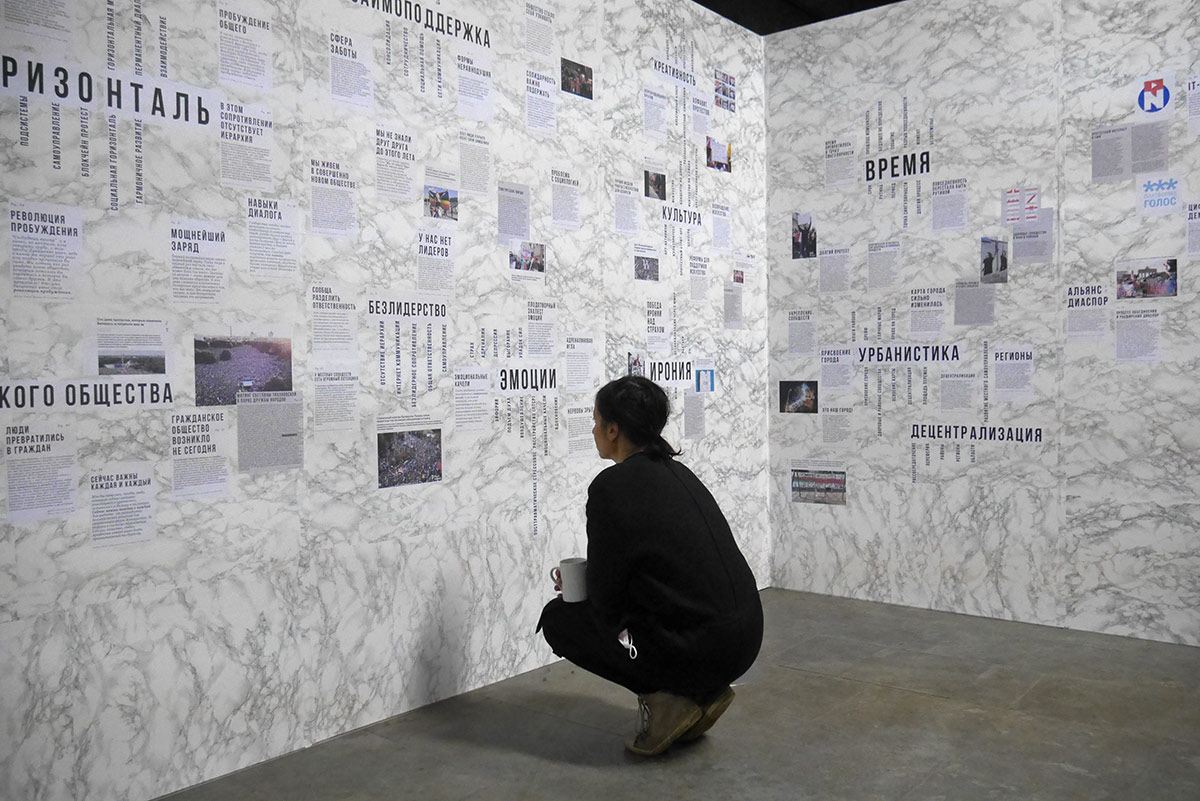
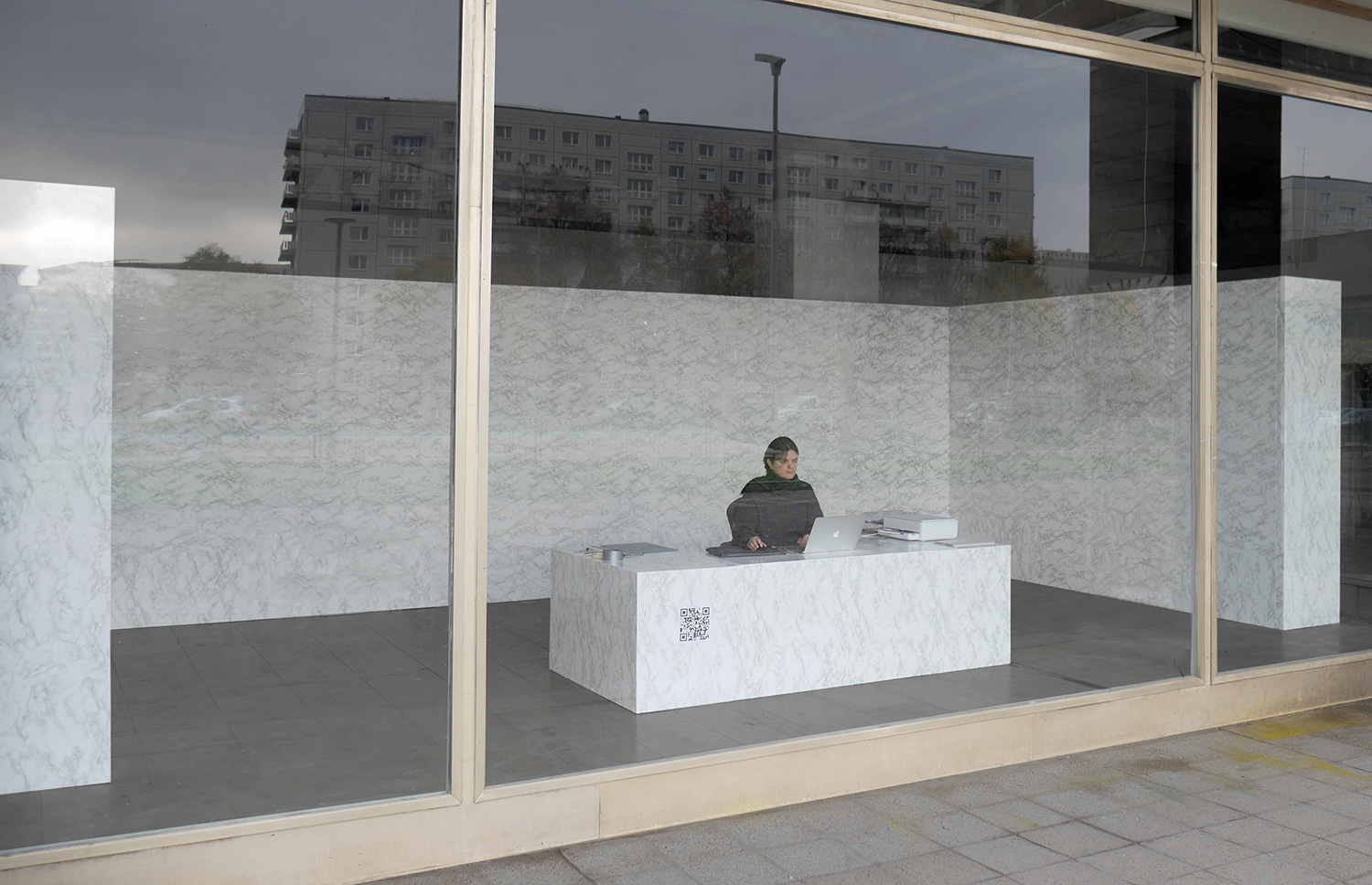

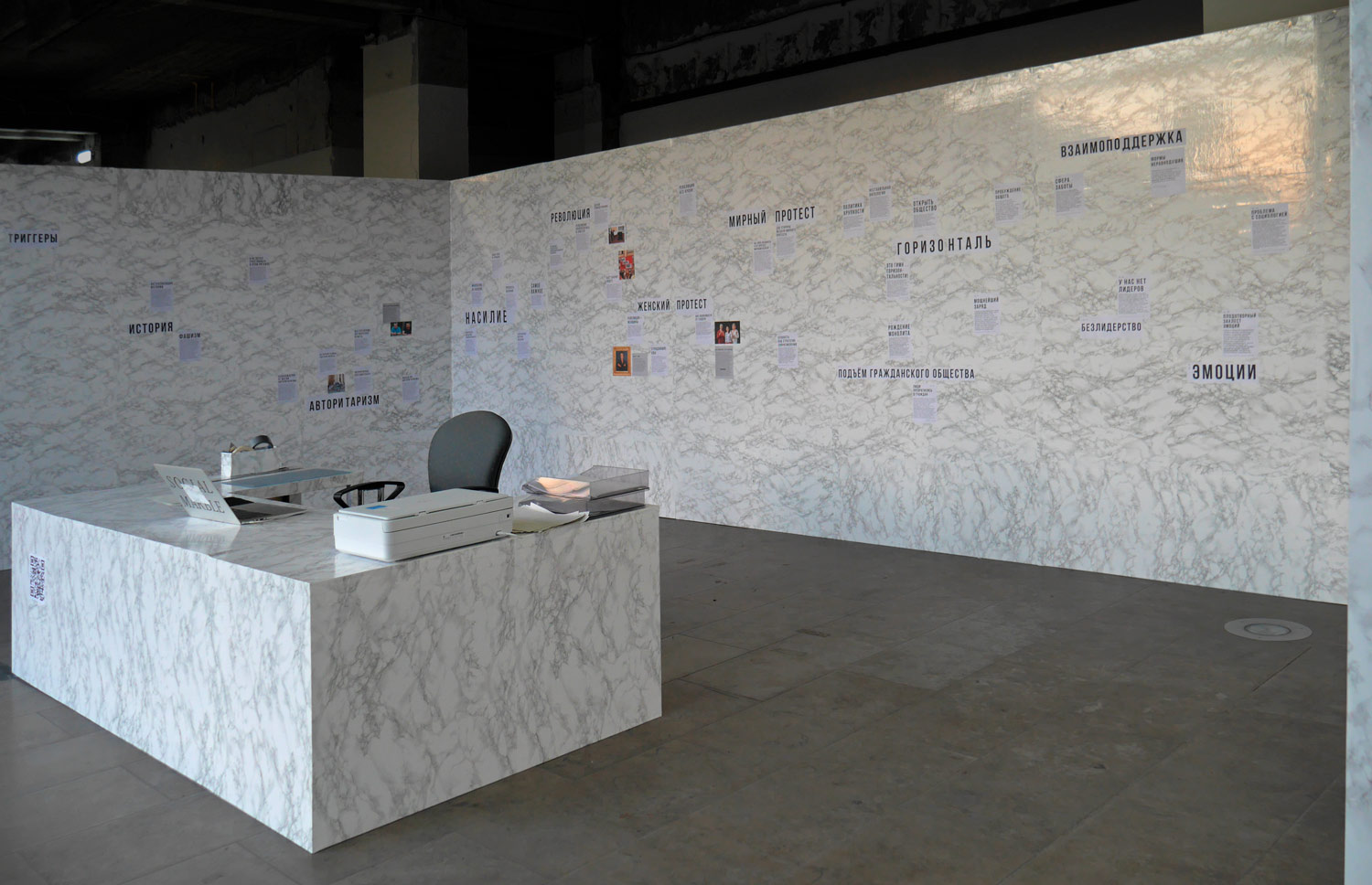
INDEX
Contents / содержаниеContributors / контрибьютор_ки:
[in alphabet order /
в алфавитном порядке]
Vika Biran
Fig. I6 / Quotes: J6 — P6Aliaksei Bratachkin
Fig. L3 / Quotes: M3 — A4Mikhail Gulin
Fig. R5 / Quotes: S5 — X5Volha Hapeyeva
Fig. H8 / Quotes: I8 — P8Anonymous
Fig. K5 / Quotes: L5 — Q5Andrei Karpeka
Fig. O7 / Quotes: P7 — U7Nicolai Khalezin
Fig. N4 / Quotes: O4 — Z4Alexey Kuzmich
Fig. A2 / Quotes: B2 — F2Marina Naprushkina
Fig. V7 / Quotes: W7 — G8Nadya Sayapina
Fig. U1 / Quotes: V1 — Z1Olga Shparaga
Fig. G1 / Quotes: H1 — S1Antonina Stebur
Fig. G2 / Quotes: H2 — P2Irina Sukhy
Fig. C5 / Quotes: D5 — J5Vladimir Tsesler
Fig. Q2 / Quotes: R2 — V2Вика Биран
Fig. I6 / Quotes: J6 — P6Алексей Браточкин
Fig. L3 / Quotes: M3 — A4Вольга Гапеева
Fig. H8 / Quotes: I8 — P8Михаил Гулин
Fig. R5 / Quotes: S5 — X5
Анонимно
Fig. K5 / Quotes: L5 — Q5
Андрей Карпека
Fig. O7 / Quotes: P7 — U7
Алексей Кузьмич
Fig. A2 / Quotes: B2 — F2Марина Напрушкина
Fig. V7 / Quotes: W7 — G8Надя Саяпина
Fig. U1 / Quotes: V1 — Z1Антонина Стебур
Fig. G2 / Quotes: H2 — P2Ирина Сухий
Fig. C5 / Quotes: D5 — J5Николай Халезин
Fig. N4 / Quotes: O4 — Z4Владимир Цеслер
Fig. Q2 / Quotes: R2 — V2Ольга Шпарага
Fig. G1 / Quotes: H1 — S1Ключевые слова:
Authoritarism
Fig. C3Creativity
Fig. H3Culture
Fig. Y5Decentralization
Fig. D4Emotions
Fig. C4History
Fig. F4Horizontal
Fig. T1Irony
Fig. F3Mutual support
Fig. B3New Forms
Fig. E3No Leadership
Fig. G3Peaceful Protest
Fig. X2Revolution
Fig. G4Technologies
Fig. W2The Rise of Civil Society
Fig. A3Time
Fig. B4Triggers
Fig. E4Urbanism
Fig. Z5Utopias
Fig. D3Violence
Fig. Y2Women's Protest
Fig. Z2Авторитаризм
Fig. C3Безлидерство
Fig. G3
Взаимоподдержка
Fig. B3Время
Fig. B4Горизонталь
Fig. T1Децентрализация
Fig. D4Женский протест
Fig. Z2Ирония
Fig. F3История
Fig. F4Креативность
Fig. H3Культура
Fig. Y5Мирный протест
Fig. X2Насилие
Fig. Y2Новые формы
Fig. E3Подъём гражданского общества
Fig. A3Революция
Fig. G4Технологии
Fig. W2Триггеры
Fig. E4Урбанистика
Fig. Z5Утопии
Fig. D3Эмоции
Fig. C4Ключевые даты:
Arrest and attempted deportation of Maria Kolesnikova from Belarus
Fig. D7Arrest of "Eva"
Fig. J3Arrest of Viktor Babariko
Fig. I3Integration of three headquarters
Fig. K3Internet and communication blockade
Fig. Z6Election Day
Fig. K7Escalation of violence 9 — 12 August
Fig. G7First solidarity action due to the arrest of Viktor Babariko
Fig. F7First women's protest action at Komarovsky Market
Fig. A5March of Freedom — the first mass march
Fig. J4Murder of Roman Bondarenko
Fig. D6Secret Self-Inauguration
Fig. K4Svetlana Tikhanovskaya's rally in Friendship of Nations Park
Fig. J7
Арест Виктора Бабарико
Fig. I3Арест “Евы”
Fig. J3Арест и попытка выдворения из Беларуси Марии Колесниковой
Fig. D7Блокировка интернета и связи
Fig. Z6День выборов
Fig. K7Марш свободы — первый массовый марш
Fig. J4Митинг Светланы Тихановской в парке Дружбы народов
Fig. J7Объединение трёх штабов
Fig. K3Первая акция протестов женщин у Комаровcкого рынка
Fig. A5Первая акция солидарности из-за ареста Виктора Бабарико
Fig. F7Тайная самоинагурация
Fig. K4Убийство Романа Бондаренко
Fig. D6Эскалация насилия 9 — 12 августа
Fig. G7Ключевые символы:
3%
Fig. Y6Coordination Council
Fig. E7Cultural protest
Fig. Q6Sunday marches
Fig. W6Courtyard communities and district flags
Fig. G6March slogans
Fig. X6Nina Baginskaya: I'm Walking!
Fig. R6Protest internet and media
Fig. N7Strikes and ultimatums
Fig. L7Stop the Cockroach!
Fig. A7Square of Changes and DJ booth
Fig. L4Thematic marches
Fig. C7Victims of violence
Fig. I7White Ribbon
Fig. B5White-red-white flag and "Pahonia" coat of arms
Fig. T6Women's protest actions
Fig. B7#EVAlution
Fig. M4#yabac’ka
Fig. S63%
Fig. Y6Белая лента
Fig. B5Бело-красно-белый флаг и герб “Погоня”
Fig. T6Воскресные марши
Fig. W6Дворовые сообщества и флаги районов
Fig. G6#ЕВАлюция
Fig. M4Женские акции протеста
Fig. B7Жертвы насилия
Fig. I7Забастовки и ультиматум
Fig. L7Координационный совет
Fig. E7Культпротест
Fig. Q6Лозунги маршей
Fig. X6Нина Багинская: Я гуляю!
Fig. R6Площадь перемен и будка диджеев
Fig. L4Протестный интернет и СМИ
Fig. N7Стоп таракан!
Fig. A7Тематические марши
Fig. C7#ябатька
Fig. S6Ключевые тригеры:
COVID-19
Fig. H7Disappearance of Politicians
Fig. F6Economic Crises and Devaluations
Fig. H2Referendums in Belarus
Fig. E6Squares 2006 and 2010
Fig. M7COVID-19
Fig. H7Исчезновение политиков
Fig. F6Площади 2006 и 2010 годов
Fig. M7Референдумы в Беларуси
Fig. E6Экономические кризисы и девальвации
Fig. H2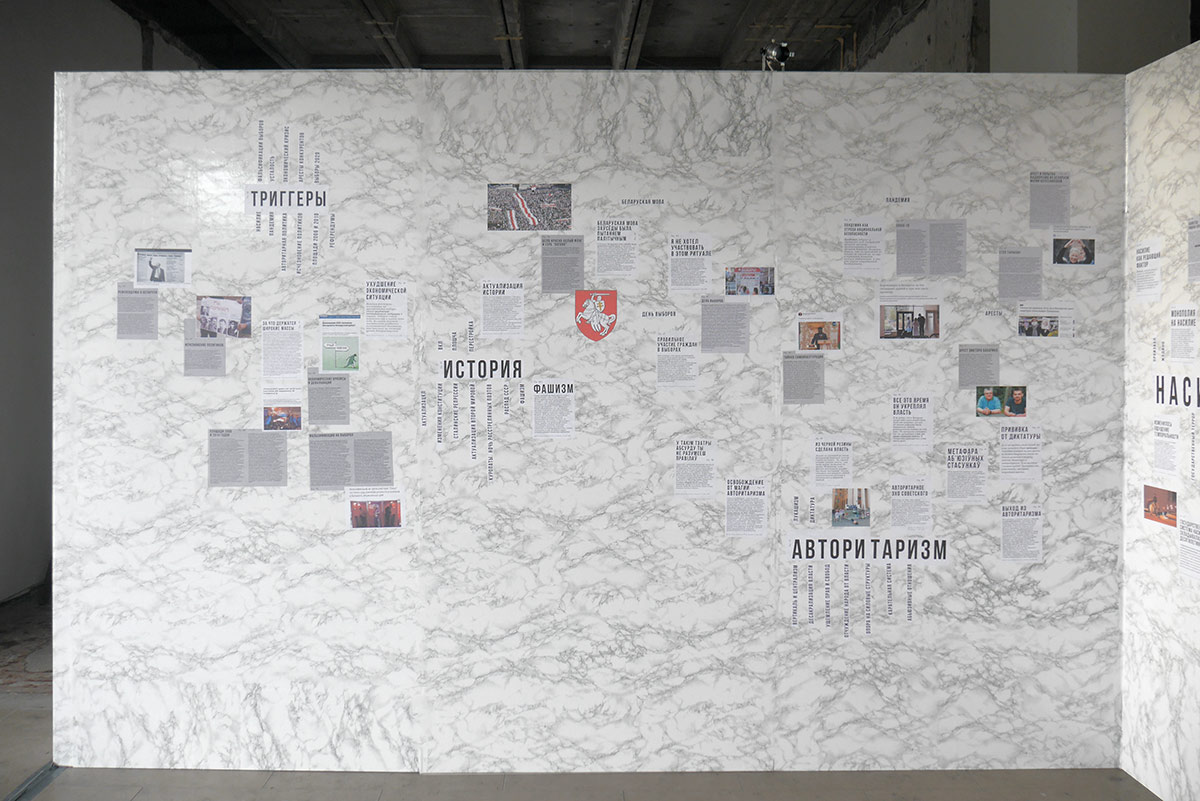
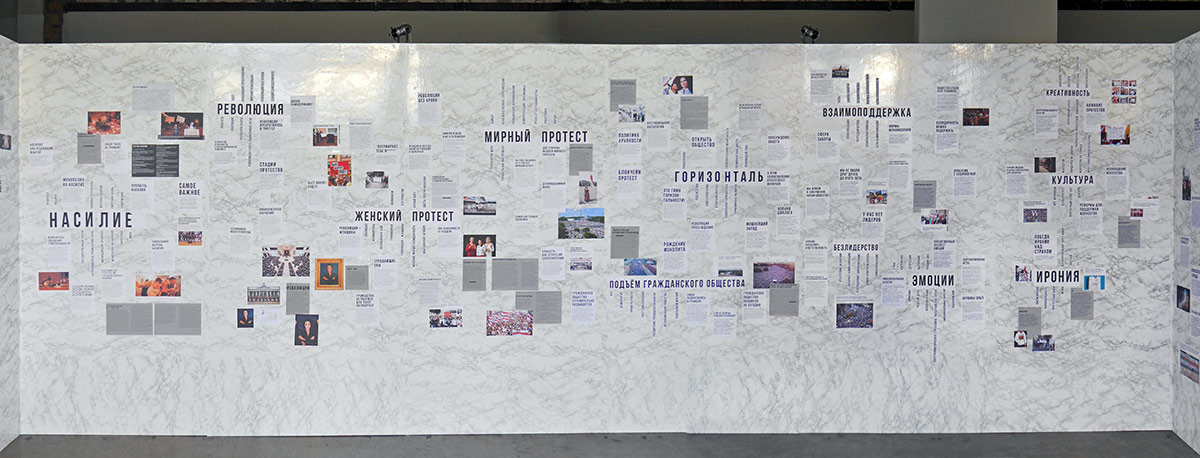
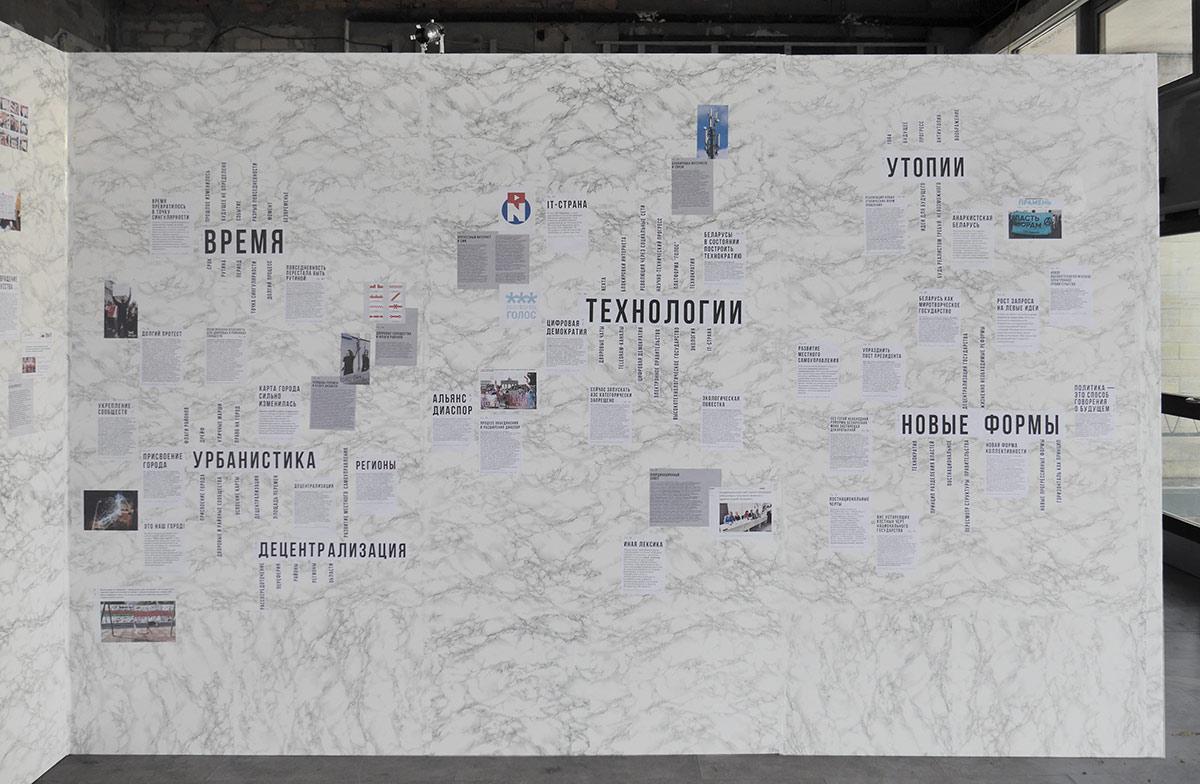
Register
File index
Image
Description in English
Описание на кириллице
1
Fig. A1
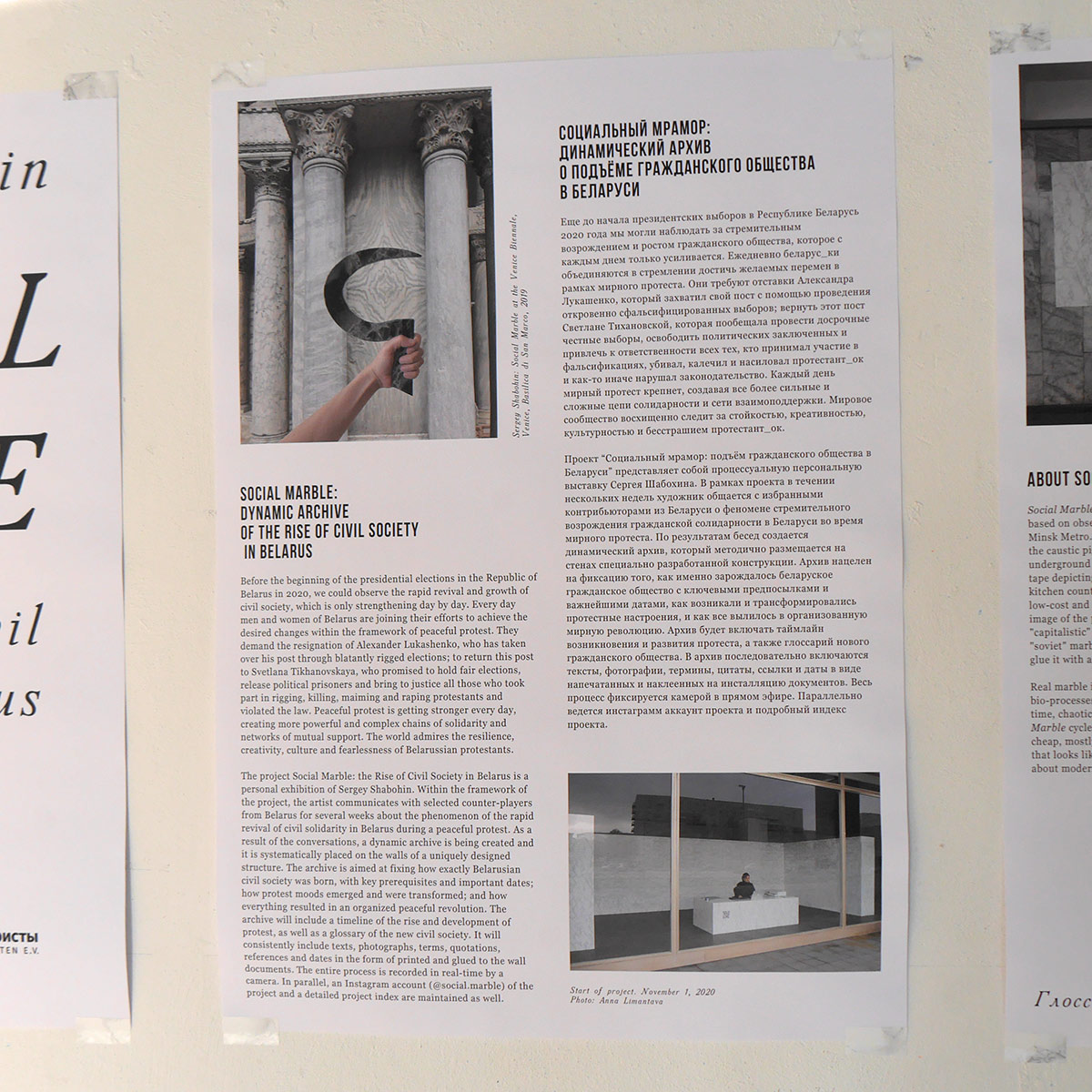
Project Announcement
Before the beginning of the presidential elections in the Republic of Belarus in 2020, we could observe the rapid revival and growth of civil society, which is only strengthening day by day. Every day men and women of Belarus are joining their efforts to achieve the desired changes within the framework of peaceful protest. They demand the resignation of Alexander Lukashenko, who has taken over his post through blatantly rigged elections; to return this post to Svetlana Tikhanovskaya, who promised to hold fair elections, release political prisoners and bring to justice all those who took part in rigging, killing, maiming and raping protestants and violated the law. Peaceful protest is getting stronger every day, creating more powerful and complex chains of solidarity and networks of mutual support. The world admires the resilience, creativity, culture and fearlessness of Belarussian protestants.
The project Social Marble: the Rise of Civil Society in Belarus is a personal exhibition of Sergey Shabohin. Within the framework of the project, the artist communicates with selected counter-players from Belarus for several weeks about the phenomenon of the rapid revival of civil solidarity in Belarus during a peaceful protest. As a result of the conversations, a dynamic archive is being created and it is systematically placed on the walls of a uniquely designed structure. The archive is aimed at fixing how exactly Belarusian civil society was born, with key prerequisites and important dates; how protest moods emerged and were transformed; and how everything resulted in an organized peaceful revolution. The archive will include a timeline of the rise and development of protest, as well as a glossary of the new civil society. It will consistently include texts, photographs, terms, quotations, references and dates in the form of printed and glued to the wall documents. The entire process is recorded in real-time by a camera. In parallel, an Instagram account (@social.marble) of the project and a detailed project index are maintained as well.
Social Marble: Dynamic Archive of the Rise of Civil Society in Belarus
Before the beginning of the presidential elections in the Republic of Belarus in 2020, we could observe the rapid revival and growth of civil society, which is only strengthening day by day. Every day men and women of Belarus are joining their efforts to achieve the desired changes within the framework of peaceful protest. They demand the resignation of Alexander Lukashenko, who has taken over his post through blatantly rigged elections; to return this post to Svetlana Tikhanovskaya, who promised to hold fair elections, release political prisoners and bring to justice all those who took part in rigging, killing, maiming and raping protestants and violated the law. Peaceful protest is getting stronger every day, creating more powerful and complex chains of solidarity and networks of mutual support. The world admires the resilience, creativity, culture and fearlessness of Belarussian protestants.
The project Social Marble: the Rise of Civil Society in Belarus is a personal exhibition of Sergey Shabohin. Within the framework of the project, the artist communicates with selected counter-players from Belarus for several weeks about the phenomenon of the rapid revival of civil solidarity in Belarus during a peaceful protest. As a result of the conversations, a dynamic archive is being created and it is systematically placed on the walls of a uniquely designed structure. The archive is aimed at fixing how exactly Belarusian civil society was born, with key prerequisites and important dates; how protest moods emerged and were transformed; and how everything resulted in an organized peaceful revolution. The archive will include a timeline of the rise and development of protest, as well as a glossary of the new civil society. It will consistently include texts, photographs, terms, quotations, references and dates in the form of printed and glued to the wall documents. The entire process is recorded in real-time by a camera. In parallel, an Instagram account (@social.marble) of the project and a detailed project index are maintained as well.
Анонс проекта
Еще до начала президентских выборов в Республике Беларусь 2020 года мы могли наблюдать за стремительным возрождением и ростом гражданского общества, которое с каждым днем только усиливается. Ежедневно беларус_ки объединяются в стремлении достичь желаемых перемен в рамках мирного протеста. Они требуют отставки Александра Лукашенко, который захватил свой пост с помощью проведения откровенно сфальсифицированных выборов; вернуть этот пост Светлане Тихановской, которая пообещала провести досрочные честные выборы, освободить политических заключенных и привлечь к ответственности всех тех, кто принимал участие в фальсификациях, убивал, калечил и насиловал протестант_ок и как-то иначе нарушал законодательство. Каждый день мирный протест крепнет, создавая все более сильные и сложные цепи солидарности и сети взаимоподдержки. Мировое сообщество восхищенно следит за стойкостью, креативностью, культурностью и бесстрашием протестант_ок.
Проект “Социальный мрамор: подъём гражданского общества в Беларуси” представляет собой процессуальную персональную выставку Сергея Шабохина. В рамках проекта в течении нескольких недель художник общается с избранными контрибьюторами из Беларуси о феномене стремительного возрождения гражданской солидарности в Беларуси во время мирного протеста. По результатам бесед создается динамический архив, который методично размещается на стенах специально разработанной конструкции. Архив нацелен на фиксацию того, как именно зарождалось беларуское гражданское общество с ключевыми предпосылками и важнейшими датами, как возникали и трансформировались протестные настроения, и как все вылилось в организованную мирную революцию. Архив будет включать таймлайн возникновения и развития протеста, а также глоссарий нового гражданского общества. В архив последовательно включаются тексты, фотографии, термины, цитаты, ссылки и даты в виде напечатанных и наклеенных на инсталляцию документов. Весь процесс фиксируется камерой в прямом эфире. Параллельно ведется инстаграмм аккаунт проекта и подробный индекс проекта.
Социальный мрамор: динамический архив о подъёме гражданского общества в Беларуси
Еще до начала президентских выборов в Республике Беларусь 2020 года мы могли наблюдать за стремительным возрождением и ростом гражданского общества, которое с каждым днем только усиливается. Ежедневно беларус_ки объединяются в стремлении достичь желаемых перемен в рамках мирного протеста. Они требуют отставки Александра Лукашенко, который захватил свой пост с помощью проведения откровенно сфальсифицированных выборов; вернуть этот пост Светлане Тихановской, которая пообещала провести досрочные честные выборы, освободить политических заключенных и привлечь к ответственности всех тех, кто принимал участие в фальсификациях, убивал, калечил и насиловал протестант_ок и как-то иначе нарушал законодательство. Каждый день мирный протест крепнет, создавая все более сильные и сложные цепи солидарности и сети взаимоподдержки. Мировое сообщество восхищенно следит за стойкостью, креативностью, культурностью и бесстрашием протестант_ок.
Проект “Социальный мрамор: подъём гражданского общества в Беларуси” представляет собой процессуальную персональную выставку Сергея Шабохина. В рамках проекта в течении нескольких недель художник общается с избранными контрибьюторами из Беларуси о феномене стремительного возрождения гражданской солидарности в Беларуси во время мирного протеста. По результатам бесед создается динамический архив, который методично размещается на стенах специально разработанной конструкции. Архив нацелен на фиксацию того, как именно зарождалось беларуское гражданское общество с ключевыми предпосылками и важнейшими датами, как возникали и трансформировались протестные настроения, и как все вылилось в организованную мирную революцию. Архив будет включать таймлайн возникновения и развития протеста, а также глоссарий нового гражданского общества. В архив последовательно включаются тексты, фотографии, термины, цитаты, ссылки и даты в виде напечатанных и наклеенных на инсталляцию документов. Весь процесс фиксируется камерой в прямом эфире. Параллельно ведется инстаграмм аккаунт проекта и подробный индекс проекта.
Fig. B1

Glossary Social Marble #1
About Social Marble
Social Marble is the title of a series of works by Sergey Shabohin based on observations of the practice of cleaning services of the Minsk Metro. The workers of this service are unable to wash away the caustic pigments of graffiti applied on the marble walls of underground tunnels in the metro and began glueing them with a tape depicting the marble texture. This tape is often used to protect kitchen countertops, shop counters and other items — it is a low-cost and affordable "social marble". This symbol has a strong image of the political structure of modern Belarus, where intrusive "capitalistic" pigments of aerosols are so deeply absorbed into "soviet" marble that they cannot be washed away and one can only glue it with a chinese tape.
Real marble in its structure is the result of complex geo- and bio-processes that are similar in their regularity and, at the same time, chaotic nature with social processes. As part of the Social Marble cycle, objects, installations and sculptures are created from cheap, mostly hollow, materials and are glued together with a tape that looks like a marble. Pretending to be marble these objects tell about modern myths of Belarus and historical fairies.
About Social Marble
Social Marble is the title of a series of works by Sergey Shabohin based on observations of the practice of cleaning services of the Minsk Metro. The workers of this service are unable to wash away the caustic pigments of graffiti applied on the marble walls of underground tunnels in the metro and began glueing them with a tape depicting the marble texture. This tape is often used to protect kitchen countertops, shop counters and other items — it is a low-cost and affordable "social marble". This symbol has a strong image of the political structure of modern Belarus, where intrusive "capitalistic" pigments of aerosols are so deeply absorbed into "soviet" marble that they cannot be washed away and one can only glue it with a chinese tape.
Real marble in its structure is the result of complex geo- and bio-processes that are similar in their regularity and, at the same time, chaotic nature with social processes. As part of the Social Marble cycle, objects, installations and sculptures are created from cheap, mostly hollow, materials and are glued together with a tape that looks like a marble. Pretending to be marble these objects tell about modern myths of Belarus and historical fairies.
Глоссарий “Социальный мрамор” #1
О социальном мраморе
“Социальный мрамор” — так называется цикл произведений Сергея Шабохина основанный на наблюдениях за практикой службы уборки минского метрополитена. Не в силах смыть едкие пигменты граффити, нанесенные на мраморные стены подземных переходов в метро, работники этой службы стали заклеивать их пленкой с изображением мраморной текстуры. Такую пленку часто используют для защиты кухонных столешниц, магазинных прилавков и других предметов — это бюджетный и доступный всем “социальный мрамор”. В этом символе есть емкий образ политического устройства современной Беларуси, где въедливые “капиталистические” пигменты аэрозолей так глубоко впитываются в “советский” мрамор, что их нельзя смыть, и остается только заклеивать пленкой китайского производства.
Настоящий мрамор по своей структуре — результат сложных гео- и био-процессов, схожих по своей регулярности и, одновременно, хаотичности с социальными. В рамках цикла “Социальный мрамор” объекты, инсталляции и скульптуры создаются из дешевых, чаще всего полых материалов, и оклеиваются пленкой с мраморным рисунком. Эти объекты притворяются мраморными и рассказывают о современных мифах Беларуси и исторических фэйках.
О социальном мраморе
“Социальный мрамор” — так называется цикл произведений Сергея Шабохина основанный на наблюдениях за практикой службы уборки минского метрополитена. Не в силах смыть едкие пигменты граффити, нанесенные на мраморные стены подземных переходов в метро, работники этой службы стали заклеивать их пленкой с изображением мраморной текстуры. Такую пленку часто используют для защиты кухонных столешниц, магазинных прилавков и других предметов — это бюджетный и доступный всем “социальный мрамор”. В этом символе есть емкий образ политического устройства современной Беларуси, где въедливые “капиталистические” пигменты аэрозолей так глубоко впитываются в “советский” мрамор, что их нельзя смыть, и остается только заклеивать пленкой китайского производства.
Настоящий мрамор по своей структуре — результат сложных гео- и био-процессов, схожих по своей регулярности и, одновременно, хаотичности с социальными. В рамках цикла “Социальный мрамор” объекты, инсталляции и скульптуры создаются из дешевых, чаще всего полых материалов, и оклеиваются пленкой с мраморным рисунком. Эти объекты притворяются мраморными и рассказывают о современных мифах Беларуси и исторических фэйках.
Fig. C1
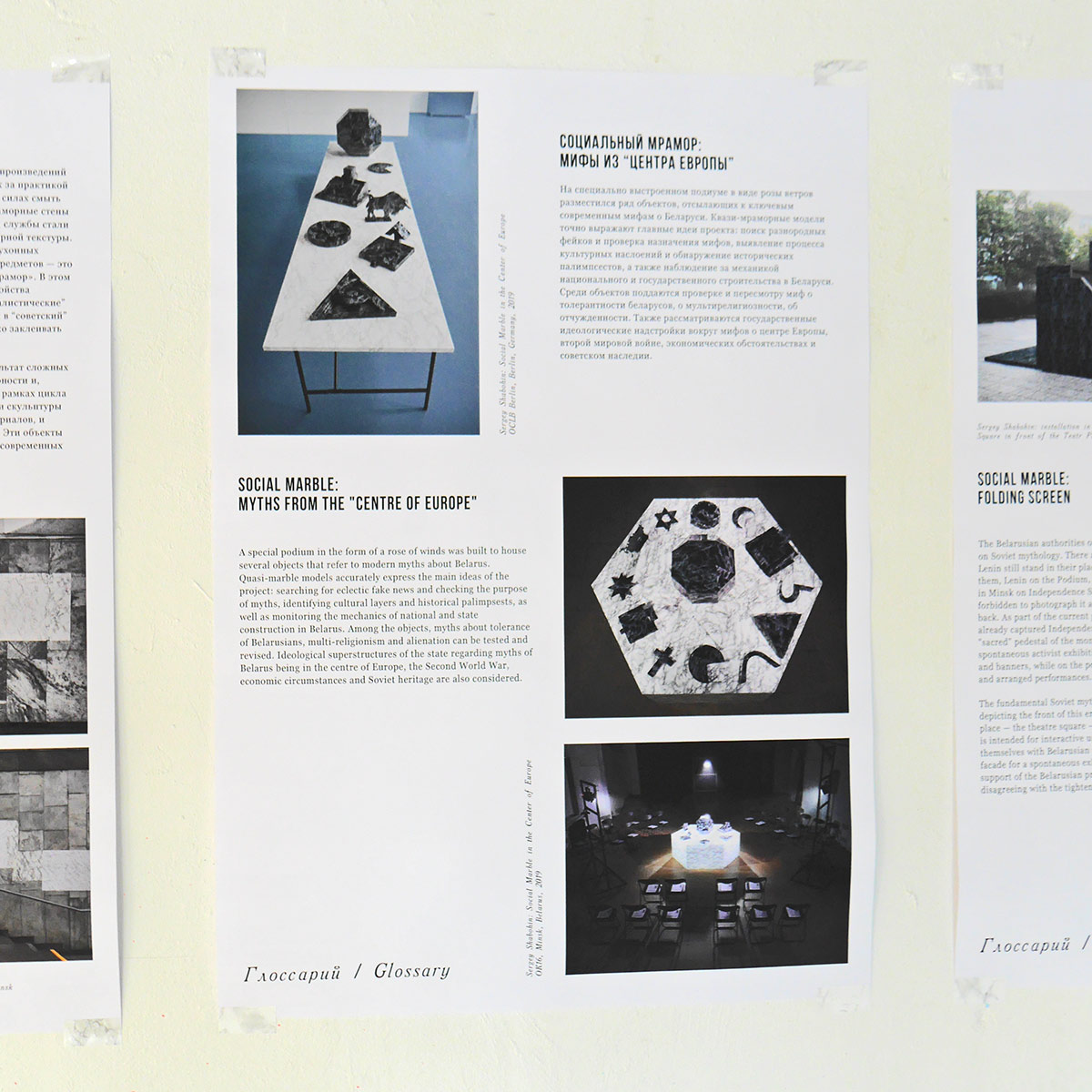
Glossary Social Marble #2
A special podium in the form of a rose of winds was built to house several objects that refer to modern myths about Belarus. Quasi-marble models accurately express the main ideas of the project: searching for eclectic fake news and checking the purpose of myths, identifying cultural layers and historical palimpsests, as well as monitoring the mechanics of national and state construction in Belarus. Among the objects, myths about tolerance of Belarusians, multi-religionism and alienation can be tested and revised. Ideological superstructures of the state regarding myths of Belarus being in the centre of Europe, the Second World War, economic circumstances and Soviet heritage are also considered.
Social Marble: Myths from the "Centre of Europe"
A special podium in the form of a rose of winds was built to house several objects that refer to modern myths about Belarus. Quasi-marble models accurately express the main ideas of the project: searching for eclectic fake news and checking the purpose of myths, identifying cultural layers and historical palimpsests, as well as monitoring the mechanics of national and state construction in Belarus. Among the objects, myths about tolerance of Belarusians, multi-religionism and alienation can be tested and revised. Ideological superstructures of the state regarding myths of Belarus being in the centre of Europe, the Second World War, economic circumstances and Soviet heritage are also considered.
Глоссарий “Социальный мрамор” #2
Социальный мрамор: мифы из “центра Европы”
На специально выстроенном подиуме в виде розы ветров разместился ряд объектов, отсылающих к ключевым современным мифам о Беларуси. Квази-мраморные модели точно выражают главные идеи проекта: поиск разнородных фейков и проверка назначения мифов, выявление процесса культурных наслоений и обнаружение исторических палимпсестов, а также наблюдение за механикой национального и государственного строительства в Беларуси. Среди объектов поддаются проверке и пересмотру миф о толерантности беларусов, о мультирелигиозности, об отчужденности. Также рассматриваются государственные идеологические надстройки вокруг мифов о центре Европы, второй мировой войне, экономических обстоятельствах и советском наследии.
Социальный мрамор: мифы из “центра Европы”
На специально выстроенном подиуме в виде розы ветров разместился ряд объектов, отсылающих к ключевым современным мифам о Беларуси. Квази-мраморные модели точно выражают главные идеи проекта: поиск разнородных фейков и проверка назначения мифов, выявление процесса культурных наслоений и обнаружение исторических палимпсестов, а также наблюдение за механикой национального и государственного строительства в Беларуси. Среди объектов поддаются проверке и пересмотру миф о толерантности беларусов, о мультирелигиозности, об отчужденности. Также рассматриваются государственные идеологические надстройки вокруг мифов о центре Европы, второй мировой войне, экономических обстоятельствах и советском наследии.
Fig. D1
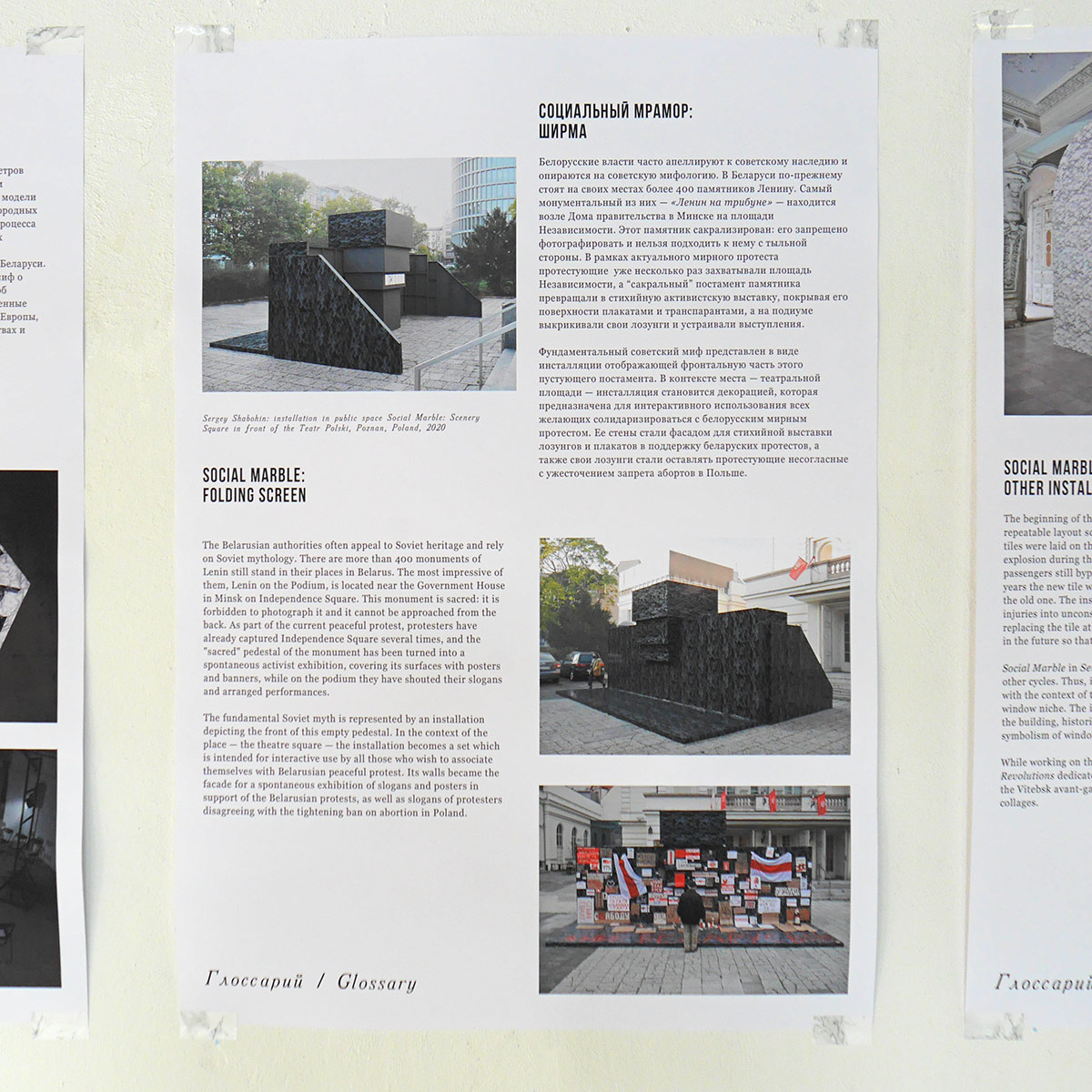
Glossary Social Marble #3
The Belarusian authorities often appeal to Soviet heritage and rely on Soviet mythology. There are more than 400 monuments of Lenin still stand in their places in Belarus. The most impressive of them, Lenin on the Podium, is located near the Government House in Minsk on Independence Square. This monument is sacred: it is forbidden to photograph it and it cannot be approached from the back. As part of the current peaceful protest, protesters have already captured Independence Square several times, and the "sacred" pedestal of the monument has been turned into a spontaneous activist exhibition, covering its surfaces with posters and banners, while on the podium they have shouted their slogans and arranged performances.
The fundamental Soviet myth is represented by an installation depicting the front of this empty pedestal. In the context of the place — the theatre square — the installation becomes a set which is intended for interactive use by all those who wish to associate themselves with Belarusian peaceful protest. Its walls became the facade for a spontaneous exhibition of slogans and posters in support of the Belarusian protests, as well as slogans of protesters disagreeing with the tightening ban on abortion in Poland.
Social Marble: Folding Screen
The Belarusian authorities often appeal to Soviet heritage and rely on Soviet mythology. There are more than 400 monuments of Lenin still stand in their places in Belarus. The most impressive of them, Lenin on the Podium, is located near the Government House in Minsk on Independence Square. This monument is sacred: it is forbidden to photograph it and it cannot be approached from the back. As part of the current peaceful protest, protesters have already captured Independence Square several times, and the "sacred" pedestal of the monument has been turned into a spontaneous activist exhibition, covering its surfaces with posters and banners, while on the podium they have shouted their slogans and arranged performances.
The fundamental Soviet myth is represented by an installation depicting the front of this empty pedestal. In the context of the place — the theatre square — the installation becomes a set which is intended for interactive use by all those who wish to associate themselves with Belarusian peaceful protest. Its walls became the facade for a spontaneous exhibition of slogans and posters in support of the Belarusian protests, as well as slogans of protesters disagreeing with the tightening ban on abortion in Poland.
Глоссарий “Социальный мрамор” #3
Социальный мрамор: ширма
Белорусские власти часто апеллируют к советскому наследию и опираются на советскую мифологию. В Беларуси по-прежнему стоят на своих местах более 400 памятников Ленину. Самый монументальный из них — «Ленин на трибуне» — находится возле Дома правительства в Минске на площади Независимости. Этот памятник сакрализирован: его запрещено фотографировать и нельзя подходить к нему с тыльной стороны. В рамках актуального мирного протеста протестующие уже несколько раз захватывали площадь Независимости, а “сакральный” постамент памятника превращали в стихийную активистскую выставку, покрывая его поверхности плакатами и транспарантами, а на подиуме выкрикивали свои лозунги и устраивали выступления.
Фундаментальный советский миф представлен в виде инсталляции отображающей фронтальную часть этого пустующего постамента. В контексте места — театральной площади — инсталляция становится декорацией, которая предназначена для интерактивного использования всех желающих солидаризироваться с белорусским мирным протестом. Ее стены стали фасадом для стихийной выставки лозунгов и плакатов в поддержку беларуских протестов, а также свои лозунги стали оставлять протестующие несогласные с ужесточением запрета абортов в Польше.
Социальный мрамор: ширма
Белорусские власти часто апеллируют к советскому наследию и опираются на советскую мифологию. В Беларуси по-прежнему стоят на своих местах более 400 памятников Ленину. Самый монументальный из них — «Ленин на трибуне» — находится возле Дома правительства в Минске на площади Независимости. Этот памятник сакрализирован: его запрещено фотографировать и нельзя подходить к нему с тыльной стороны. В рамках актуального мирного протеста протестующие уже несколько раз захватывали площадь Независимости, а “сакральный” постамент памятника превращали в стихийную активистскую выставку, покрывая его поверхности плакатами и транспарантами, а на подиуме выкрикивали свои лозунги и устраивали выступления.
Фундаментальный советский миф представлен в виде инсталляции отображающей фронтальную часть этого пустующего постамента. В контексте места — театральной площади — инсталляция становится декорацией, которая предназначена для интерактивного использования всех желающих солидаризироваться с белорусским мирным протестом. Ее стены стали фасадом для стихийной выставки лозунгов и плакатов в поддержку беларуских протестов, а также свои лозунги стали оставлять протестующие несогласные с ужесточением запрета абортов в Польше.
Fig. E1
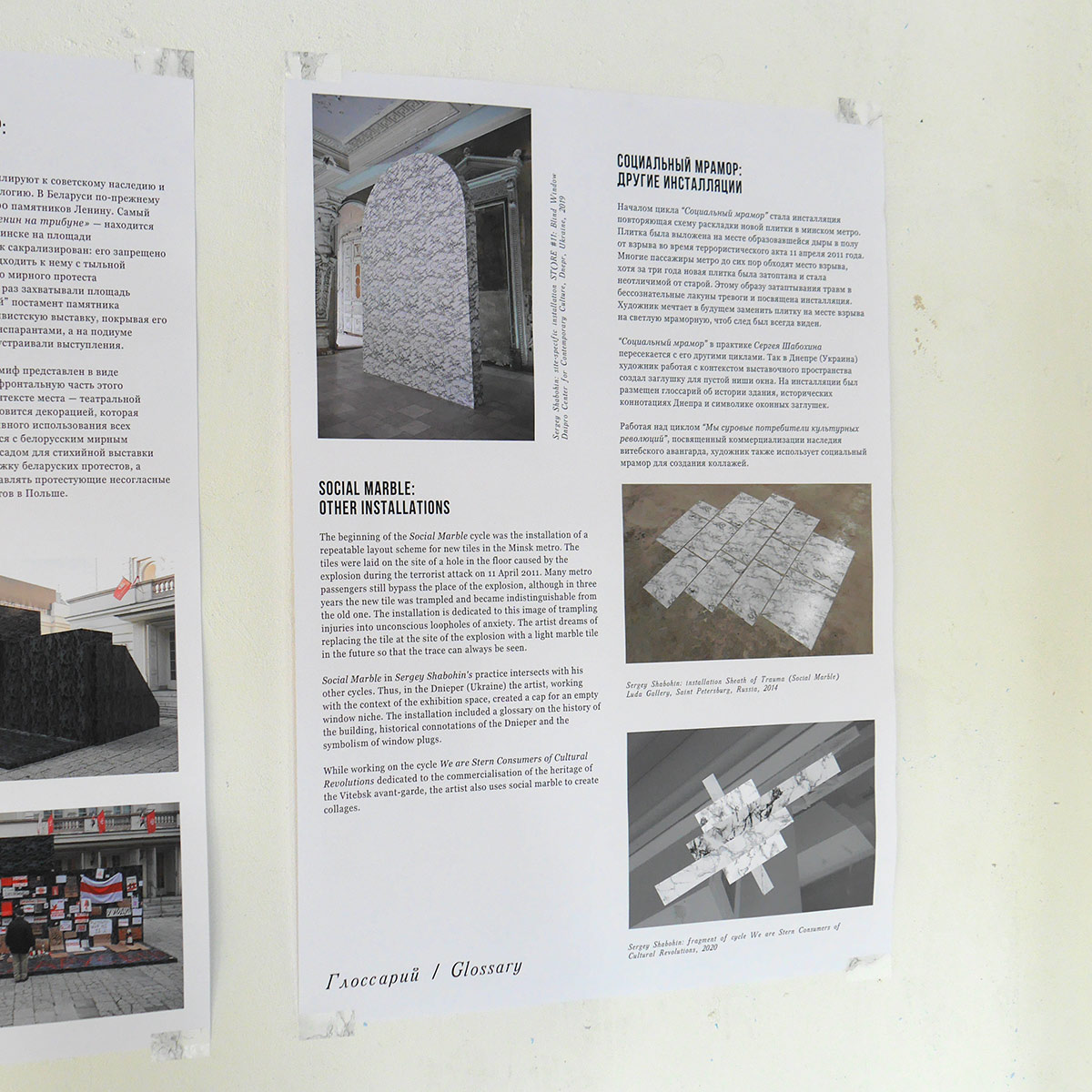
Glossary Social Marble #4
Social Marble: Other Installations
The beginning of the Social Marble cycle was the installation of a repeatable layout scheme for new tiles in the Minsk metro. The tiles were laid on the site of a hole in the floor caused by the explosion during the terrorist attack on 11 April 2011. Many metro passengers still bypass the place of the explosion, although in three years the new tile was trampled and became indistinguishable from the old one. The installation is dedicated to this image of trampling injuries into unconscious loopholes of anxiety. The artist dreams of replacing the tile at the site of the explosion with a light marble tile in the future so that the trace can always be seen.
Social Marble in Sergey Shabohin's practice intersects with his other cycles. Thus, in the Dnieper (Ukraine) the artist, working with the context of the exhibition space, created a cap for an empty window niche. The installation included a glossary on the history of the building, historical connotations of the Dnieper and the symbolism of window plugs.
While working on the cycle We are Stern Consumers of Cultural Revolutions dedicated to the commercialisation of the heritage of the Vitebsk avant-garde, the artist also uses social marble to create collages.
Social Marble: Other Installations
The beginning of the Social Marble cycle was the installation of a repeatable layout scheme for new tiles in the Minsk metro. The tiles were laid on the site of a hole in the floor caused by the explosion during the terrorist attack on 11 April 2011. Many metro passengers still bypass the place of the explosion, although in three years the new tile was trampled and became indistinguishable from the old one. The installation is dedicated to this image of trampling injuries into unconscious loopholes of anxiety. The artist dreams of replacing the tile at the site of the explosion with a light marble tile in the future so that the trace can always be seen.
Social Marble in Sergey Shabohin's practice intersects with his other cycles. Thus, in the Dnieper (Ukraine) the artist, working with the context of the exhibition space, created a cap for an empty window niche. The installation included a glossary on the history of the building, historical connotations of the Dnieper and the symbolism of window plugs.
While working on the cycle We are Stern Consumers of Cultural Revolutions dedicated to the commercialisation of the heritage of the Vitebsk avant-garde, the artist also uses social marble to create collages.
Глоссарий “Социальный мрамор” #4
Социальный мрамор: другие инсталляции
Началом цикла “Социальный мрамор” стала инсталляция повторяющая схему раскладки новой плитки в минском метро. Плитка была выложена на месте образовавшейся дыры в полу от взрыва во время террористического акта 11 апреля 2011 года. Многие пассажиры метро до сих пор обходят место взрыва, хотя за три года новая плитка была затоптана и стала неотличимой от старой. Этому образу затаптывания травм в бессознательные лакуны тревоги и посвящена инсталляция. Художник мечтает в будущем заменить плитку на месте взрыва на светлую мраморную, чтоб след был всегда виден.
“Социальный мрамор” в практике Сергея Шабохина пересекается с его другими циклами. Так в Днепре (Украина) художник работая с контекстом выставочного пространства создал заглушку для пустой ниши окна. На инсталляции был размещен глоссарий об истории здания, исторических коннотациях Днепра и символике оконных заглушек.
Работая над циклом “Мы суровые потребители культурных революций”, посвященный коммерциализации наследия витебского авангарда, художник также использует социальный мрамор для создания коллажей.
Социальный мрамор: другие инсталляции
Началом цикла “Социальный мрамор” стала инсталляция повторяющая схему раскладки новой плитки в минском метро. Плитка была выложена на месте образовавшейся дыры в полу от взрыва во время террористического акта 11 апреля 2011 года. Многие пассажиры метро до сих пор обходят место взрыва, хотя за три года новая плитка была затоптана и стала неотличимой от старой. Этому образу затаптывания травм в бессознательные лакуны тревоги и посвящена инсталляция. Художник мечтает в будущем заменить плитку на месте взрыва на светлую мраморную, чтоб след был всегда виден.
“Социальный мрамор” в практике Сергея Шабохина пересекается с его другими циклами. Так в Днепре (Украина) художник работая с контекстом выставочного пространства создал заглушку для пустой ниши окна. На инсталляции был размещен глоссарий об истории здания, исторических коннотациях Днепра и символике оконных заглушек.
Работая над циклом “Мы суровые потребители культурных революций”, посвященный коммерциализации наследия витебского авангарда, художник также использует социальный мрамор для создания коллажей.
Fig. F1

Photo of installation #1
Photo: Anna Limantava
November 1, 2020
Photo: Anna Limantava
Фото инсталляции #1
1 ноября 2020
Фото: Анна Лимантава
1 ноября 2020
Фото: Анна Лимантава
Fig. G1

Contributor #1
Olga Shparaga
Olga Shparaga studied Philosophy in Belarus and Germany. She currently curates the concentration “Contemporary Society, Ethics and Politics" at the European College of Liberal Arts, Minsk (Belarus, http://eclab.by) and teaches courses on a broad variety of philosophical themes. She was a Research Fellow at the Ruhr-University Bochum and Technical University of Freiburg (Germany), Centre for Theoretical Study (CTS, Prague, Czech Republic), at the Warsaw University of Technology (Poland) and New School of New York (USA).
She also serves as the co-coordinator of the Public Lectures Project “European Café” in Belarus (http://eurocafe.by, 2011-2016) and Co-editor of the Internet-magazine «Novaja Eŭropa» («New Europe») (www.n-europe.eu, 2006-2014).
Shparaga is member of the Editorial Board of the Ideology and Politics Journal (ideopol.org) and of the Belarusian Journal for the Contemporary art pARTisan, as well as of the Advisory Board of the "The Interlocutor. Journal of the Warsaw School of the History of Ideas" (http://theinterlocutor.fus-schuss.com).
Since August is a member of the Coordination Council initiated by the exiled presidential candidate Sviatlana Tsikhanouskaya in order to enable a peaceful and orderly transfer of power in Belarus. She received a 15 day sentence and after release on 24. October because of a new 12 day sentence was enforced to leave Belarus.
She has published numerous articles and the monograph «Wake of Political Life: An Essay on the Philosophy of the Public Sphere» (Vilnius: EHU, 2010, in Russian) and edited seven academic volumes, among which are: Feminist (Art)critique (co-edited with I. Solomatina and V. Hapeyeva), Kaunas: Taurapolis, 2015. — 680 p. (in Russian); Zero Radius. Art-ontology of the 00s, Minsk (co-edited with O. Jguirovskia and R. Vashkevich), Minsk: I.P. Logvinov, 2013. — 534 p. (in Russian and English); In the wake of Soviet Marxism: history, philosophy, sociology and psychoanalysis in national contexts (Belarus, Ukraine) (Ed.), Vilnius: EHU, 2013. — 288 p. (in Russian) and The ways of Europeanization of Belarus: between politics and identity construction (1991 — 2010) (Ed.), Minsk: I.P. Logvinov, 2011. — 278 p. (in Russian).
Lives and works in Minsk.
Olga Shparaga
Olga Shparaga studied Philosophy in Belarus and Germany. She currently curates the concentration “Contemporary Society, Ethics and Politics" at the European College of Liberal Arts, Minsk (Belarus, http://eclab.by) and teaches courses on a broad variety of philosophical themes. She was a Research Fellow at the Ruhr-University Bochum and Technical University of Freiburg (Germany), Centre for Theoretical Study (CTS, Prague, Czech Republic), at the Warsaw University of Technology (Poland) and New School of New York (USA).
She also serves as the co-coordinator of the Public Lectures Project “European Café” in Belarus (http://eurocafe.by, 2011-2016) and Co-editor of the Internet-magazine «Novaja Eŭropa» («New Europe») (www.n-europe.eu, 2006-2014).
Shparaga is member of the Editorial Board of the Ideology and Politics Journal (ideopol.org) and of the Belarusian Journal for the Contemporary art pARTisan, as well as of the Advisory Board of the "The Interlocutor. Journal of the Warsaw School of the History of Ideas" (http://theinterlocutor.fus-schuss.com).
Since August is a member of the Coordination Council initiated by the exiled presidential candidate Sviatlana Tsikhanouskaya in order to enable a peaceful and orderly transfer of power in Belarus. She received a 15 day sentence and after release on 24. October because of a new 12 day sentence was enforced to leave Belarus.
She has published numerous articles and the monograph «Wake of Political Life: An Essay on the Philosophy of the Public Sphere» (Vilnius: EHU, 2010, in Russian) and edited seven academic volumes, among which are: Feminist (Art)critique (co-edited with I. Solomatina and V. Hapeyeva), Kaunas: Taurapolis, 2015. — 680 p. (in Russian); Zero Radius. Art-ontology of the 00s, Minsk (co-edited with O. Jguirovskia and R. Vashkevich), Minsk: I.P. Logvinov, 2013. — 534 p. (in Russian and English); In the wake of Soviet Marxism: history, philosophy, sociology and psychoanalysis in national contexts (Belarus, Ukraine) (Ed.), Vilnius: EHU, 2013. — 288 p. (in Russian) and The ways of Europeanization of Belarus: between politics and identity construction (1991 — 2010) (Ed.), Minsk: I.P. Logvinov, 2011. — 278 p. (in Russian).
Lives and works in Minsk.
Контрибьюторка #1
Философка, кандидат философских наук, руководительница концентрации «Современное общество, этика и политика» ECLAB. Училась философии в Беларуси и Германии. Входит в научный совет журналов the Ideology and Politics Journal, The Interlocutor и pARTisanкА. Занималась научными исследованиями в Рурском университете г. Бохума, в университете Генриха Гейне г. Дюссельдорфа и в университете г. Фрайбурга (Германия), в Центре теоретических исследований в Праге, Технологическом университете Варшавы и в The New School (Нью-Йорк, США).
Монография Ольги Шпараги «Сообщество-после-Холокоста: на пути к обществу инклюзии» (Минск: Медисонт, ECLAB-Books, 2018) была признана лучшей философской монографией 2018 года Международным Конгрессом исследователей Беларуси, а также вошла в шорт лист «Книга года 2018» Беларусского Пен-центра.
С августа входит в Фем группу Координационного Совета беларусской оппозиции. Провела в октябре 15 дней в тюрьме и была осуждена на новые 12 дней, из-за чего была вынуждена уехать из страны.
Ольга Шпарага также является научной (со)редакторкой семи коллективных монографий, среди которых:
Феминистская (арт)критика / под ред. И. Соломатина, О. Шпарага, В. Гапеева, Каунас: Taurapolis, 2015.
Радиус нуля. Онтология арт-нулевых. Минск, 2000-2010 / под ред. О. Жгировской, О. Шпараги, Р. Вашкевича. Минск: Логвинов, 2013 — 532 с.
После советского марксизма: история, философия, социология и психоанализ в национальных контекстах (Беларусь, Украина) / сост., науч. ред. О. Шпарага. Вильнюс: ЕГУ, 2013.
Пути европеизации Беларуси: между политикой и конструированием идентичности (1991 — 2010). Под ред. О. Шпараги. Минск: Логвинов, 2011.
Живет и работает в Минске.
Ольга Шпарага
Философка, кандидат философских наук, руководительница концентрации «Современное общество, этика и политика» ECLAB. Училась философии в Беларуси и Германии. Входит в научный совет журналов the Ideology and Politics Journal, The Interlocutor и pARTisanкА. Занималась научными исследованиями в Рурском университете г. Бохума, в университете Генриха Гейне г. Дюссельдорфа и в университете г. Фрайбурга (Германия), в Центре теоретических исследований в Праге, Технологическом университете Варшавы и в The New School (Нью-Йорк, США).
Монография Ольги Шпараги «Сообщество-после-Холокоста: на пути к обществу инклюзии» (Минск: Медисонт, ECLAB-Books, 2018) была признана лучшей философской монографией 2018 года Международным Конгрессом исследователей Беларуси, а также вошла в шорт лист «Книга года 2018» Беларусского Пен-центра.
С августа входит в Фем группу Координационного Совета беларусской оппозиции. Провела в октябре 15 дней в тюрьме и была осуждена на новые 12 дней, из-за чего была вынуждена уехать из страны.
Ольга Шпарага также является научной (со)редакторкой семи коллективных монографий, среди которых:
Феминистская (арт)критика / под ред. И. Соломатина, О. Шпарага, В. Гапеева, Каунас: Taurapolis, 2015.
Радиус нуля. Онтология арт-нулевых. Минск, 2000-2010 / под ред. О. Жгировской, О. Шпараги, Р. Вашкевича. Минск: Логвинов, 2013 — 532 с.
После советского марксизма: история, философия, социология и психоанализ в национальных контекстах (Беларусь, Украина) / сост., науч. ред. О. Шпарага. Вильнюс: ЕГУ, 2013.
Пути европеизации Беларуси: между политикой и конструированием идентичности (1991 — 2010). Под ред. О. Шпараги. Минск: Логвинов, 2011.
Живет и работает в Минске.
Fig. H1
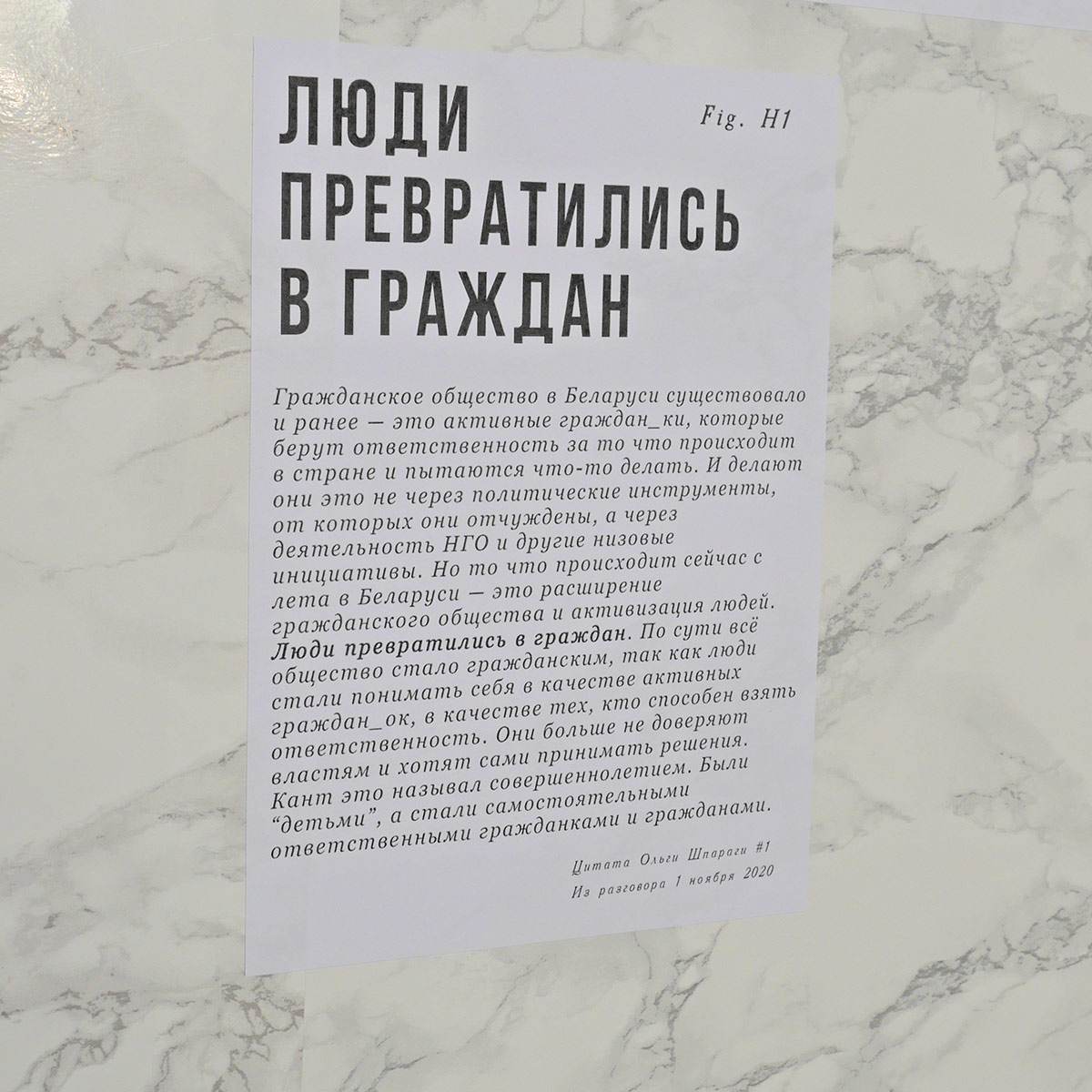
Quote by Olga Shparaga #1
Civil society has existed in Belarus before – active citizens who take responsibility for what is happening in the country and try to do something. And they do it not through political instruments, from which they are alienated, but through the activities of NGOs and other grassroots initiatives. But what has been happening in Belarus since this summer is the expansion of civil society and activisation of people. People have turned into citizens. In fact, the whole society has become civil, because people have started to understand themselves as active citizens, as those who are able to take responsibility. They no longer trust the authorities and want to make their own decisions. Kant called this the age of majority. Former "children", but they became independent, responsible citizens now.
From a conversation on the 1st of November 2020
People Have Turned Into Citizens
Civil society has existed in Belarus before – active citizens who take responsibility for what is happening in the country and try to do something. And they do it not through political instruments, from which they are alienated, but through the activities of NGOs and other grassroots initiatives. But what has been happening in Belarus since this summer is the expansion of civil society and activisation of people. People have turned into citizens. In fact, the whole society has become civil, because people have started to understand themselves as active citizens, as those who are able to take responsibility. They no longer trust the authorities and want to make their own decisions. Kant called this the age of majority. Former "children", but they became independent, responsible citizens now.
From a conversation on the 1st of November 2020
Цитата Ольги Шпараги #1
Люди превратились в граждан
Гражданское общество в Беларуси существовало и ранее — это активные граждан_ки, которые берут ответственность за то, что происходит в стране и пытаются что-то делать. И делают они это не через политические инструменты, от которых они отчуждены, а через деятельность НГО и другие низовые инициативы. Но то, что происходит сейчас с лета в Беларуси — это расширение гражданского общества и активизация людей. Люди превратились в граждан. По сути всё общество стало гражданским, так как люди стали понимать себя в качестве активных граждан_ок, в качестве тех, кто способен взять ответственность. Они больше не доверяют властям и хотят сами принимать решения. Кант это называл совершеннолетием. Были “детьми”, а стали самостоятельными ответственными гражданками и гражданами.
Из разговора 1 ноября 2020
Люди превратились в граждан
Гражданское общество в Беларуси существовало и ранее — это активные граждан_ки, которые берут ответственность за то, что происходит в стране и пытаются что-то делать. И делают они это не через политические инструменты, от которых они отчуждены, а через деятельность НГО и другие низовые инициативы. Но то, что происходит сейчас с лета в Беларуси — это расширение гражданского общества и активизация людей. Люди превратились в граждан. По сути всё общество стало гражданским, так как люди стали понимать себя в качестве активных граждан_ок, в качестве тех, кто способен взять ответственность. Они больше не доверяют властям и хотят сами принимать решения. Кант это называл совершеннолетием. Были “детьми”, а стали самостоятельными ответственными гражданками и гражданами.
Из разговора 1 ноября 2020
Fig. I1
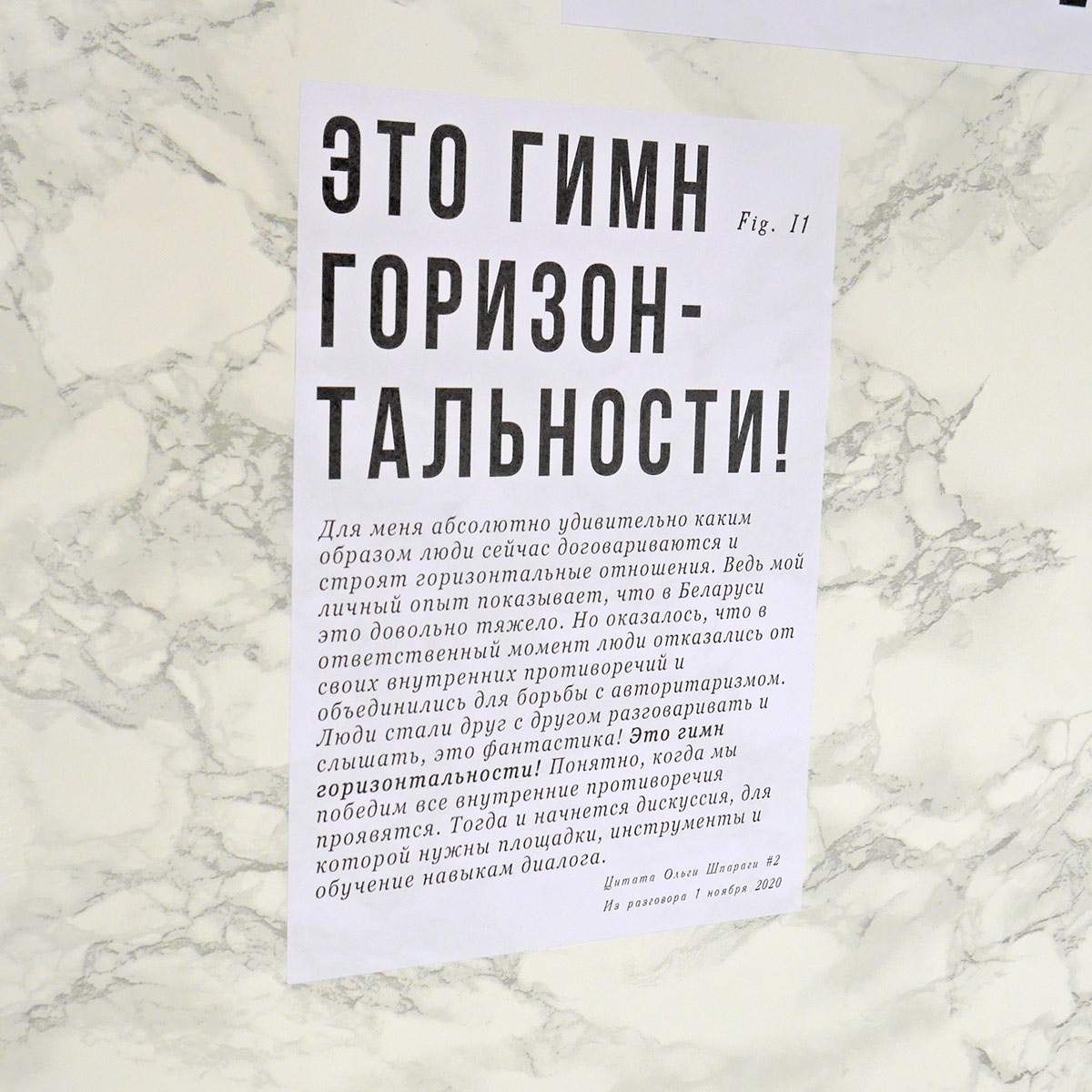
Quote by Olga Shparaga #2
For me, it's absolutely amazing how people now negotiate and build horizontal relationships. My personal experience shows that it is quite a difficult issue in Belarus. But it turned out that at a crucial moment people gave up their internal contradictions and united to fight authoritarianism. People started talking and listening to each other, it's fantastic! This is an anthem of horizontality! It is clear: after we win the internal contradictions will come back. That's when the discussion begins, for which you need platforms, tools and training in dialogue skills.
From the conversation on the 1st of November 2020
This is a Anthem of Horizontality!
For me, it's absolutely amazing how people now negotiate and build horizontal relationships. My personal experience shows that it is quite a difficult issue in Belarus. But it turned out that at a crucial moment people gave up their internal contradictions and united to fight authoritarianism. People started talking and listening to each other, it's fantastic! This is an anthem of horizontality! It is clear: after we win the internal contradictions will come back. That's when the discussion begins, for which you need platforms, tools and training in dialogue skills.
From the conversation on the 1st of November 2020
Цитата Ольги Шпараги #2
Это гимн горизонтальности!
Для меня абсолютно удивительно каким образом люди сейчас договариваются и строят горизонтальные отношения. Ведь мой личный опыт показывает, что в Беларуси это довольно тяжело. Но оказалось, что в ответственный момент люди отказались от своих внутренних противоречий и объединились для борьбы с авторитаризмом. Люди стали друг с другом разговаривать и слышать — это фантастика! Это гимн горизонтальности! Понятно, когда мы победим, то все внутренние противоречия проявятся. Тогда и начнется дискуссия, для которой нужны площадки, инструменты и обучение навыкам диалога.
Из разговора 1 ноября 2020
Это гимн горизонтальности!
Для меня абсолютно удивительно каким образом люди сейчас договариваются и строят горизонтальные отношения. Ведь мой личный опыт показывает, что в Беларуси это довольно тяжело. Но оказалось, что в ответственный момент люди отказались от своих внутренних противоречий и объединились для борьбы с авторитаризмом. Люди стали друг с другом разговаривать и слышать — это фантастика! Это гимн горизонтальности! Понятно, когда мы победим, то все внутренние противоречия проявятся. Тогда и начнется дискуссия, для которой нужны площадки, инструменты и обучение навыкам диалога.
Из разговора 1 ноября 2020
Fig. J1
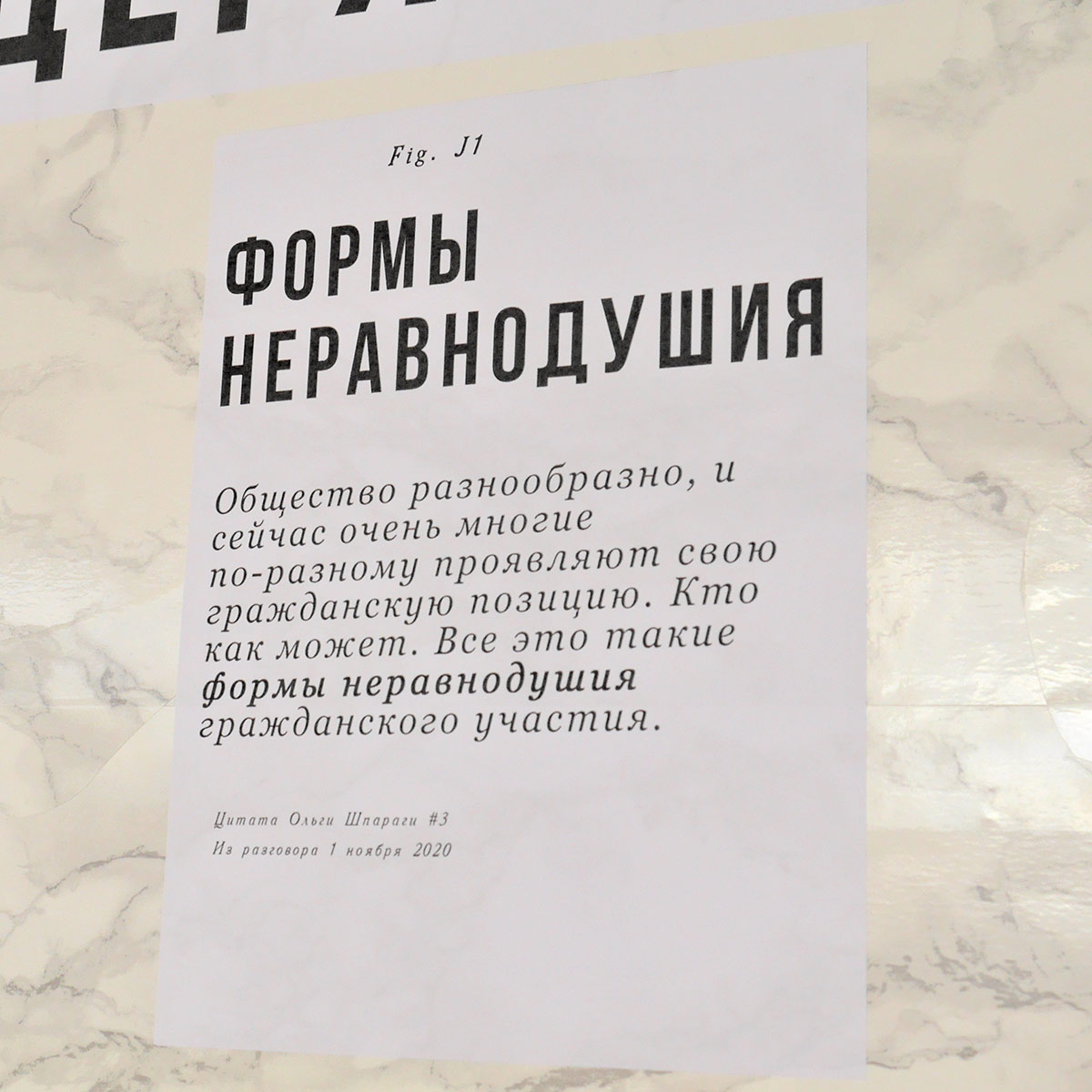
Quote by Olga Shparaga #3
Forms of Nonindifference
Society is diverse, and there are many different ways in which people now demonstrate their civic position. Everyone as they can. These are all forms of nonindifference, of civic engagement.
From a conversation on the 1st of November 2020.
Forms of Nonindifference
Society is diverse, and there are many different ways in which people now demonstrate their civic position. Everyone as they can. These are all forms of nonindifference, of civic engagement.
From a conversation on the 1st of November 2020.
Цитата Ольги Шпараги #3
Общество разнообразно, и сейчас очень многие по-разному проявляют свою гражданскую позицию. Кто как может. Все это такие формы неравнодушия гражданского участия.
Из разговора 1 ноября 2020
Формы неравнодушия
Общество разнообразно, и сейчас очень многие по-разному проявляют свою гражданскую позицию. Кто как может. Все это такие формы неравнодушия гражданского участия.
Из разговора 1 ноября 2020
Fig. K1
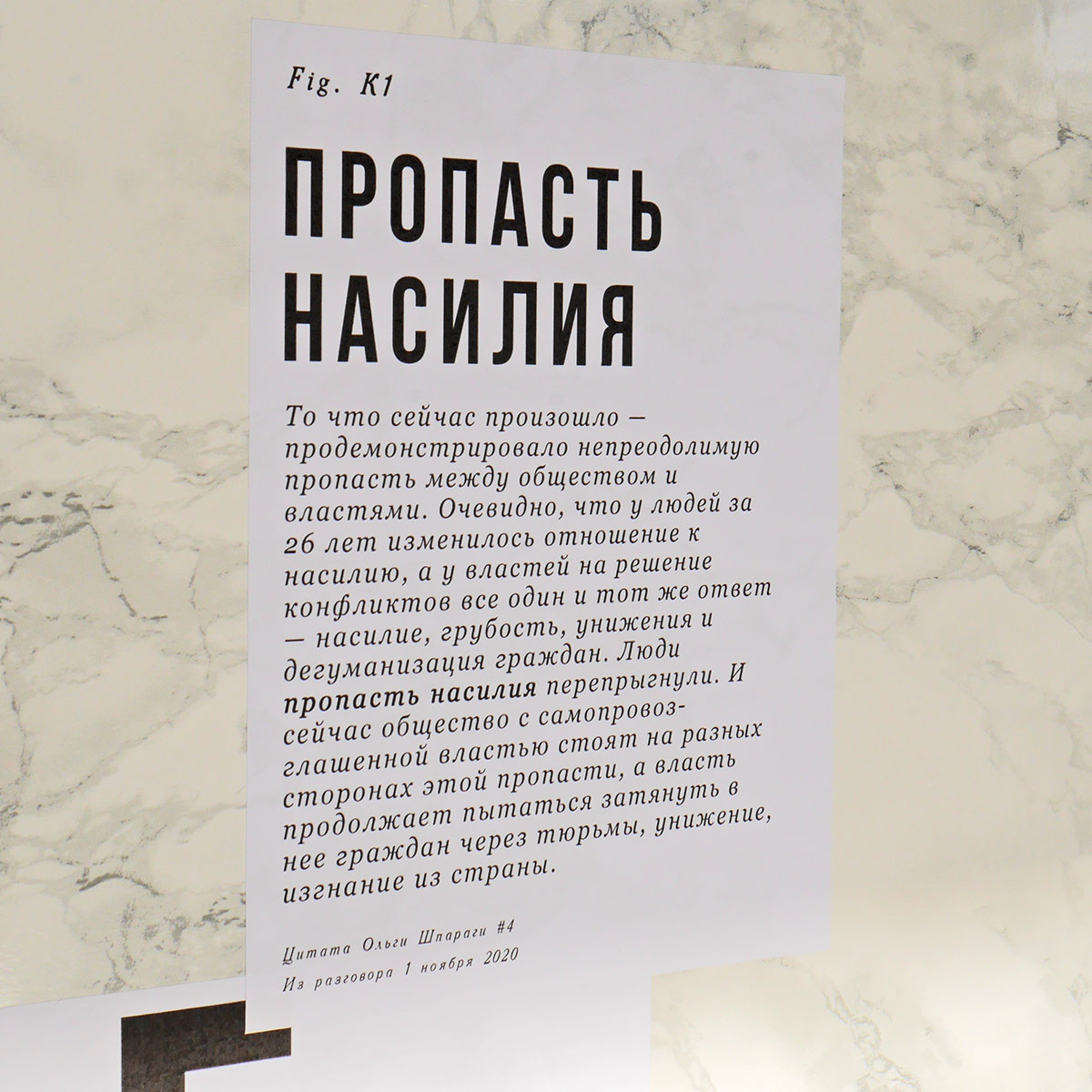
Quote by Olga Shparaga #4
What has happened now - has shown an unbridgeable gap between society and the authorities. Obviously, people's attitudes towards violence have changed in the past 26 years whereas the authorities have still the same response to conflict resolution as ever: violence, rudeness, humiliation and dehumanisation of citizens. People have jumped over the abyss of violence. And now the society and the self-proclaimed auhority are standing on different sides of this abyss, while the authorities continue to try to drag citizens into it through prisons, humiliation and forced exile.
From a conversation on the 1st of November 2020
Abyss of Violence
What has happened now - has shown an unbridgeable gap between society and the authorities. Obviously, people's attitudes towards violence have changed in the past 26 years whereas the authorities have still the same response to conflict resolution as ever: violence, rudeness, humiliation and dehumanisation of citizens. People have jumped over the abyss of violence. And now the society and the self-proclaimed auhority are standing on different sides of this abyss, while the authorities continue to try to drag citizens into it through prisons, humiliation and forced exile.
From a conversation on the 1st of November 2020
Цитата Ольги Шпараги #4
То что сейчас произошло — продемонстрировало непреодолимую пропасть между обществом и властями. Очевидно, что у людей за 26 лет изменилось отношение к насилию, а у властей на решение конфликтов все один и тот же ответ — насилие, грубость, унижения и дегуманизация граждан. Люди пропасть насилия перепрыгнули. И сейчас общество с самопровозглашенной властью стоят на разных сторонах этой пропасти, а власть продолжает пытаться затянуть в нее граждан через тюрьмы, унижение, изгнание из страны.
Из разговора 1 ноября 2020
Пропасть насилия
То что сейчас произошло — продемонстрировало непреодолимую пропасть между обществом и властями. Очевидно, что у людей за 26 лет изменилось отношение к насилию, а у властей на решение конфликтов все один и тот же ответ — насилие, грубость, унижения и дегуманизация граждан. Люди пропасть насилия перепрыгнули. И сейчас общество с самопровозглашенной властью стоят на разных сторонах этой пропасти, а власть продолжает пытаться затянуть в нее граждан через тюрьмы, унижение, изгнание из страны.
Из разговора 1 ноября 2020
Fig. L1

Quote by Olga Shparaga #5
It is extremely important for me that the revolution in Belarus has a woman's face. From the beginning when the campaign offices consolidated, new innovative strategies for fighting the regime were invented. This is a peaceful protest, smart and creative. Revolution means women. Women have shown how weakness can become strength. Women brought in emancipation and sensitivity to violence.
From a conversation on the 1st of November 2020
Revolution = Woman
It is extremely important for me that the revolution in Belarus has a woman's face. From the beginning when the campaign offices consolidated, new innovative strategies for fighting the regime were invented. This is a peaceful protest, smart and creative. Revolution means women. Women have shown how weakness can become strength. Women brought in emancipation and sensitivity to violence.
From a conversation on the 1st of November 2020
Цитата Ольги Шпараги #5
Для меня крайне важно что у революции в Беларуси женское лицо. Начиная с евалюции и объединения штабов были придуманы совершенно новые, не лобовые стратегии борьбы с режимом. Это мирный протест, он умный и креативный. Революция = женщины. Женщины показали как слабость может стать силой. Женщины привнесли эмансипацию и чувствительность по отношению к насилию.
Из разговора 1 ноября 2020
Революция = женщины
Для меня крайне важно что у революции в Беларуси женское лицо. Начиная с евалюции и объединения штабов были придуманы совершенно новые, не лобовые стратегии борьбы с режимом. Это мирный протест, он умный и креативный. Революция = женщины. Женщины показали как слабость может стать силой. Женщины привнесли эмансипацию и чувствительность по отношению к насилию.
Из разговора 1 ноября 2020
Fig. M1
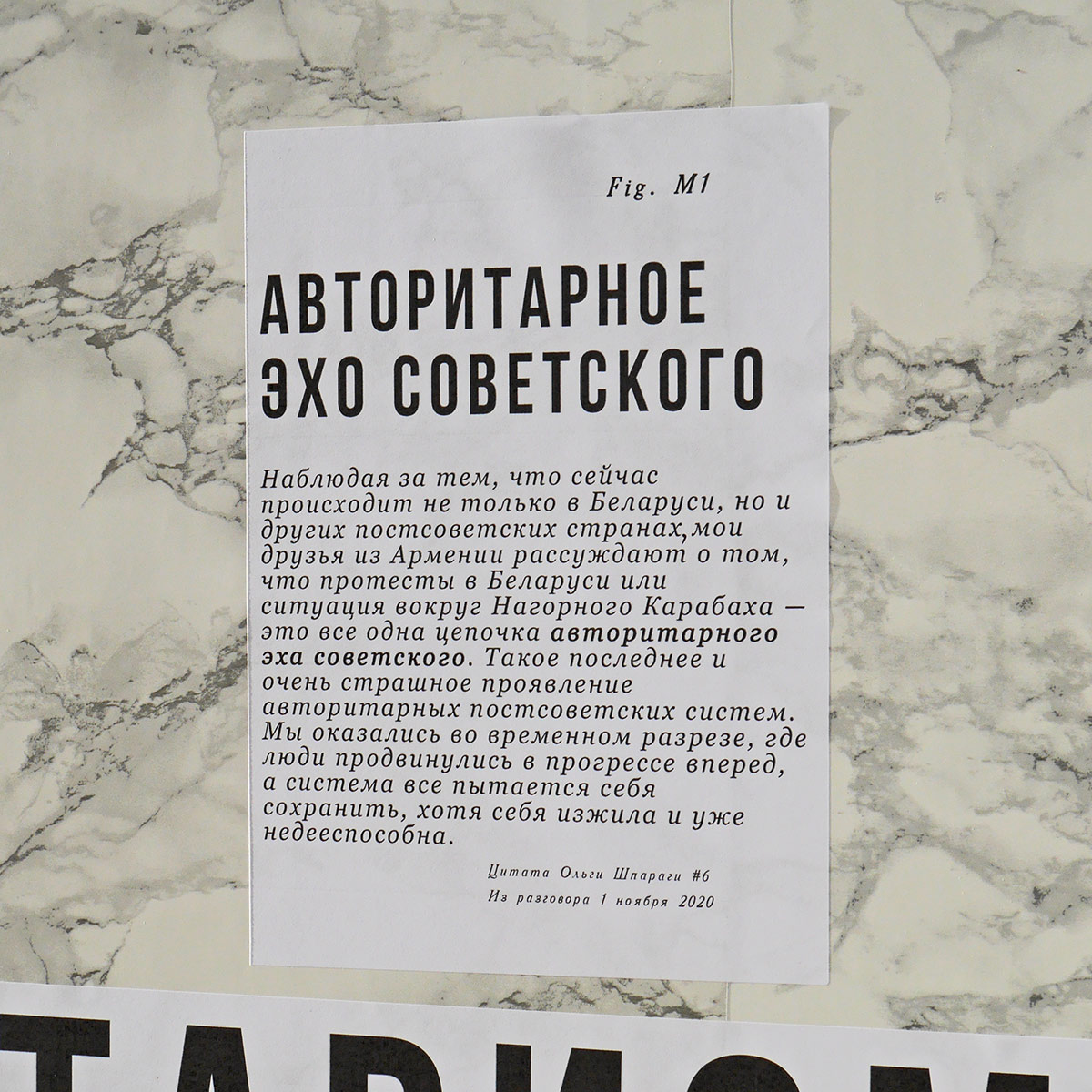
Quote by Olga Shparaga # 6
Observing what is happening now not only in Belarus, but also in other post-Soviet countries, my friends from Armenia say that the protests in Belarus or the situation in Nagorno-Karabakh are both the authoritarian echo of the Soviet regime. This is the latest and very terrifying manifestation of the authoritarian post-Soviet systems. We found ourselves in times where people have moved forward in progress while the system is still trying to preserve itself, although it has outlived itself and is already inefficient.
From a conversation on the 1st of November 2020
The Authoritarian Echo of the Soviet Regime
Observing what is happening now not only in Belarus, but also in other post-Soviet countries, my friends from Armenia say that the protests in Belarus or the situation in Nagorno-Karabakh are both the authoritarian echo of the Soviet regime. This is the latest and very terrifying manifestation of the authoritarian post-Soviet systems. We found ourselves in times where people have moved forward in progress while the system is still trying to preserve itself, although it has outlived itself and is already inefficient.
From a conversation on the 1st of November 2020
Цитата Ольги Шпараги #6
Наблюдая за тем, что сейчас происходит не только в Беларуси, но и в других постсоветских странах, мои друзья из Армении рассуждают о том, что протесты в Беларуси или ситуация вокруг Нагорного Карабаха — это все одна цепочка авторитарного эха советского. Такое последнее и очень страшное проявление авторитарных постсоветских систем. Мы оказались во временном разрезе, где люди продвинулись в прогрессе вперед, а система все пытается себя сохранить, хотя себя изжила и уже недееспособна.
Из разговора 1 ноября 2020
Авторитарное эхо советского
Наблюдая за тем, что сейчас происходит не только в Беларуси, но и в других постсоветских странах, мои друзья из Армении рассуждают о том, что протесты в Беларуси или ситуация вокруг Нагорного Карабаха — это все одна цепочка авторитарного эха советского. Такое последнее и очень страшное проявление авторитарных постсоветских систем. Мы оказались во временном разрезе, где люди продвинулись в прогрессе вперед, а система все пытается себя сохранить, хотя себя изжила и уже недееспособна.
Из разговора 1 ноября 2020
Fig. N1
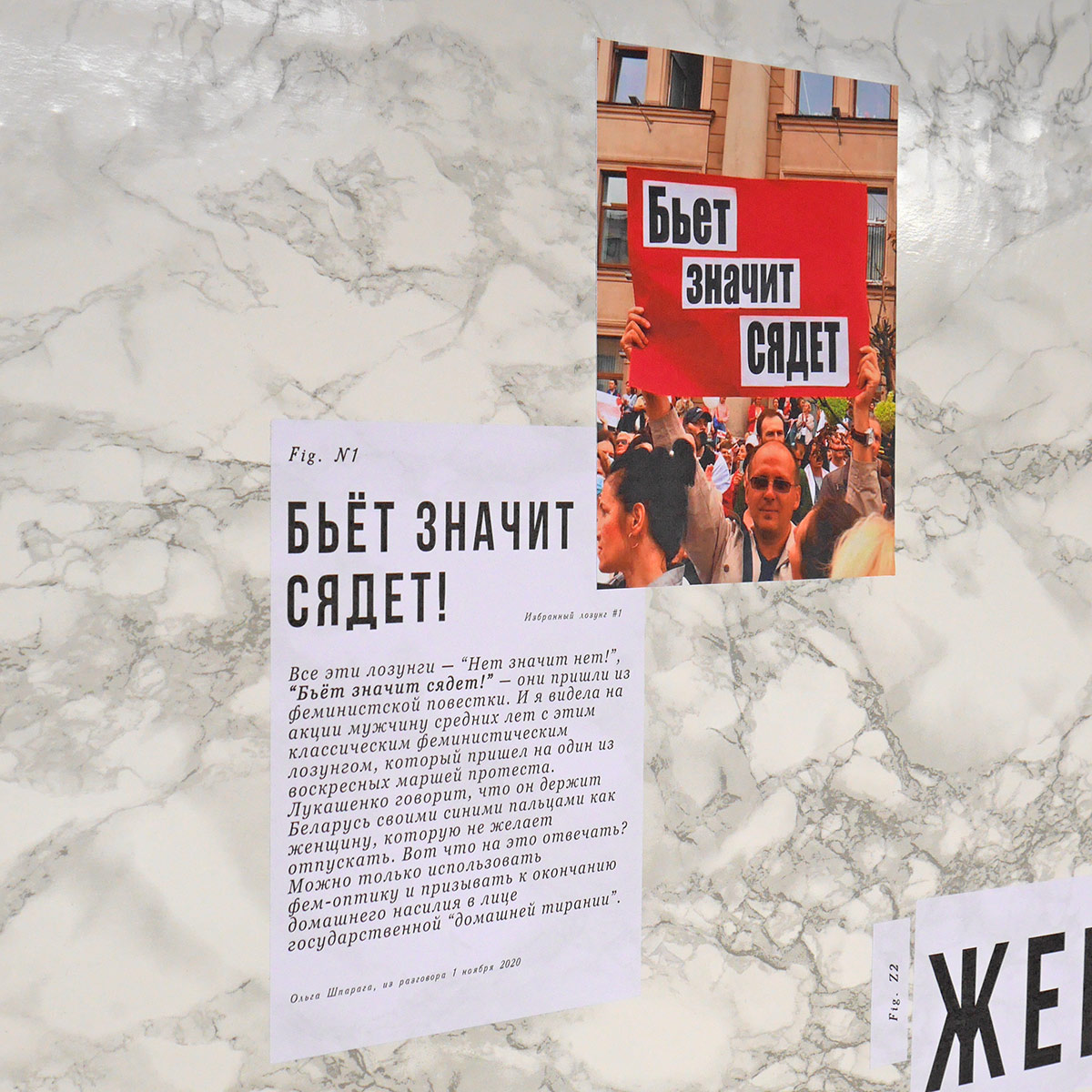
Favorite Slogan # 1
All these slogans - "No Means No!", "If He Beats, He’ll Be Imprisoned!" - they are from the feminist agenda. And at one of Sunday's protest marches I saw a middle-aged man with this classic feminist slogan. Lukashenko says that he holds Belarus with his blue fingers like a woman whom he does not want to let go. What can you say to this? One can only look at it from a feminist angle and demand the end of domestic violence projected like the state “domestic tyranny”.
From a conversation on the 1st of November 2020
If He Beats, He’ll Be Imprisoned!
All these slogans - "No Means No!", "If He Beats, He’ll Be Imprisoned!" - they are from the feminist agenda. And at one of Sunday's protest marches I saw a middle-aged man with this classic feminist slogan. Lukashenko says that he holds Belarus with his blue fingers like a woman whom he does not want to let go. What can you say to this? One can only look at it from a feminist angle and demand the end of domestic violence projected like the state “domestic tyranny”.
From a conversation on the 1st of November 2020
Избранный лозунг #1
Все эти лозунги — “Нет значит нет!”, “Бьёт значит сядет!” — они пришли из феминистской повестки. И я видела на акции мужчину средних лет с этим классическим феминистическим лозунгом, который пришел на один из воскресных маршей протеста. Лукашенко говорит, что он держит Беларусь своими синими пальцами как женщину, которую не желает отпускать. Вот что на это отвечать? Можно только использовать фем-оптику и призывать к окончанию домашнего насилия в лице государственной “домашней тирании”.
Ольга Шпарага, из разговора 1 ноября 2020
Бьёт значит сядет!
Все эти лозунги — “Нет значит нет!”, “Бьёт значит сядет!” — они пришли из феминистской повестки. И я видела на акции мужчину средних лет с этим классическим феминистическим лозунгом, который пришел на один из воскресных маршей протеста. Лукашенко говорит, что он держит Беларусь своими синими пальцами как женщину, которую не желает отпускать. Вот что на это отвечать? Можно только использовать фем-оптику и призывать к окончанию домашнего насилия в лице государственной “домашней тирании”.
Ольга Шпарага, из разговора 1 ноября 2020
Fig. O1
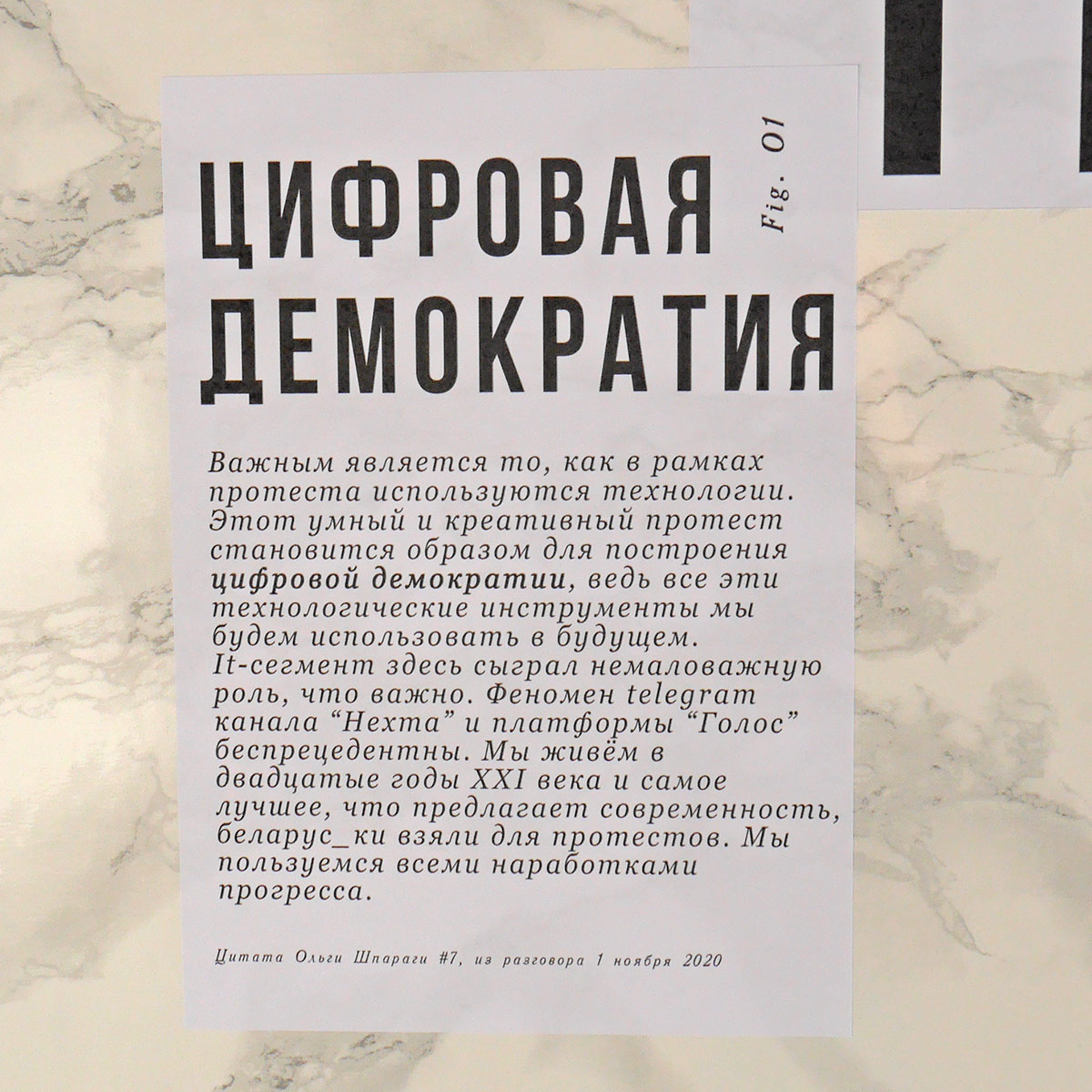
Quote by Olga Shparaga # 7
It is important how technology is used in the protest. This smart and creative protest is becoming the way to build digital democracy, as we will use all these technological tools in the future. The IT industry played an important role here, which is important. The telegam phenomenon of the “Нехта” channel and the platform “Voice” is unprecedented. We are living in the twenties of the XXI century and the best that the modern world has to offer Belarusians have used in protests. We use all advantages of progress.
From a conversation on the 1st of November 2020
Digital Democracy
It is important how technology is used in the protest. This smart and creative protest is becoming the way to build digital democracy, as we will use all these technological tools in the future. The IT industry played an important role here, which is important. The telegam phenomenon of the “Нехта” channel and the platform “Voice” is unprecedented. We are living in the twenties of the XXI century and the best that the modern world has to offer Belarusians have used in protests. We use all advantages of progress.
From a conversation on the 1st of November 2020
Цитата Ольги Шпараги #7
Цифровая демократия
Важным является то, как в рамках протеста используются технологии. Этот умный и креативный протест становится образом для построения цифровой демократии, ведь все эти технологические инструменты мы будем использовать в будущем. It-сегмент здесь сыграл немаловажную роль, что важно. Феномен telegram канала “Нехта” и платформы “Голос” беспрецедентны. Мы живём в двадцатые годы XXI века и самое лучшее, что предлагает современность, беларус_ки взяли для протестов. Мы пользуемся всеми наработками прогресса.
Из разговора 1 ноября 2020
Fig. P1
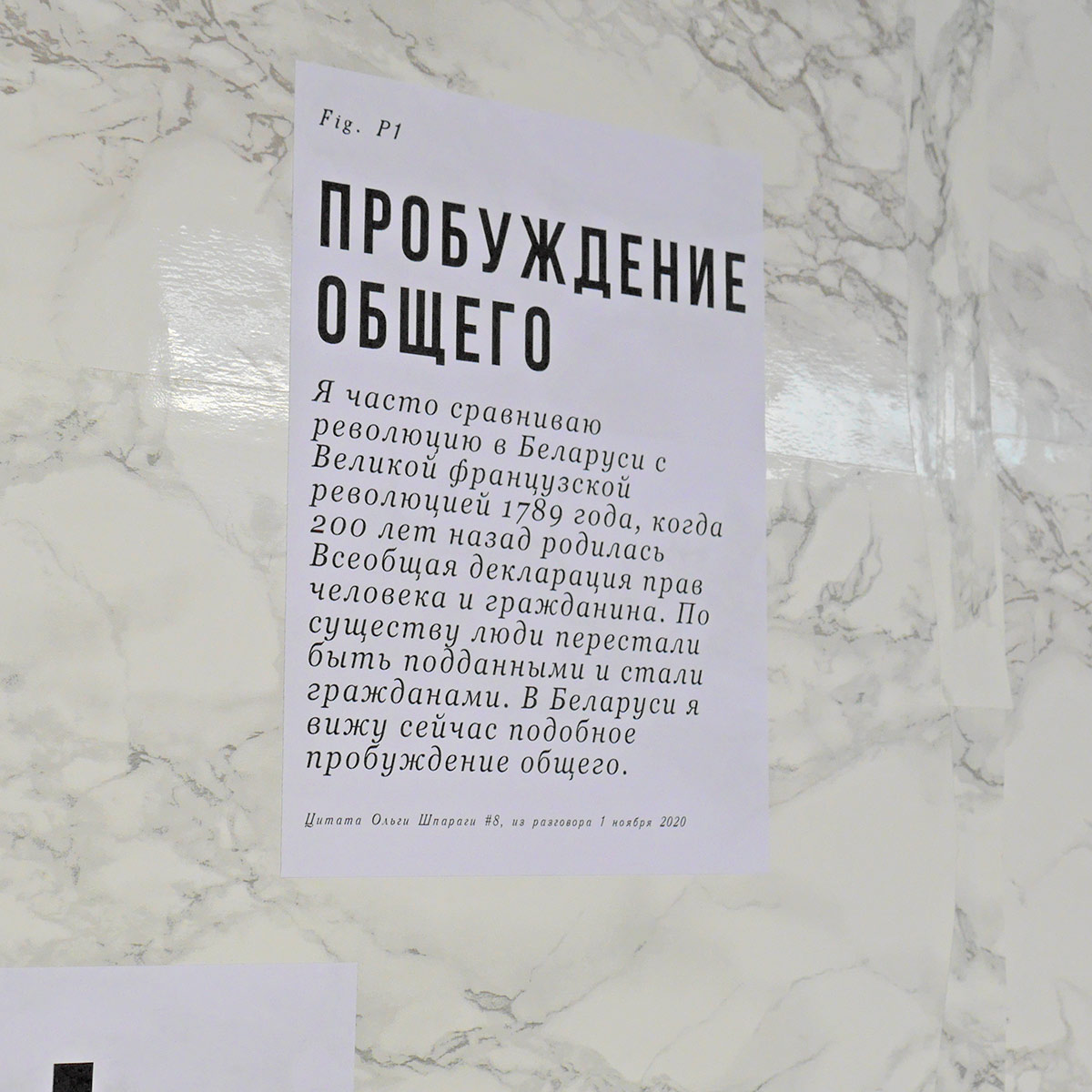
Quote by Olga Shparaga #8
I often compare the revolution in Belarus with the Great French Revolution of 1789, when the Universal Declaration of Human and Civil Rights was born 200 years ago. In essence, people ceased to be subjects and became citizens. In Belarus, I see now a similar awakening of the common.
From a conversation on the 1st of November 2020
Awakening the Commonplace
I often compare the revolution in Belarus with the Great French Revolution of 1789, when the Universal Declaration of Human and Civil Rights was born 200 years ago. In essence, people ceased to be subjects and became citizens. In Belarus, I see now a similar awakening of the common.
From a conversation on the 1st of November 2020
Цитата Ольги Шпараги #8
Я часто сравниваю революцию в Беларуси с Великой французской революцией 1789 года, когда 200 лет назад родилась Всеобщая декларация прав человека и гражданина. По существу люди перестали быть подданными и стали гражданами. В Беларуси я вижу сейчас подобное пробуждение общего.
Из разговора 1 ноября 2020
Пробуждение общего
Я часто сравниваю революцию в Беларуси с Великой французской революцией 1789 года, когда 200 лет назад родилась Всеобщая декларация прав человека и гражданина. По существу люди перестали быть подданными и стали гражданами. В Беларуси я вижу сейчас подобное пробуждение общего.
Из разговора 1 ноября 2020
Fig. Q1
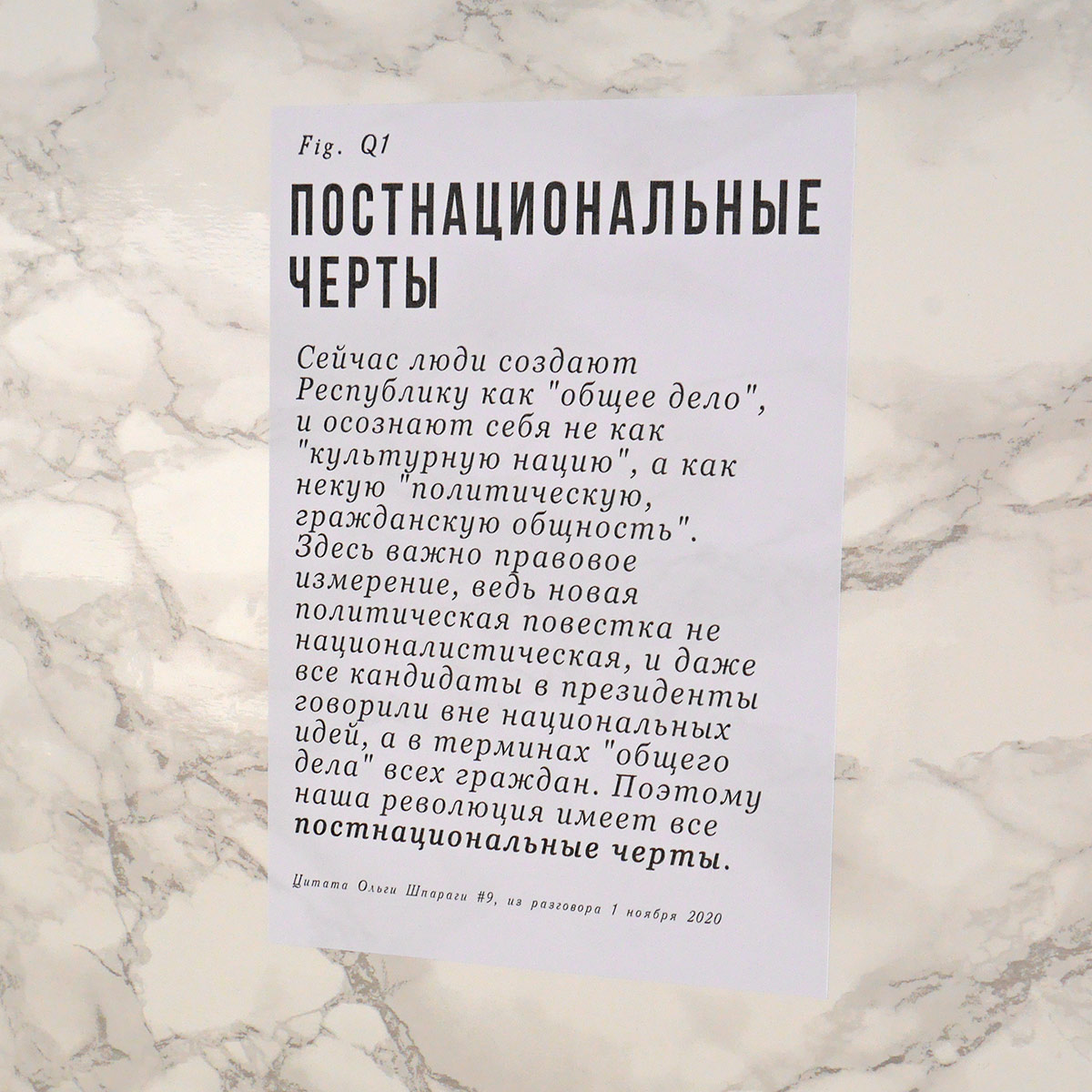
Quote by Olga Shparaga #9
People are now creating the Republic as a "common cause" and they recognise themselves not as a "cultural nation" but as a "political, civic community". The legal dimension is important here, because the new political agenda is not nationalistic, and even all presidential candidates spoke out of national ideas, but in terms of "common cause" for all citizens. This is why our revolution has all the post-national features.
From a conversation on the 1st of November 2020
Post-National Features
People are now creating the Republic as a "common cause" and they recognise themselves not as a "cultural nation" but as a "political, civic community". The legal dimension is important here, because the new political agenda is not nationalistic, and even all presidential candidates spoke out of national ideas, but in terms of "common cause" for all citizens. This is why our revolution has all the post-national features.
From a conversation on the 1st of November 2020
Цитата Ольги Шпараги #9
Сейчас люди создают Республику как "общее дело", и осознают себя не как "культурную нацию", а как некую "политическую, гражданскую общность". Здесь важно правовое измерение, ведь новая политическая повестка не националистическая, и даже все кандидаты в президенты говорили вне национальных идей, а в терминах "общего дела" всех граждан. Поэтому наша революция имеет все постнациональные черты.
Из разговора 1 ноября 2020
Постнациональные черты
Сейчас люди создают Республику как "общее дело", и осознают себя не как "культурную нацию", а как некую "политическую, гражданскую общность". Здесь важно правовое измерение, ведь новая политическая повестка не националистическая, и даже все кандидаты в президенты говорили вне национальных идей, а в терминах "общего дела" всех граждан. Поэтому наша революция имеет все постнациональные черты.
Из разговора 1 ноября 2020
Fig. R1
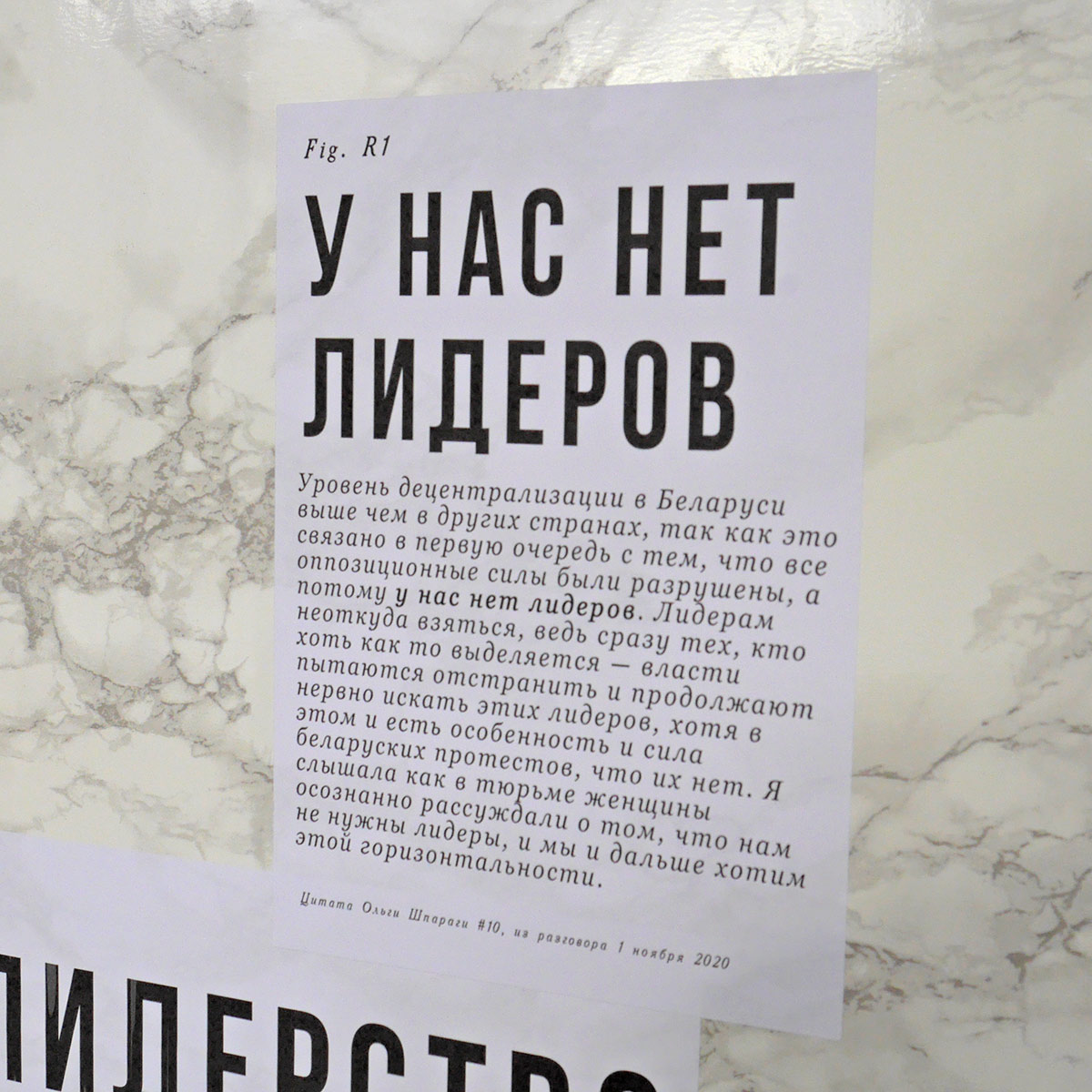
Quote by Olga Shparaga #10
The level of decentralization in Belarus is higher than in other countries, as it is primarily due to the fact that all opposition forces were destroyed, and therefore we have no leaders. Leaders have nowhere to appear from, because the authorities try to remove those who stand out at least somehow, and continue to look for these leaders nervously, although this is the peculiarity and strength of the Belarusian protests that they do not exist. I heard women in prison consciously reasoning that we do not need leaders, and we still want this horizontality.
From the conversation on the 1st of November 2020
We Have No Leaders
The level of decentralization in Belarus is higher than in other countries, as it is primarily due to the fact that all opposition forces were destroyed, and therefore we have no leaders. Leaders have nowhere to appear from, because the authorities try to remove those who stand out at least somehow, and continue to look for these leaders nervously, although this is the peculiarity and strength of the Belarusian protests that they do not exist. I heard women in prison consciously reasoning that we do not need leaders, and we still want this horizontality.
From the conversation on the 1st of November 2020
Цитата Ольги Шпараги #10
Уровень децентрализации в Беларуси выше чем в других странах, так как это связано в первую очередь с тем, что все оппозиционные силы были разрушены, а потому у нас нет лидеров. Лидерам неоткуда взяться, ведь сразу тех, кто хоть как то выделяется — власти пытаются отстранить и продолжают нервно искать этих лидеров, хотя в этом и есть особенность и сила беларуских протестов, что их нет. Я слышала как в тюрьме женщины осознанно рассуждали о том, что нам не нужны лидеры, и мы и дальше хотим этой горизонтальности.
Из разговора 1 ноября 2020
У нас нет лидеров
Уровень децентрализации в Беларуси выше чем в других странах, так как это связано в первую очередь с тем, что все оппозиционные силы были разрушены, а потому у нас нет лидеров. Лидерам неоткуда взяться, ведь сразу тех, кто хоть как то выделяется — власти пытаются отстранить и продолжают нервно искать этих лидеров, хотя в этом и есть особенность и сила беларуских протестов, что их нет. Я слышала как в тюрьме женщины осознанно рассуждали о том, что нам не нужны лидеры, и мы и дальше хотим этой горизонтальности.
Из разговора 1 ноября 2020
Fig. S1
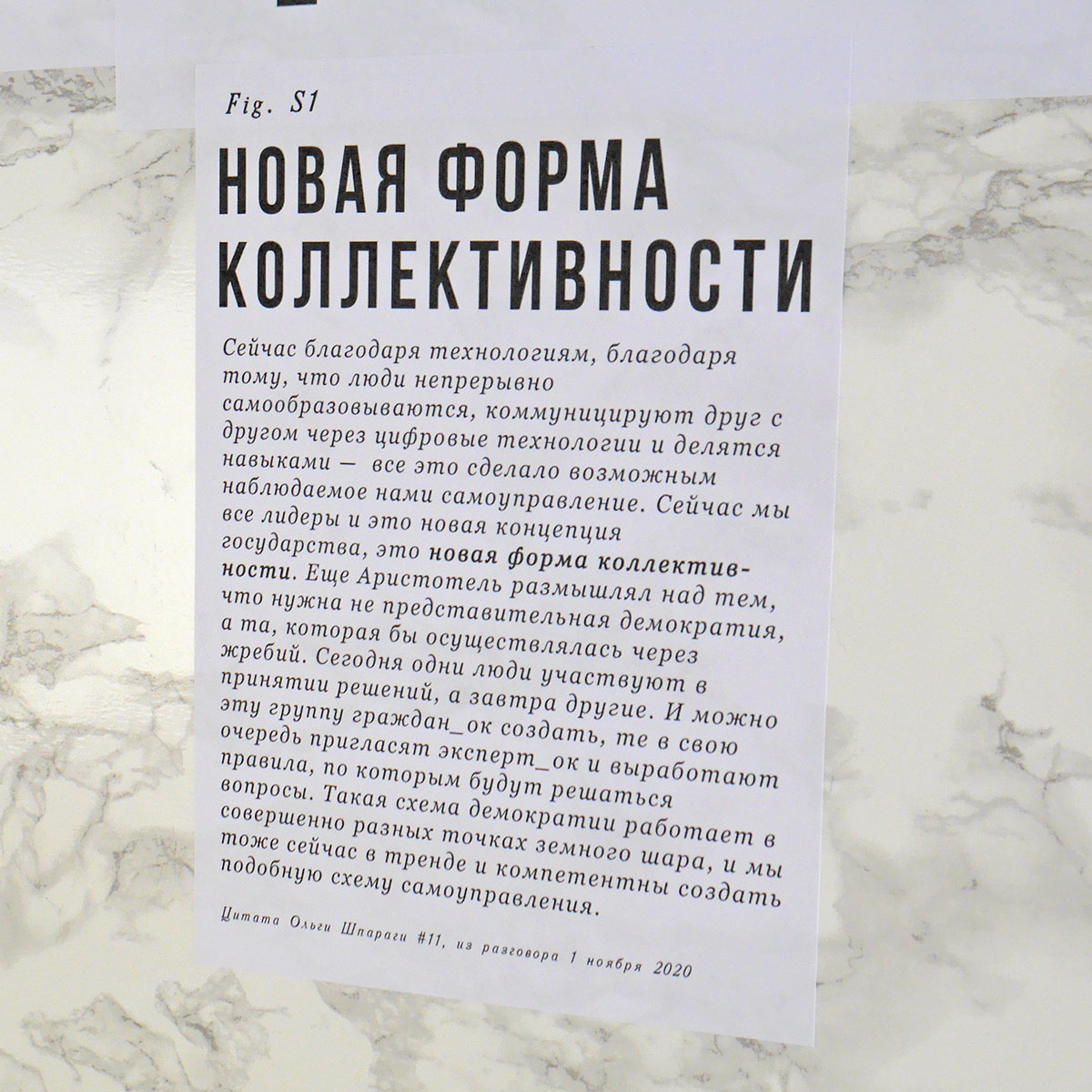
Quote by Olga Shparaga #11
Now, thanks to technology, thanks to the fact that people continuously self-educate, communicate with each other through digital technologies and share skills - all this has made possible the self-administration we see. Now we are all leaders and this is a new concept of the state, a new form of collectivity. Aristotle also pondered the need not for a representative democracy, but one that would be implemented through a draw. Today some people participate in decision-making, and tomorrow others. And it is possible to create this group of citizens, who, in their turn, will invite experts and work out the rules by which questions will be solved. Such a scheme of democracy works in completely different parts of the world, and we are also in a trend now and are competent to create such a scheme of self-governance.
From the conversation on the 1st of November 2020
A New Form of Collectivity
Now, thanks to technology, thanks to the fact that people continuously self-educate, communicate with each other through digital technologies and share skills - all this has made possible the self-administration we see. Now we are all leaders and this is a new concept of the state, a new form of collectivity. Aristotle also pondered the need not for a representative democracy, but one that would be implemented through a draw. Today some people participate in decision-making, and tomorrow others. And it is possible to create this group of citizens, who, in their turn, will invite experts and work out the rules by which questions will be solved. Such a scheme of democracy works in completely different parts of the world, and we are also in a trend now and are competent to create such a scheme of self-governance.
From the conversation on the 1st of November 2020
Цитата Ольги Шпараги #11
Сейчас благодаря технологиям, благодаря тому, что люди непрерывно самообразовываются, коммуницируют друг с другом через цифровые технологии и делятся навыками — все это сделало возможным наблюдаемое нами самоуправление. Сейчас мы все лидеры и это новая концепция государства, это новая форма коллективности. Еще Аристотель размышлял над тем, что нужна не представительная демократия, а та, которая бы осуществлялась через жребий. Сегодня одни люди участвуют в принятии решений, а завтра другие. И можно эту группу граждан_ок создать, те в свою очередь пригласят эксперт_ок и выработают правила, по которым будут решаться вопросы. Такая схема демократии работает в совершенно разных точках земного шара, и мы тоже сейчас в тренде и компетентны создать подобную схему самоуправления.
Из разговора 1 ноября 2020
Новая форма коллективности
Сейчас благодаря технологиям, благодаря тому, что люди непрерывно самообразовываются, коммуницируют друг с другом через цифровые технологии и делятся навыками — все это сделало возможным наблюдаемое нами самоуправление. Сейчас мы все лидеры и это новая концепция государства, это новая форма коллективности. Еще Аристотель размышлял над тем, что нужна не представительная демократия, а та, которая бы осуществлялась через жребий. Сегодня одни люди участвуют в принятии решений, а завтра другие. И можно эту группу граждан_ок создать, те в свою очередь пригласят эксперт_ок и выработают правила, по которым будут решаться вопросы. Такая схема демократии работает в совершенно разных точках земного шара, и мы тоже сейчас в тренде и компетентны создать подобную схему самоуправления.
Из разговора 1 ноября 2020
Fig. T1
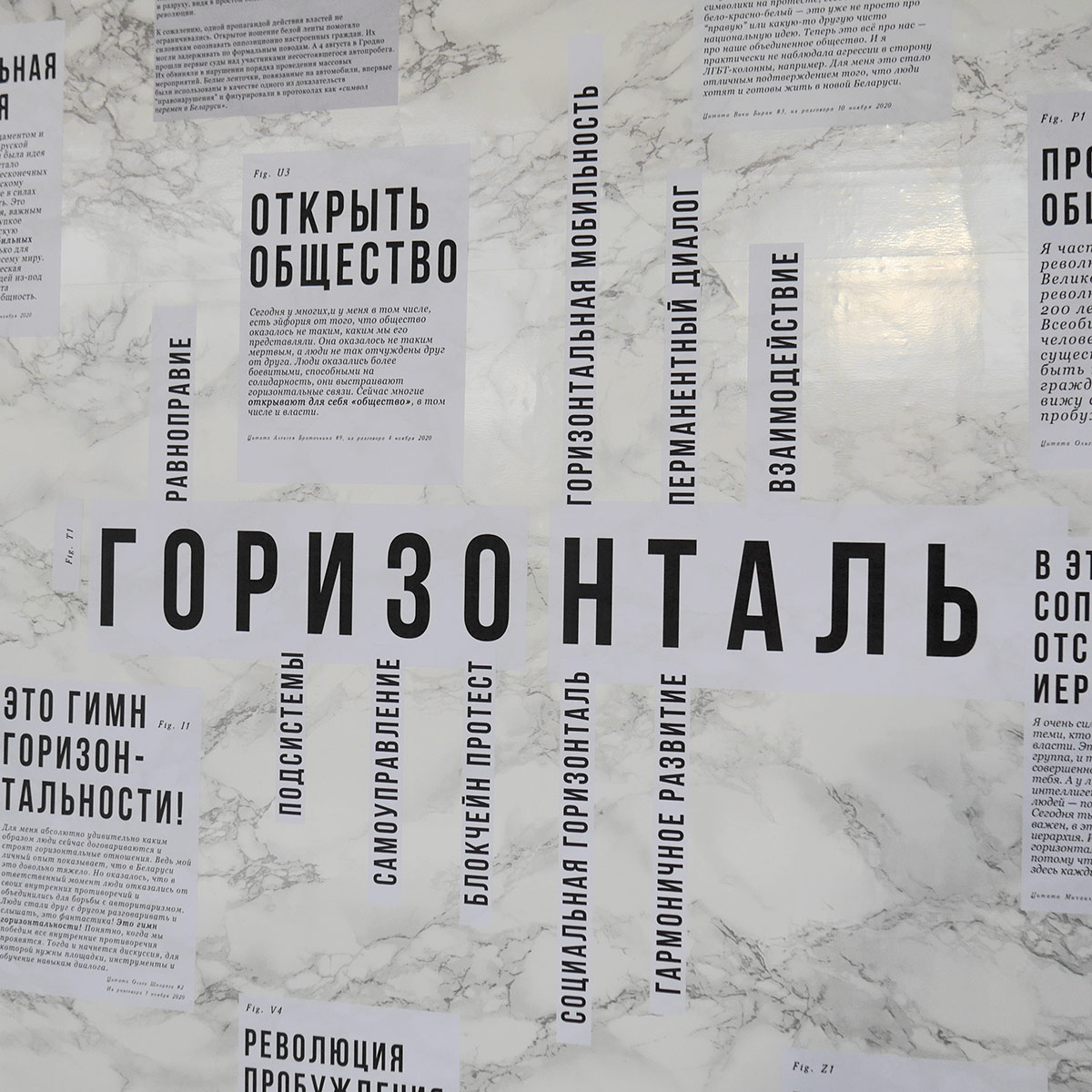
Keyword # 1
Interaction / Blockchain Protest / Harmonious Development / Horizontal Mobility / Permanent Dialogue / Subsystems / Equality / Self-Governance / Social Horizontal
See:
Fig. I1: This is the anthem of horizontality
Fig. P1: Awakening of the common
Fig. U3: Opening up society
Fig. U4: Blockchain Protest
Fig. B5: White Ribbon
Fig. W5: There is no hierarchy in this resistance
Fig. L6: White-red-white and rainbow flags
Fig. Q7: Dialogue skills
Horizontal
Interaction / Blockchain Protest / Harmonious Development / Horizontal Mobility / Permanent Dialogue / Subsystems / Equality / Self-Governance / Social Horizontal
See:
Fig. I1: This is the anthem of horizontality
Fig. P1: Awakening of the common
Fig. U3: Opening up society
Fig. U4: Blockchain Protest
Fig. B5: White Ribbon
Fig. W5: There is no hierarchy in this resistance
Fig. L6: White-red-white and rainbow flags
Fig. Q7: Dialogue skills
Ключевое слово #1
Взаимодействие / Блокчейн протест / Гармоничное развитие / Горизонтальная мобильность / Перманентный диалог / Подсистемы / Равноправие / Самоуправление / Социальная горизонталь
Смотри:
Fig. I1: Это гимн горизонтальности
Fig. P1: Пробуждение общего
Fig. U3: Открыть общество
Fig. U4: Блокчейн протест
Fig. B5: Белая лента
Fig. W5: В этом сопротивлении отсутствует иерархия
Fig. L6: Бело-красно-белый и радужный флаги
Fig. Q7: Навыки диалога
Горизонталь
Взаимодействие / Блокчейн протест / Гармоничное развитие / Горизонтальная мобильность / Перманентный диалог / Подсистемы / Равноправие / Самоуправление / Социальная горизонталь
Смотри:
Fig. I1: Это гимн горизонтальности
Fig. P1: Пробуждение общего
Fig. U3: Открыть общество
Fig. U4: Блокчейн протест
Fig. B5: Белая лента
Fig. W5: В этом сопротивлении отсутствует иерархия
Fig. L6: Бело-красно-белый и радужный флаги
Fig. Q7: Навыки диалога
Fig. U1

Contributor # 2
Nadya Sayapina is an artist, author of projects, art tutor. Her artistic practices include performance, multimedia, installations, land art, painting, text. She explores mediation in art through the prism of performative practices and processualism. Nadya addresses the themes of corporeality, self-reflection, memory, and the feminist agenda. She participates in projects and residences in Belarus and abroad.
In July 2020, she organized the performance "Heritage", during which art workers attached to their backs the samples of works previously withdrawn from the Belgazprombank collection, and for several hours stood in front of QR codes placed on the walls where the withdrawn works used to be exhibited. The presented works were confiscated within the so-called "Belgazprombank case", which was previously headed by one of the potential presidential candidates Viktor Babariko. The collection is represented by a number of art works (more than 100), the core of the collection is the paintings by the Belarusian artists of the “Paris School”. The paintings by the world-famous artists like Marc Chagall and Chaïm Soutine became the first original works in Belarus. 35 exhibits from the collection are included in the State List of Historical and Cultural Heritage of the Republic of Belarus.
On the 7th of September Nadya Sayapina was arrested at her home, a search was made, and her computer and drivers were seized. On the 8thof September Nadya was sentenced to 15 days of administrative arrest for taking part in an action/ performance against violence, during which on the 15th of August artists stood near the Palace of Arts with the photographs of victims of violence that happened on August 9 — 12. Nadya was sentenced to 15 days of administrative arrest according to Part 1 of Article 23.34 of the Administrative Offences Code (participation in an unauthorized demonstration). The international art community reacted to this situation by signing an open letter, linking this arrest with the repression of the artists. The letter began: “We believe that the administrative arrest of the artist Nadya Sayapina, as well as other artists, is a persecution in Belarus for the exercise of their constitutional right to express civil and professional position".
Lives and works in Minsk.
Nadya Sayapina
Nadya Sayapina is an artist, author of projects, art tutor. Her artistic practices include performance, multimedia, installations, land art, painting, text. She explores mediation in art through the prism of performative practices and processualism. Nadya addresses the themes of corporeality, self-reflection, memory, and the feminist agenda. She participates in projects and residences in Belarus and abroad.
In July 2020, she organized the performance "Heritage", during which art workers attached to their backs the samples of works previously withdrawn from the Belgazprombank collection, and for several hours stood in front of QR codes placed on the walls where the withdrawn works used to be exhibited. The presented works were confiscated within the so-called "Belgazprombank case", which was previously headed by one of the potential presidential candidates Viktor Babariko. The collection is represented by a number of art works (more than 100), the core of the collection is the paintings by the Belarusian artists of the “Paris School”. The paintings by the world-famous artists like Marc Chagall and Chaïm Soutine became the first original works in Belarus. 35 exhibits from the collection are included in the State List of Historical and Cultural Heritage of the Republic of Belarus.
On the 7th of September Nadya Sayapina was arrested at her home, a search was made, and her computer and drivers were seized. On the 8thof September Nadya was sentenced to 15 days of administrative arrest for taking part in an action/ performance against violence, during which on the 15th of August artists stood near the Palace of Arts with the photographs of victims of violence that happened on August 9 — 12. Nadya was sentenced to 15 days of administrative arrest according to Part 1 of Article 23.34 of the Administrative Offences Code (participation in an unauthorized demonstration). The international art community reacted to this situation by signing an open letter, linking this arrest with the repression of the artists. The letter began: “We believe that the administrative arrest of the artist Nadya Sayapina, as well as other artists, is a persecution in Belarus for the exercise of their constitutional right to express civil and professional position".
Lives and works in Minsk.
Контрибьюторка #2
Надя Саяпина
Надя Саяпина – художница, авторка проектов, арт-тьюторка. Её художественные практики включают перформанс, мультимедиа, инсталляции, лэнд-арт, живопись, текст. Исследует медиацию в искусстве через призму перформативных практик и процессуальности. Обращается к темам телесности, саморефлексии, памяти, феминистской повестке. Участвует в проектах и резиденциях в Беларуси и за рубежом.
В июле 2020 года организовала перфоманс «Достояние», во время которого деятели культуры и искусства прикрепили к своим спинам репродукции работ, ранее изъятых из коллекции Белгазпромбанка, и на протяжении нескольких часов стояли напротив QR-кодов, размещенных на стенах на местах изъятых работ. Представленные произведения были конфискованы в рамках так называемого "дела Белгазпромбанка", который ранее возглавлял один из потенциальных кандидатов в президенты Виктор Бабарико. Коллекция представлена собранием произведений искусства (более 100 артефактов), ядро коллекции составляют произведения художников Парижской школы — уроженцев Беларуси. Живописные полотна всемирно известных художников Марка Шагала и Хаима Сутина стали первыми в Беларуси оригинальными произведениями. 35 экспонатов собрания включены в Государственный список историко-культурных ценностей Республики Беларусь.
7 сентября художница была задержана у себя дома, также был проведён обыск и изъята компьютерная техника и носители информации. 8 сентября за участие в акции/перформансе против насилия, в рамках которого 15 августа художни_цы стояли возле Дворца искусств с фотографиями потерпевших во время протестов и задержаний 9 — 12 августа, Наде присудили 15 суток административного ареста согласно ч. 1 арт. 23.34 Кодекса об административных правонарушениях (участие в несанкционированном массовом мероприятии). Международное художественное сообщество отреагировало на данную ситуацию подписанием открытого письма, связывая данный арест с начавшимися репрессиями творческой среды: "Мы считаем, что административный арест художницы Надежды Саяпиной, а также других работников и работниц культуры, является преследованием за реализацию своего конституционного права на выражение гражданской и профессиональной позиции в Беларуси".
Живет и работает в Минске.
Надя Саяпина
Надя Саяпина – художница, авторка проектов, арт-тьюторка. Её художественные практики включают перформанс, мультимедиа, инсталляции, лэнд-арт, живопись, текст. Исследует медиацию в искусстве через призму перформативных практик и процессуальности. Обращается к темам телесности, саморефлексии, памяти, феминистской повестке. Участвует в проектах и резиденциях в Беларуси и за рубежом.
В июле 2020 года организовала перфоманс «Достояние», во время которого деятели культуры и искусства прикрепили к своим спинам репродукции работ, ранее изъятых из коллекции Белгазпромбанка, и на протяжении нескольких часов стояли напротив QR-кодов, размещенных на стенах на местах изъятых работ. Представленные произведения были конфискованы в рамках так называемого "дела Белгазпромбанка", который ранее возглавлял один из потенциальных кандидатов в президенты Виктор Бабарико. Коллекция представлена собранием произведений искусства (более 100 артефактов), ядро коллекции составляют произведения художников Парижской школы — уроженцев Беларуси. Живописные полотна всемирно известных художников Марка Шагала и Хаима Сутина стали первыми в Беларуси оригинальными произведениями. 35 экспонатов собрания включены в Государственный список историко-культурных ценностей Республики Беларусь.
7 сентября художница была задержана у себя дома, также был проведён обыск и изъята компьютерная техника и носители информации. 8 сентября за участие в акции/перформансе против насилия, в рамках которого 15 августа художни_цы стояли возле Дворца искусств с фотографиями потерпевших во время протестов и задержаний 9 — 12 августа, Наде присудили 15 суток административного ареста согласно ч. 1 арт. 23.34 Кодекса об административных правонарушениях (участие в несанкционированном массовом мероприятии). Международное художественное сообщество отреагировало на данную ситуацию подписанием открытого письма, связывая данный арест с начавшимися репрессиями творческой среды: "Мы считаем, что административный арест художницы Надежды Саяпиной, а также других работников и работниц культуры, является преследованием за реализацию своего конституционного права на выражение гражданской и профессиональной позиции в Беларуси".
Живет и работает в Минске.
Fig. V1
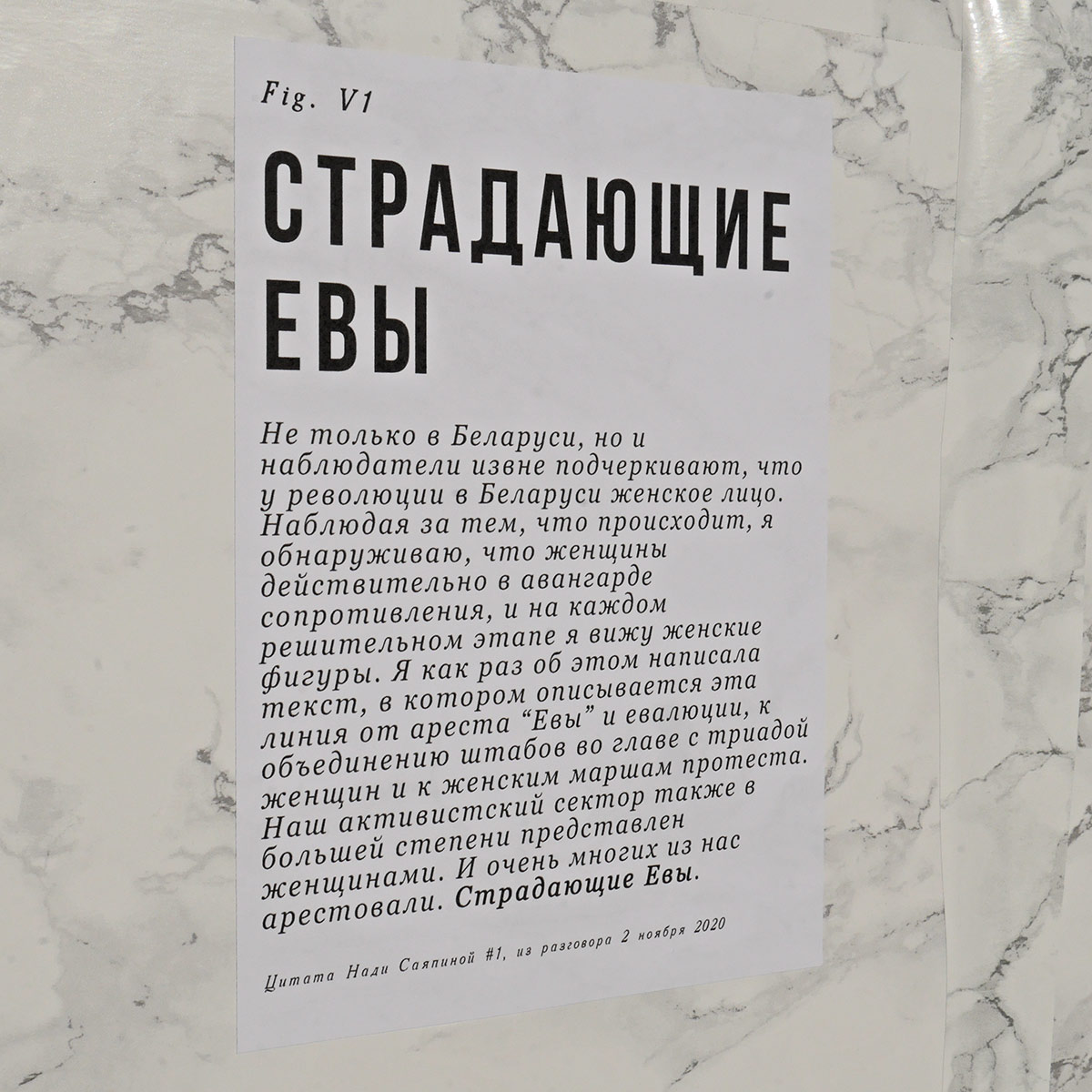
Quote by Nadya Sayapina # 1
Not only in Belarus, but also outside of it, people emphasize that the revolution in Belarus has a woman's face. As I follow what is happening, I see that the women are at the forefront of resistance, and at every crucial point I see female figures. I recently wrote a text about this where I describe a storyline between the arrest of “Eve” and “eve”-olution, the cooperation of campaign offices led by three women, and the women's protest marches. Our activist group is also heavily represented by women. And many of us have been arrested. Suffering Eves.
From a conversation on the 2nd of November 2020
Suffering Eves
Not only in Belarus, but also outside of it, people emphasize that the revolution in Belarus has a woman's face. As I follow what is happening, I see that the women are at the forefront of resistance, and at every crucial point I see female figures. I recently wrote a text about this where I describe a storyline between the arrest of “Eve” and “eve”-olution, the cooperation of campaign offices led by three women, and the women's protest marches. Our activist group is also heavily represented by women. And many of us have been arrested. Suffering Eves.
From a conversation on the 2nd of November 2020
Цитата Нади Саяпиной #1
Страдающие Евы
Не только в Беларуси, но и наблюдатели извне подчеркивают, что у революции в Беларуси женское лицо. Наблюдая за тем, что происходит, я обнаруживаю, что женщины действительно в авангарде сопротивления, и на каждом решительном этапе я вижу женские фигуры. Я как раз об этом написала текст, в котором описывается эта линия от ареста “Евы” и евалюции, к объединению штабов во главе с триадой женщин и к женским маршам протеста. Наш активистский сектор также в большей степени представлен женщинами. И очень многих из нас арестовали. Страдающие Евы.
Из разговора 2 ноября 2020
Страдающие Евы
Не только в Беларуси, но и наблюдатели извне подчеркивают, что у революции в Беларуси женское лицо. Наблюдая за тем, что происходит, я обнаруживаю, что женщины действительно в авангарде сопротивления, и на каждом решительном этапе я вижу женские фигуры. Я как раз об этом написала текст, в котором описывается эта линия от ареста “Евы” и евалюции, к объединению штабов во главе с триадой женщин и к женским маршам протеста. Наш активистский сектор также в большей степени представлен женщинами. И очень многих из нас арестовали. Страдающие Евы.
Из разговора 2 ноября 2020
Fig. W1
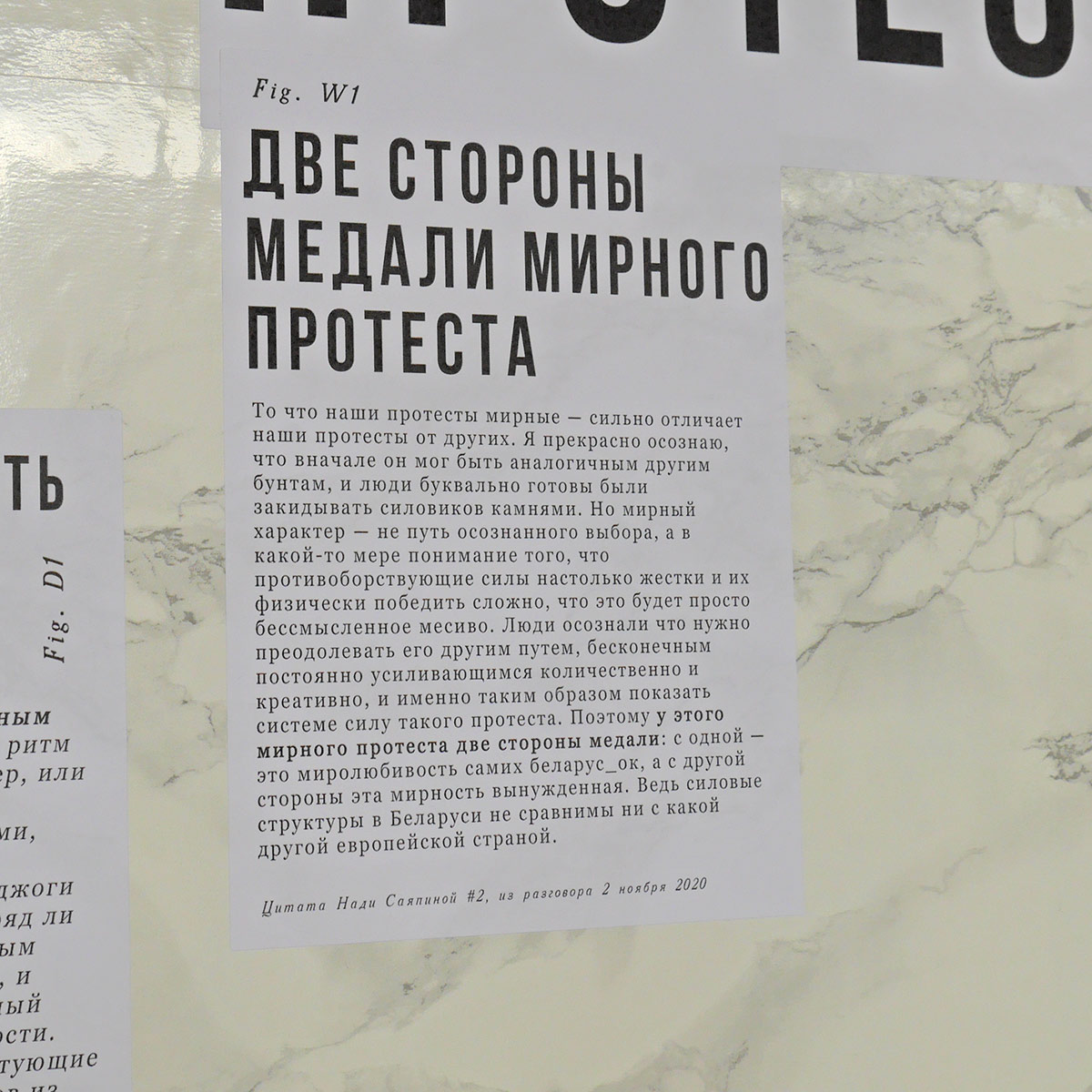
Quote by Nadya Sayapina # 2
The fact that our protests are peaceful makes our them very different from others. I am well aware that at first it could have been similar to other riots, and people were literally ready to throw stones at the riot police. But it was not a deliberate choice to have a peaceful protest, it happened rather because of understanding that the opposing forces are so violent, and it is difficult to defeat them physically that it will be just a useless mess. People realized that they need to defeat it in a different way – endlessly and continuously increasing the protest also in quantitative and creative ways, and in this was the way to show the system the power of this protest. Therefore, this peaceful protest has two sides to the coin: on the one hand, it is the peacefulness of the Belarusians themselves, and on the other hand, people had to act peacefully. After all, the structure of the military forces in Belarus cannot be compared with the ones in any other European country.
From a conversation on the 2nd of November 2020
This Peaceful Protest Has Two Sides to the Coin
The fact that our protests are peaceful makes our them very different from others. I am well aware that at first it could have been similar to other riots, and people were literally ready to throw stones at the riot police. But it was not a deliberate choice to have a peaceful protest, it happened rather because of understanding that the opposing forces are so violent, and it is difficult to defeat them physically that it will be just a useless mess. People realized that they need to defeat it in a different way – endlessly and continuously increasing the protest also in quantitative and creative ways, and in this was the way to show the system the power of this protest. Therefore, this peaceful protest has two sides to the coin: on the one hand, it is the peacefulness of the Belarusians themselves, and on the other hand, people had to act peacefully. After all, the structure of the military forces in Belarus cannot be compared with the ones in any other European country.
From a conversation on the 2nd of November 2020
Цитата Нади Саяпиной #2
Две стороны медали мирного протеста
То что наши протесты мирные – сильно отличает наши протесты от других. Я прекрасно осознаю, что вначале он мог быть аналогичным другим бунтам, и люди буквально готовы были закидывать силовиков камнями. Но мирный характер – не путь осознанного выбора, а в какой-то мере понимание того, что противоборствующие силы настолько жестки и их физически победить сложно, что это будет просто бессмысленное месиво. Люди осознали что нужно преодолевать его другим путем, бесконечным постоянно усиливающимся количественно и креативно, и именно таким образом показать системе силу такого протеста. Поэтому у этого мирного протеста две стороны медали: с одной – это миролюбивость самих беларус_ок, а с другой стороны эта мирность вынужденная. Ведь силовые структуры в Беларуси не сравнимы ни с какой другой европейской страной.
Из разговора 2 ноября 2020
Две стороны медали мирного протеста
То что наши протесты мирные – сильно отличает наши протесты от других. Я прекрасно осознаю, что вначале он мог быть аналогичным другим бунтам, и люди буквально готовы были закидывать силовиков камнями. Но мирный характер – не путь осознанного выбора, а в какой-то мере понимание того, что противоборствующие силы настолько жестки и их физически победить сложно, что это будет просто бессмысленное месиво. Люди осознали что нужно преодолевать его другим путем, бесконечным постоянно усиливающимся количественно и креативно, и именно таким образом показать системе силу такого протеста. Поэтому у этого мирного протеста две стороны медали: с одной – это миролюбивость самих беларус_ок, а с другой стороны эта мирность вынужденная. Ведь силовые структуры в Беларуси не сравнимы ни с какой другой европейской страной.
Из разговора 2 ноября 2020
Fig. X1
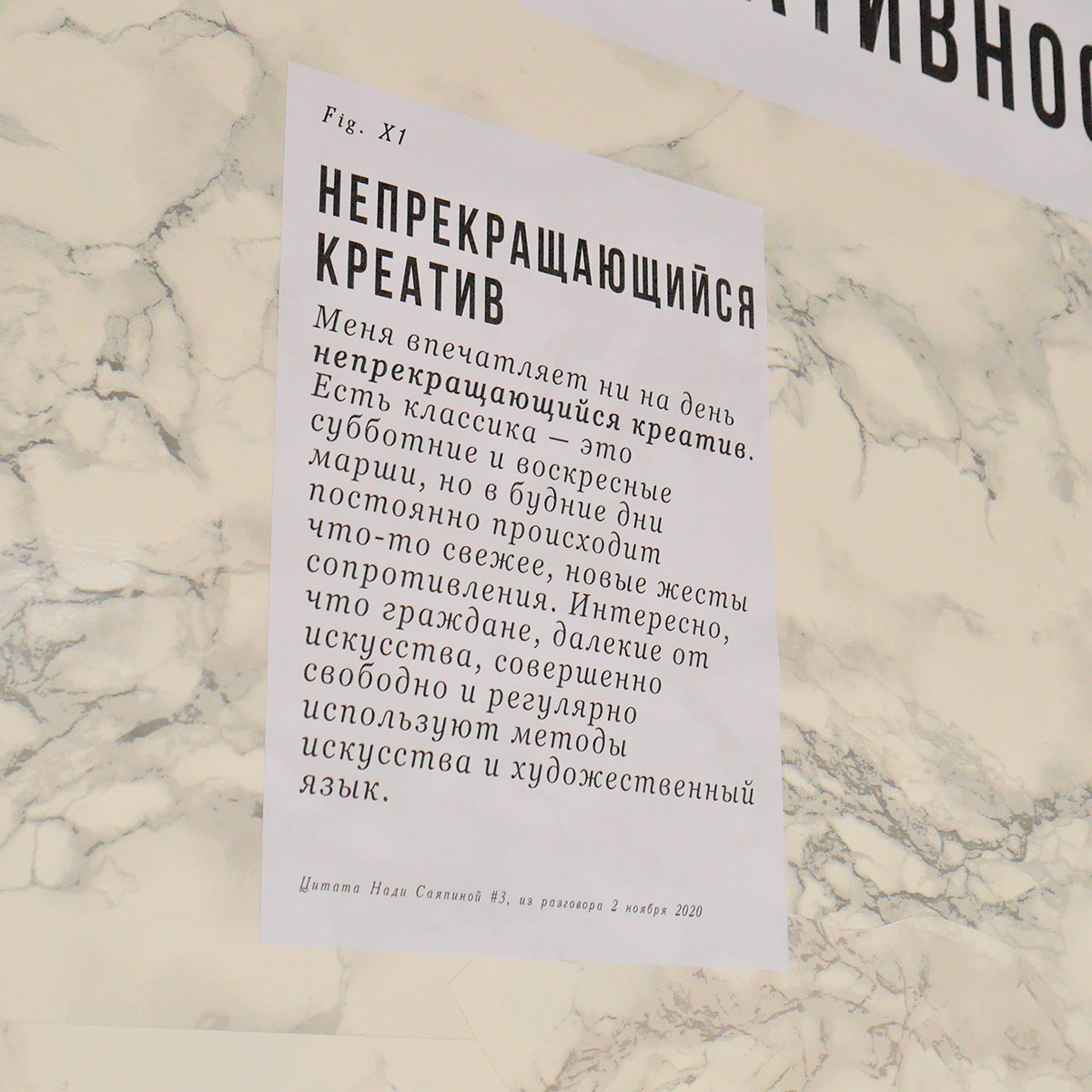
Quote by Nadya Sayapina # 3
Endless Creativity
I am impressed by the continuous creativity. Thea Saturday and Sunday marches became classics, but on weekdays something new and creative is constantly happening, new gestures of resistance. Interestingly, initiatives from citizens who used to be far from art use art methods and artistic language quite freely and regularly.
From a conversation on the 2nd of November 2020
Endless Creativity
I am impressed by the continuous creativity. Thea Saturday and Sunday marches became classics, but on weekdays something new and creative is constantly happening, new gestures of resistance. Interestingly, initiatives from citizens who used to be far from art use art methods and artistic language quite freely and regularly.
From a conversation on the 2nd of November 2020
Цитата Нади Саяпиной #3
Меня впечатляет ни на день непрекращающийся креатив. Есть классика – это субботние и воскресные марши, но в будние дни постоянно происходит что-то свежее, новые жесты сопротивления. Интересно, что граждане, далекие от искусства, совершенно свободно и регулярно используют методы искусства и художественный язык.
Из разговора 2 ноября 2020
Непрекращающийся креатив
Меня впечатляет ни на день непрекращающийся креатив. Есть классика – это субботние и воскресные марши, но в будние дни постоянно происходит что-то свежее, новые жесты сопротивления. Интересно, что граждане, далекие от искусства, совершенно свободно и регулярно используют методы искусства и художественный язык.
Из разговора 2 ноября 2020
Fig. Y1
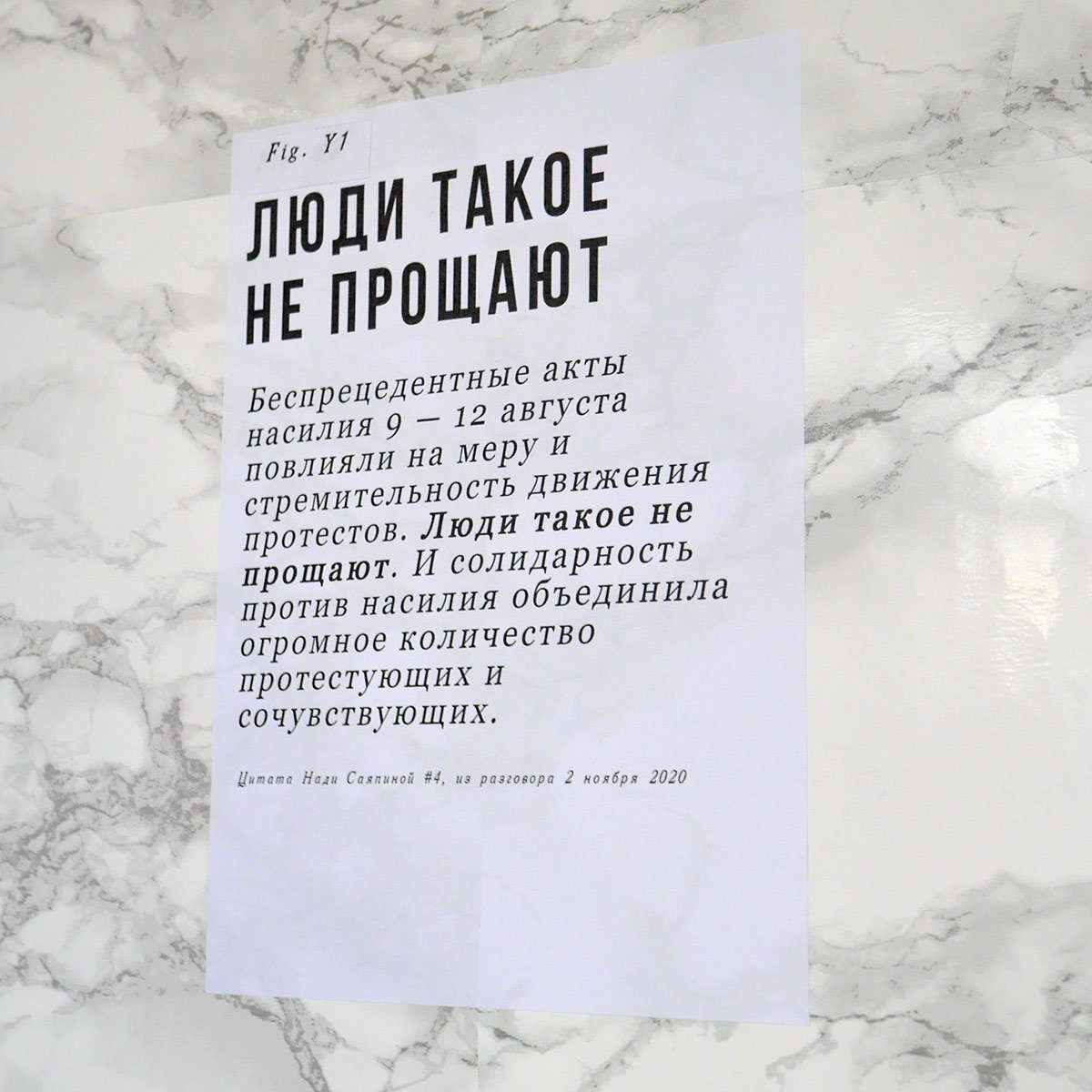
Quote by Nadya Sayapina # 4
The unprecedented acts of violence between the 9th and the 12th of August impacted the strength and velocity of the protest movement. People don't forgive that. And solidarity against violence has united a huge number of protesters and supporters.
From a conversation on the 2nd of November 2020
People Won't Forgive
The unprecedented acts of violence between the 9th and the 12th of August impacted the strength and velocity of the protest movement. People don't forgive that. And solidarity against violence has united a huge number of protesters and supporters.
From a conversation on the 2nd of November 2020
Цитата Нади Саяпиной #4
Люди такое не прощают
Беспрецедентные акты насилия 9 – 12 августа повлияли на меру и стремительность движения протестов. Люди такое не прощают. И солидарность против насилия объединила огромное количество протестующих и сочувствующих.
Из разговора 2 ноября 2020
Люди такое не прощают
Беспрецедентные акты насилия 9 – 12 августа повлияли на меру и стремительность движения протестов. Люди такое не прощают. И солидарность против насилия объединила огромное количество протестующих и сочувствующих.
Из разговора 2 ноября 2020
Fig. Z1
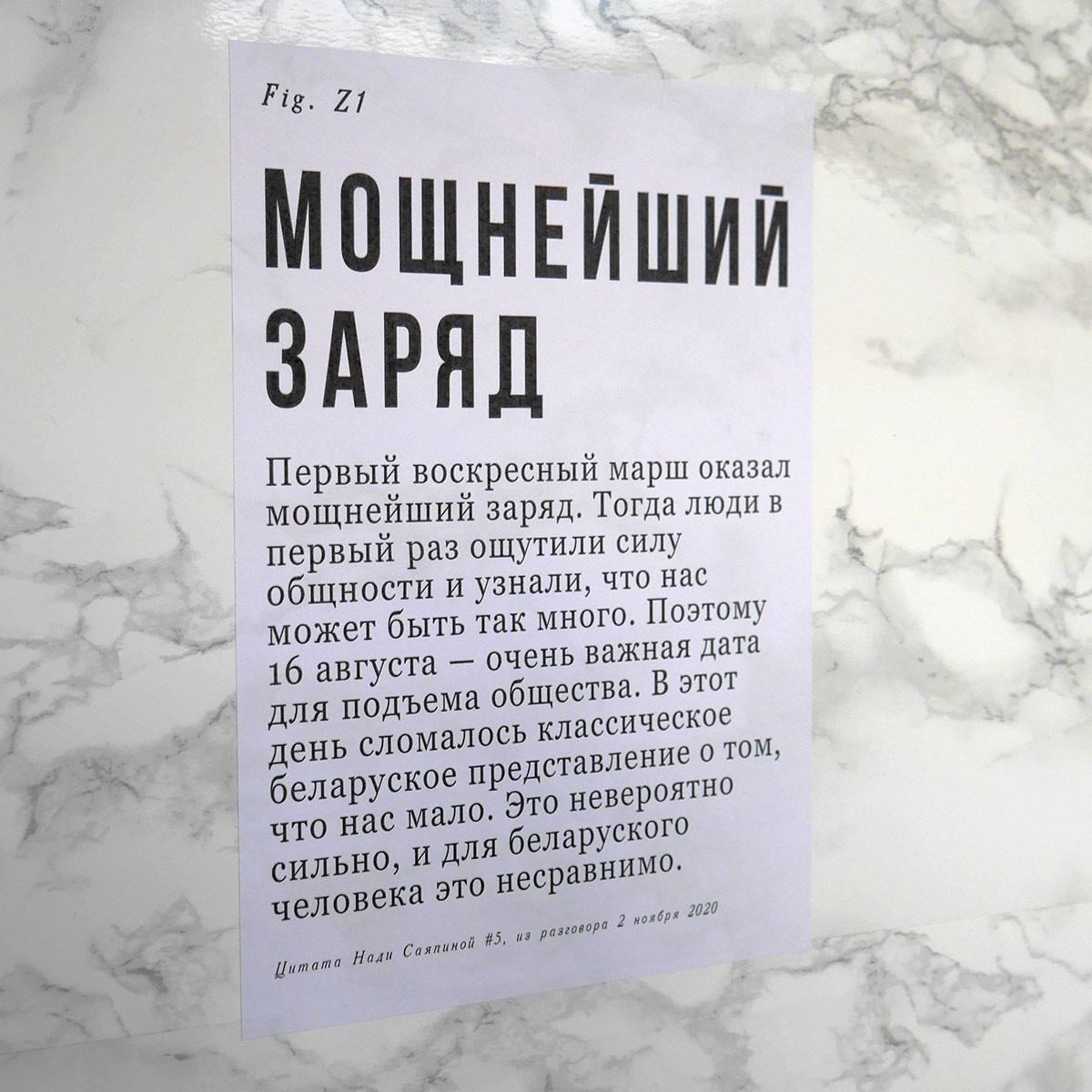
Quote by Nadya Sayapina # 5
Solidarity Energy Boost
The first Sunday march has charged people. Back then for the first time, people realized the power of a community and learned that there are so many of us, thinking alike. That’s why the 16th of August is a very important date for the rise of society. On that day, the well-believed Belarusian idea that there are not enough of us has broken down. This was incredibly strong, and for a Belarusian person nothing can compare with it.
From a conversation on the 2nd of November 2020
Solidarity Energy Boost
The first Sunday march has charged people. Back then for the first time, people realized the power of a community and learned that there are so many of us, thinking alike. That’s why the 16th of August is a very important date for the rise of society. On that day, the well-believed Belarusian idea that there are not enough of us has broken down. This was incredibly strong, and for a Belarusian person nothing can compare with it.
From a conversation on the 2nd of November 2020
Цитата Нади Саяпиной #5
Первый воскресный марш оказал мощнейший заряд. Тогда люди в первый раз ощутили силу общности и узнали, что нас может быть так много. Поэтому 16 августа – очень важная дата для подъема общества. В этот день сломалось классическое беларуское представление о том, что нас мало. Это невероятно сильно, и для беларуского человека это несравнимо.
Из разговора 2 ноября 2020
Мощнейший заряд
Первый воскресный марш оказал мощнейший заряд. Тогда люди в первый раз ощутили силу общности и узнали, что нас может быть так много. Поэтому 16 августа – очень важная дата для подъема общества. В этот день сломалось классическое беларуское представление о том, что нас мало. Это невероятно сильно, и для беларуского человека это несравнимо.
Из разговора 2 ноября 2020
2
Fig. A2
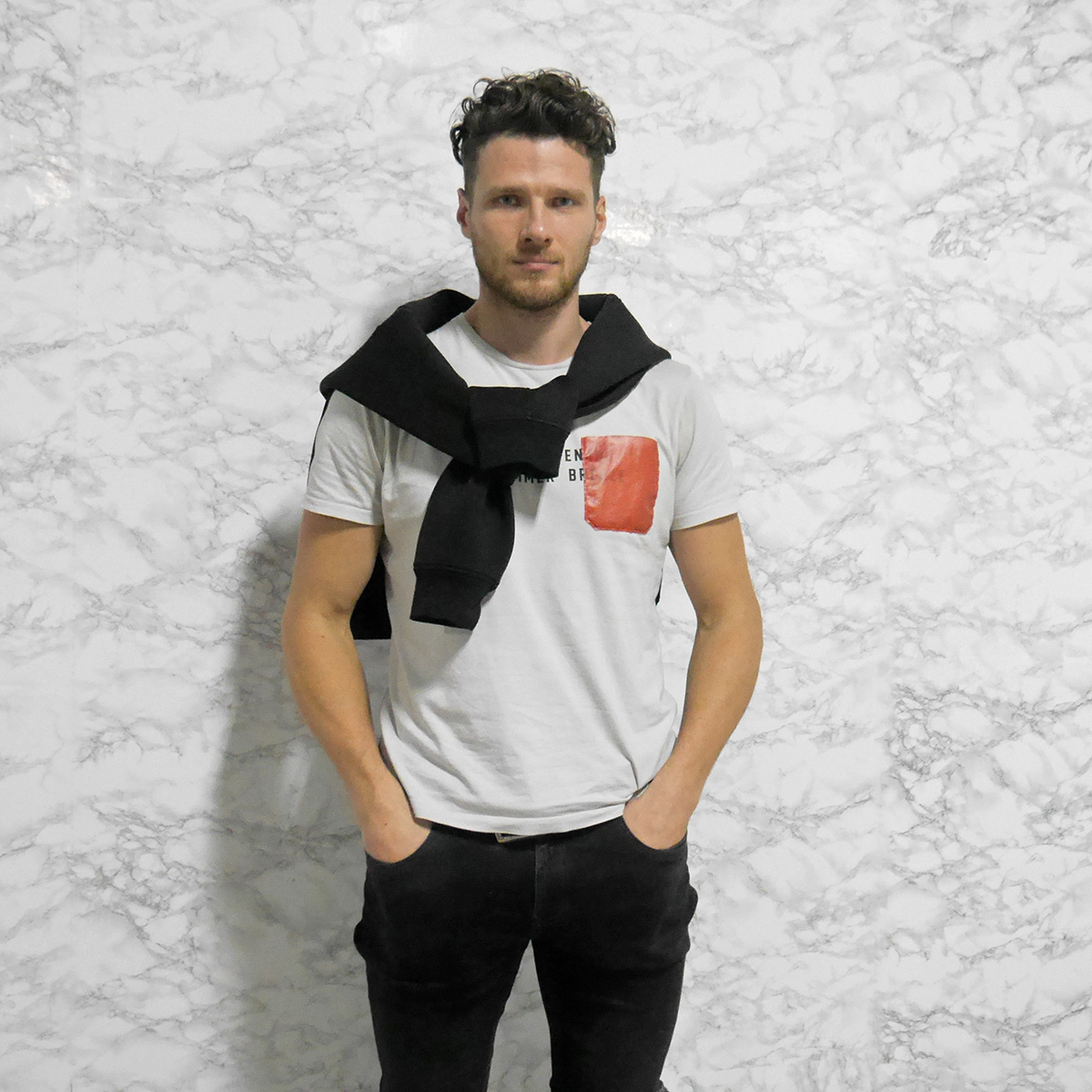
Contributor # 3
Alexey Kuzmich is a Belarusian artist, actionist. Was born in Minsk (Belarus). In artistic practice, he studies the socio-political context, transforming it into a resource for his art.
Forced to emigrate from Belarus because of political persecution for the performance "I Believe, or the Philister World of Political Animals" held on the day of the presidential elections in Belarus, after this performance he was detained, imprisoned in Okrestino, beaten there, then prosecuted under a falsified criminal record.
Lives and works in Minsk.
Alexey Kuzmich
Alexey Kuzmich is a Belarusian artist, actionist. Was born in Minsk (Belarus). In artistic practice, he studies the socio-political context, transforming it into a resource for his art.
Forced to emigrate from Belarus because of political persecution for the performance "I Believe, or the Philister World of Political Animals" held on the day of the presidential elections in Belarus, after this performance he was detained, imprisoned in Okrestino, beaten there, then prosecuted under a falsified criminal record.
Lives and works in Minsk.
Контрибьютор #3
Алексей Кузьмич
Алексей Кузьмич – беларуский художник, акционист. Родился в Минске (Беларусь). В художественной практике занимается исследованием социально-политического контекста, преобразуя его в материал для своего искусства.
Вынужден эмигрировать из Беларуси в связи с политическим преследованием после акции "Верую, или Филистерский мир политических животных", проведенной ко дню выборов президента РБ, после которой был задержан, помещен в Окрестино, избит, затем преследовался по фальсифицированной криминальной статье.
Живет и работает в Минске.
Алексей Кузьмич
Алексей Кузьмич – беларуский художник, акционист. Родился в Минске (Беларусь). В художественной практике занимается исследованием социально-политического контекста, преобразуя его в материал для своего искусства.
Вынужден эмигрировать из Беларуси в связи с политическим преследованием после акции "Верую, или Филистерский мир политических животных", проведенной ко дню выборов президента РБ, после которой был задержан, помещен в Окрестино, избит, затем преследовался по фальсифицированной криминальной статье.
Живет и работает в Минске.
Fig. B2
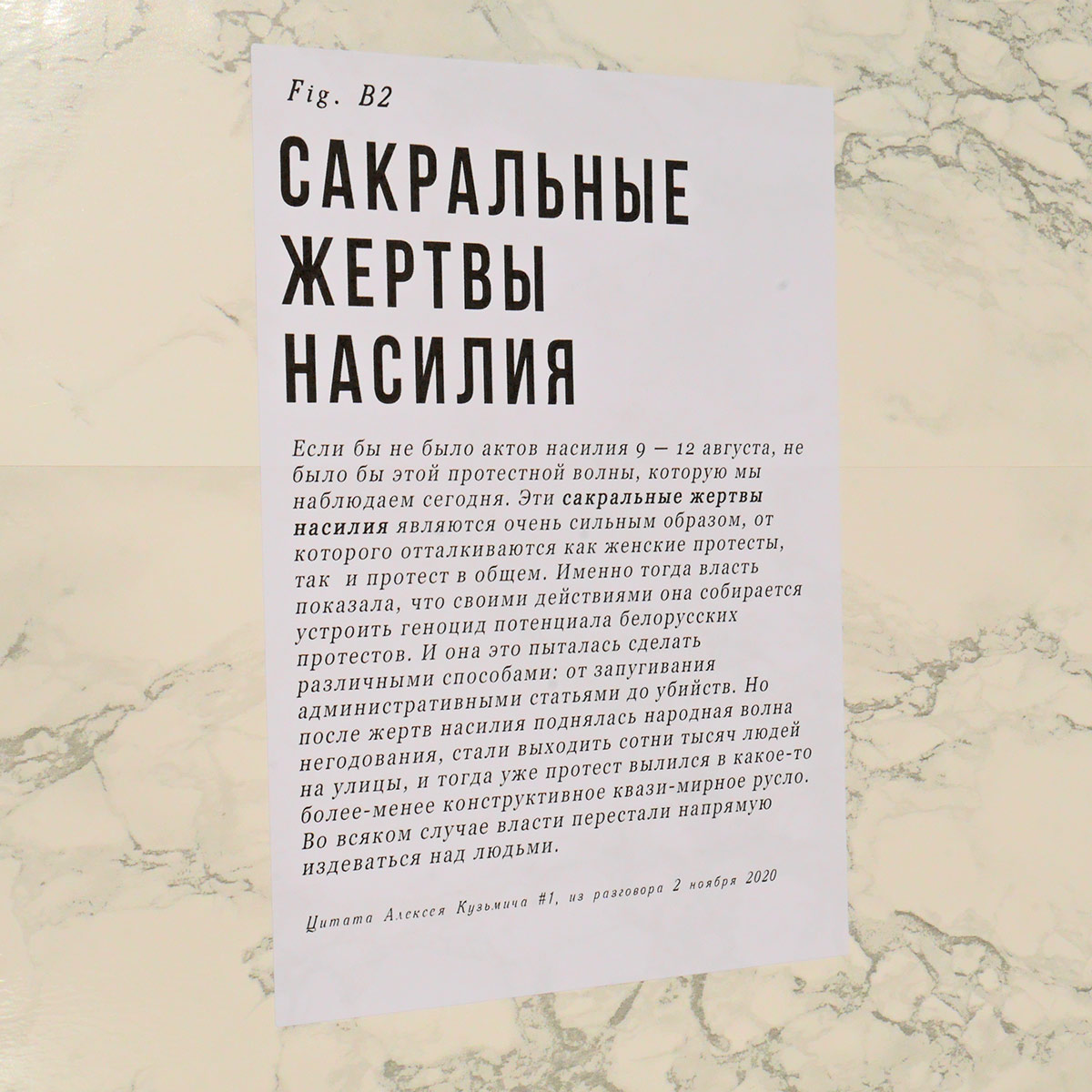
Quote by Alexey Kuzmich # 1
If there were no acts of violence on August 9 — 12, there would not have been this wave of protest that we are seeing these days. These sacred victims of violence are very powerful images inspiring both women's protests and protests in general. Back then the actions of authorities showed that they were going to arrange a genocide of the Belarusian protests. And the authorities tried to do this in various ways: from intimidation with administrative records to killing people. But after the acts of violence, a wave of resentment arose, hundreds of thousands of people went to the streets, and then the protest turned into more or less constructive quasi-peaceful mode. In any case, after that the authorities have stopped the violence.
From a conversation on the 2nd of November 2020
Sacred Victims of Violence
If there were no acts of violence on August 9 — 12, there would not have been this wave of protest that we are seeing these days. These sacred victims of violence are very powerful images inspiring both women's protests and protests in general. Back then the actions of authorities showed that they were going to arrange a genocide of the Belarusian protests. And the authorities tried to do this in various ways: from intimidation with administrative records to killing people. But after the acts of violence, a wave of resentment arose, hundreds of thousands of people went to the streets, and then the protest turned into more or less constructive quasi-peaceful mode. In any case, after that the authorities have stopped the violence.
From a conversation on the 2nd of November 2020
Цитата Алексея Кузьмича #1
Сакральные жертвы насилия
Если бы не было актов насилия 9 — 12 августа, не было бы этой протестной волны, которую мы наблюдаем сегодня. Эти сакральные жертвы насилия являются очень сильным образом, от которого отталкиваются как женские протесты, так и протест в общем. Именно тогда власть показала, что своими действиями она собирается устроить геноцид потенциала белорусских протестов. И она это пыталась сделать различными способами: от запугивания административными статьями до убийств. Но после жертв насилия поднялась народная волна негодования, стали выходить сотни тысяч людей на улицы, и тогда уже протест вылился в какое-то более-менее конструктивное квази-мирное русло. Во всяком случае власти перестали напрямую издеваться над людьми.
Из разговора 2 ноября 2020
Сакральные жертвы насилия
Если бы не было актов насилия 9 — 12 августа, не было бы этой протестной волны, которую мы наблюдаем сегодня. Эти сакральные жертвы насилия являются очень сильным образом, от которого отталкиваются как женские протесты, так и протест в общем. Именно тогда власть показала, что своими действиями она собирается устроить геноцид потенциала белорусских протестов. И она это пыталась сделать различными способами: от запугивания административными статьями до убийств. Но после жертв насилия поднялась народная волна негодования, стали выходить сотни тысяч людей на улицы, и тогда уже протест вылился в какое-то более-менее конструктивное квази-мирное русло. Во всяком случае власти перестали напрямую издеваться над людьми.
Из разговора 2 ноября 2020
Fig. C2
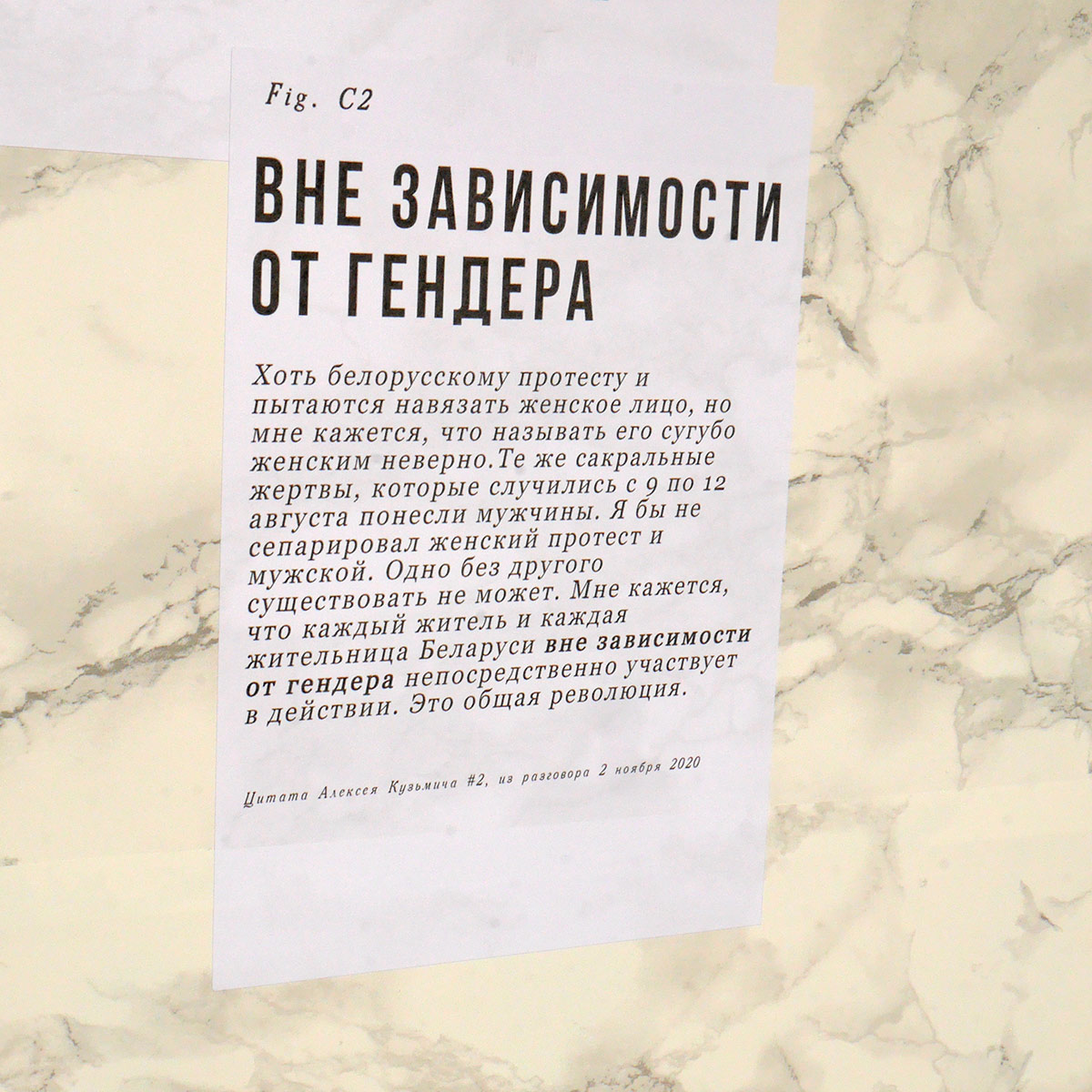
Quote by Alexey Kuzmich #1
Although they are trying to impose a female face on the Belarusian protest, it seems to me that it is wrong to call it a purely female face. The same sacral victims that happened between 9 and 12 August were men. I would not separate the female protest from the male one. One cannot exist without the other. It seems to me that every resident in Belarus, regardless of gender, is directly involved in the action. This is a common revolution.
From a conversation on November 2, 2020
Regardless of Gender
Although they are trying to impose a female face on the Belarusian protest, it seems to me that it is wrong to call it a purely female face. The same sacral victims that happened between 9 and 12 August were men. I would not separate the female protest from the male one. One cannot exist without the other. It seems to me that every resident in Belarus, regardless of gender, is directly involved in the action. This is a common revolution.
From a conversation on November 2, 2020
Цитата Алексея Кузьмича #2
Вне зависимости от гендера
Хоть белорусскому протесту и пытаются навязать женское лицо, но мне кажется, что называть его сугубо женским неверно.Те же сакральные жертвы, которые случились с 9 по 12 августа понесли мужчины. Я бы не сепарировал женский протест и мужской. Одно без другого существовать не может. Мне кажется, что каждый житель и каждая жительница Беларуси вне зависимости от гендера непосредственно участвует в действии. Это общая революция.
Из разговора 2 ноября 2020
Вне зависимости от гендера
Хоть белорусскому протесту и пытаются навязать женское лицо, но мне кажется, что называть его сугубо женским неверно.Те же сакральные жертвы, которые случились с 9 по 12 августа понесли мужчины. Я бы не сепарировал женский протест и мужской. Одно без другого существовать не может. Мне кажется, что каждый житель и каждая жительница Беларуси вне зависимости от гендера непосредственно участвует в действии. Это общая революция.
Из разговора 2 ноября 2020
Fig. D2
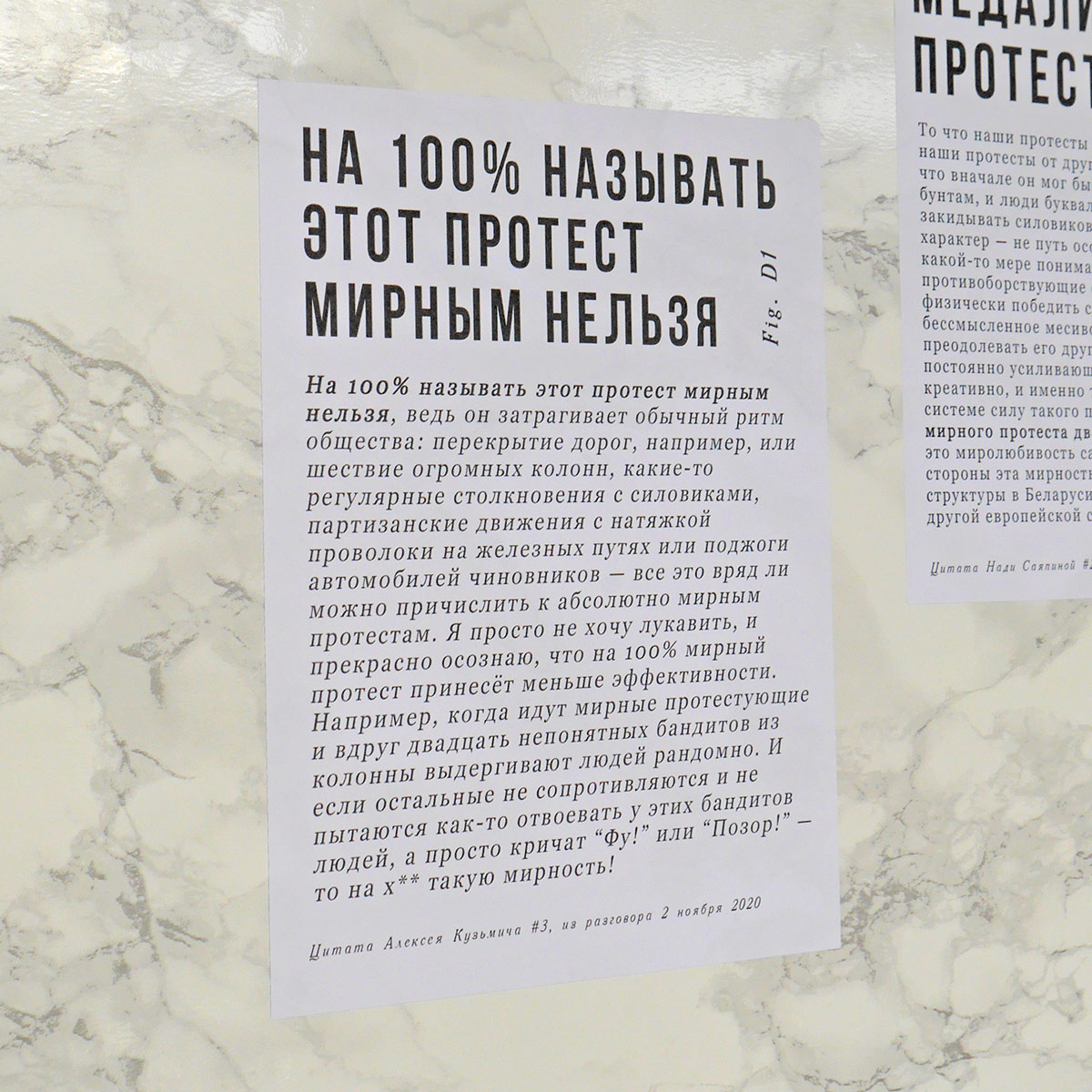
Quote by Alexey Kuzmich # 3
This protest cannot be called 100% peaceful, because it affects the normal rhythm of society: blocking roads, for example, or processions of huge columns, some regular clashes with security forces, partisan movements with stretched wire on railway tracks or arson attacks on official cars - can hardly be counted as absolutely peaceful protests. I just don't want to be sly, and I am well aware that 100% peaceful protest will be less effective. For example, when there are peaceful protesters and suddenly twenty ambiguous bandits pull people out of the column randomly. And if others don't resist and try to take people away from these bandits, but only shout "Ew!" or "Shame!" - then f*** this peacefulness!
From a conversation on 2 November 2020
One Cannot Call this Protest 100% Peaceful
This protest cannot be called 100% peaceful, because it affects the normal rhythm of society: blocking roads, for example, or processions of huge columns, some regular clashes with security forces, partisan movements with stretched wire on railway tracks or arson attacks on official cars - can hardly be counted as absolutely peaceful protests. I just don't want to be sly, and I am well aware that 100% peaceful protest will be less effective. For example, when there are peaceful protesters and suddenly twenty ambiguous bandits pull people out of the column randomly. And if others don't resist and try to take people away from these bandits, but only shout "Ew!" or "Shame!" - then f*** this peacefulness!
From a conversation on 2 November 2020
Цитата Алексея Кузьмича #3
На 100% называть этот протест мирным нельзя
На 100% называть этот протест мирным нельзя, ведь он затрагивает обычный ритм общества: перекрытие дорог, например, или шествие огромных колонн, какие-то регулярные столкновения с силовиками, партизанские движения с натяжкой проволоки на железных путях или поджоги автомобилей чиновников — все это вряд ли можно причислить к абсолютно мирным протестам. Я просто не хочу лукавить, и прекрасно осознаю, что на 100% мирный протест принесёт меньше эффективности. Например, когда идут мирные протестующие и вдруг двадцать непонятных бандитов из колонны выдергивают людей рандомно. И если остальные не сопротивляются и не пытаются как-то отвоевать у этих бандитов людей, а просто кричат “Фу!” или “Позор!” — то на х** такую мирность!
Из разговора 2 ноября 2020
На 100% называть этот протест мирным нельзя
На 100% называть этот протест мирным нельзя, ведь он затрагивает обычный ритм общества: перекрытие дорог, например, или шествие огромных колонн, какие-то регулярные столкновения с силовиками, партизанские движения с натяжкой проволоки на железных путях или поджоги автомобилей чиновников — все это вряд ли можно причислить к абсолютно мирным протестам. Я просто не хочу лукавить, и прекрасно осознаю, что на 100% мирный протест принесёт меньше эффективности. Например, когда идут мирные протестующие и вдруг двадцать непонятных бандитов из колонны выдергивают людей рандомно. И если остальные не сопротивляются и не пытаются как-то отвоевать у этих бандитов людей, а просто кричат “Фу!” или “Позор!” — то на х** такую мирность!
Из разговора 2 ноября 2020
Fig. E2
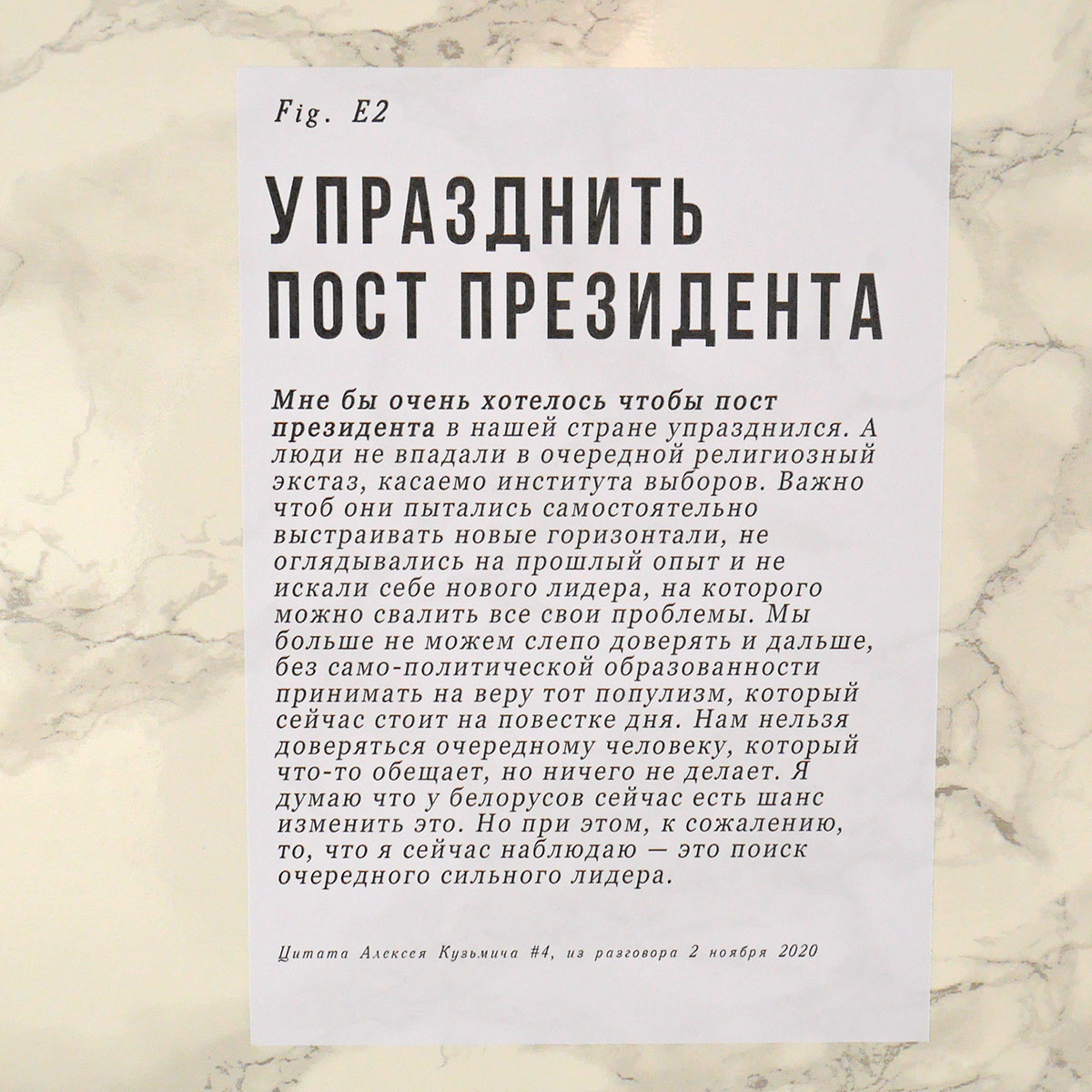
Quote by Alexey Kuzmich # 4
I would prefer the presidency in our country to be abolished. And people wouldn’t get so excited about the elections. It is important that people try to build new horizons on their own, do not look back at the past experience and do not look for a new leader whom they can claim responsible for all their problems. We can no longer blindly trust and without self-political education believe the populism that is spread nowadays. We cannot trust the next person who promises something but does nothing. I think that Belarusians now have a chance to change this. But, unfortunately, what I can see now is the search for another strong leader.
From a conversation on the 2nd of November 2020
Abolish the Presidency
I would prefer the presidency in our country to be abolished. And people wouldn’t get so excited about the elections. It is important that people try to build new horizons on their own, do not look back at the past experience and do not look for a new leader whom they can claim responsible for all their problems. We can no longer blindly trust and without self-political education believe the populism that is spread nowadays. We cannot trust the next person who promises something but does nothing. I think that Belarusians now have a chance to change this. But, unfortunately, what I can see now is the search for another strong leader.
From a conversation on the 2nd of November 2020
Цитата Алексея Кузьмича #4
Мне бы очень хотелось чтобы пост президента в нашей стране упразднился. А люди не впадали в очередной религиозный экстаз, касаемо института выборов. Важно чтоб они пытались самостоятельно выстраивать новые горизонтали, не оглядывались на прошлый опыт и не искали себе нового лидера, на которого можно свалить все свои проблемы. Мы больше не можем слепо доверять и дальше, без само-политической образованности принимать на веру тот популизм, который сейчас стоит на повестке дня. Нам нельзя доверяться очередному человеку, который что-то обещает, но ничего не делает. Я думаю что у белорусов сейчас есть шанс изменить это. Но при этом, к сожалению, то, что я сейчас наблюдаю — это поиск очередного сильного лидера.
Из разговора 2 ноября 2020
Упразднить пост президента
Мне бы очень хотелось чтобы пост президента в нашей стране упразднился. А люди не впадали в очередной религиозный экстаз, касаемо института выборов. Важно чтоб они пытались самостоятельно выстраивать новые горизонтали, не оглядывались на прошлый опыт и не искали себе нового лидера, на которого можно свалить все свои проблемы. Мы больше не можем слепо доверять и дальше, без само-политической образованности принимать на веру тот популизм, который сейчас стоит на повестке дня. Нам нельзя доверяться очередному человеку, который что-то обещает, но ничего не делает. Я думаю что у белорусов сейчас есть шанс изменить это. Но при этом, к сожалению, то, что я сейчас наблюдаю — это поиск очередного сильного лидера.
Из разговора 2 ноября 2020
Fig. F2

Quote by Alexey Kuzmich # 5
It seems to me that what is happening in Belarus now is not new to the history of revolutions, but a great rarity. If you can make such a revolution without blood, and if it doesn't take some incredible amount of time, it will be extremely important. I really hope that this form of protest will gain popularity in the world because people should not die for a single idea. Any idea has much less weight than human life. It doesn't matter at all what kind of idea it is, no idea is worth losing people's lives for. Dying for some revolution, for some democracy, and even more so for some politicians is bullshit. So if peaceful protest proves to be a constructive force for solving complex political issues - that would be great.
From the conversation on the 2nd of November 2020
The Bloodless Revolution
It seems to me that what is happening in Belarus now is not new to the history of revolutions, but a great rarity. If you can make such a revolution without blood, and if it doesn't take some incredible amount of time, it will be extremely important. I really hope that this form of protest will gain popularity in the world because people should not die for a single idea. Any idea has much less weight than human life. It doesn't matter at all what kind of idea it is, no idea is worth losing people's lives for. Dying for some revolution, for some democracy, and even more so for some politicians is bullshit. So if peaceful protest proves to be a constructive force for solving complex political issues - that would be great.
From the conversation on the 2nd of November 2020
Цитата Алексея Кузьмича #5
Революция без крови
Мне кажется то, что сейчас происходит в Беларуси — это не новинка для истории революций, но большая редкость. Если получится провести такую революцию без крови, и если она не займёт какого-то невероятного количества времени, то это будет крайне важным. Я очень надеюсь, что такая форма протеста получит популярность в мире, ведь люди не должны умирать ни за одну идею. Любая идея имеет намного меньший вес человеческой жизни. Совершенно неважно какая это идея, ни одна не стоит того, чтобы за неё люди лишались жизни. Умирать за какую-то революцию, за какую-то демократию, и тем более за каких-то политиков — это полнейшая чушь. Поэтому если мирный протест зарекомендует себя как действительно конструктивную силу для решения сложных политических вопросов — это будет прекрасно.
Из разговора 2 ноября 2020
Революция без крови
Мне кажется то, что сейчас происходит в Беларуси — это не новинка для истории революций, но большая редкость. Если получится провести такую революцию без крови, и если она не займёт какого-то невероятного количества времени, то это будет крайне важным. Я очень надеюсь, что такая форма протеста получит популярность в мире, ведь люди не должны умирать ни за одну идею. Любая идея имеет намного меньший вес человеческой жизни. Совершенно неважно какая это идея, ни одна не стоит того, чтобы за неё люди лишались жизни. Умирать за какую-то революцию, за какую-то демократию, и тем более за каких-то политиков — это полнейшая чушь. Поэтому если мирный протест зарекомендует себя как действительно конструктивную силу для решения сложных политических вопросов — это будет прекрасно.
Из разговора 2 ноября 2020
Fig. G2
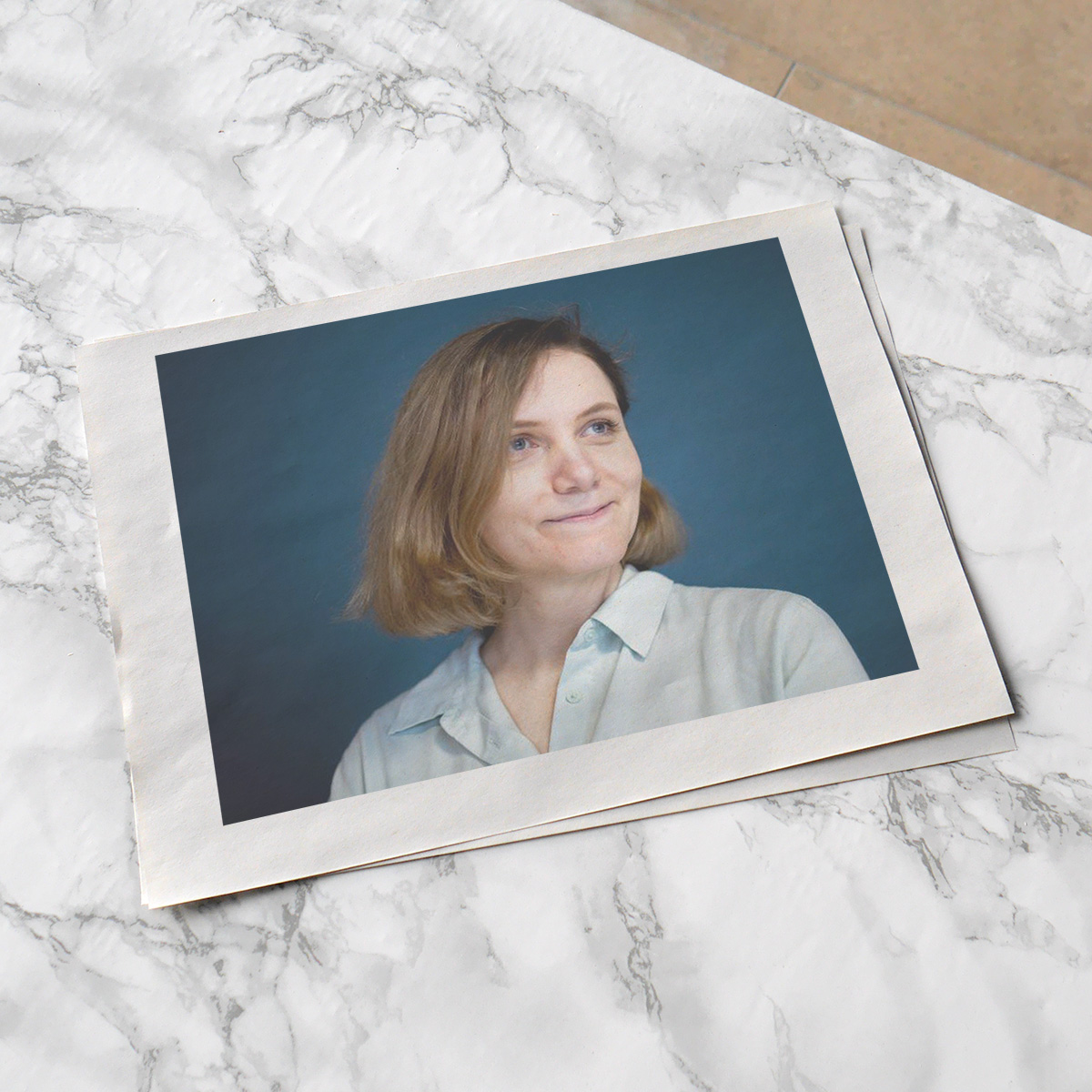
Contributor #4
Antonina Stebur — curator, researcher. Graduated from EHU (Vilnius), School of Engaged Art "Chto Delat" (St. Petersburg).
Research interests: self-organisation, care, reassembly of the collectivity, utopian models of the future.
Lives and works in Moscow.
Photo: Violetta Savchitz ©
Antonina Stebur
Antonina Stebur — curator, researcher. Graduated from EHU (Vilnius), School of Engaged Art "Chto Delat" (St. Petersburg).
Research interests: self-organisation, care, reassembly of the collectivity, utopian models of the future.
Lives and works in Moscow.
Photo: Violetta Savchitz ©
Контрибьюторка #4
Исследовательские интересы: самоорганизация, забота, пересборка коллективности, утопические модели будущего.
Живет и работает в Москве.
Фото: Виолетта Савчиц © (предоставлено контрибьюторкой)
Антонина Стебур
Антонина Стебур — кураторка, исследовательница. Закончила магистратуру ЕГУ (Вильнюс), Школу вовлеченного искусства "Что делать?" (Спб).
Исследовательские интересы: самоорганизация, забота, пересборка коллективности, утопические модели будущего.
Живет и работает в Москве.
Фото: Виолетта Савчиц © (предоставлено контрибьюторкой)
Fig. H2
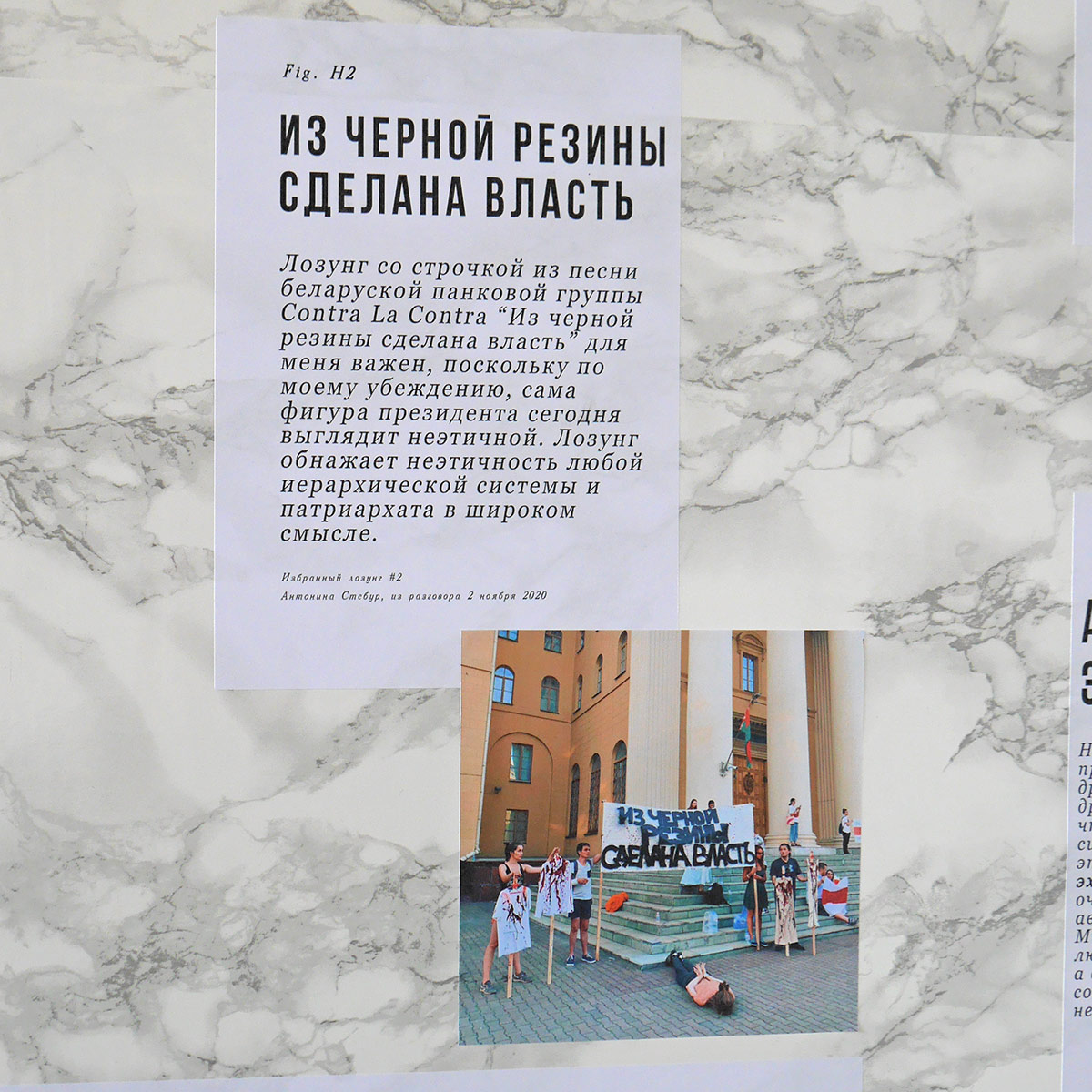
Selected slogan #2
Power is Made of Black Rubber
The slogan with a line from the song Power is Made of Black Rubber by the Belarusian punk band Contra La Contra is important to me, because I am convinced that the very figure of the president today looks unethical. The slogan exposes the unethical nature of any hierarchical system and patriarchate in the broad sense.
Antonina Stebur, from the conversation on the 2nd of November 2020
Power is Made of Black Rubber
The slogan with a line from the song Power is Made of Black Rubber by the Belarusian punk band Contra La Contra is important to me, because I am convinced that the very figure of the president today looks unethical. The slogan exposes the unethical nature of any hierarchical system and patriarchate in the broad sense.
Antonina Stebur, from the conversation on the 2nd of November 2020
Избранный лозунг #2
Из черной резины сделана власть
Лозунг со строчкой из песни беларуской панковой группы Contra La Contra “Из черной резины сделана власть” для меня важен, поскольку по моему убеждению, сама фигура президента сегодня выглядит неэтичной. Лозунг обнажает неэтичность любой иерархической системы и патриархата в широком смысле.
Антонина Стебур, из разговора 2 ноября 2020
Из черной резины сделана власть
Лозунг со строчкой из песни беларуской панковой группы Contra La Contra “Из черной резины сделана власть” для меня важен, поскольку по моему убеждению, сама фигура президента сегодня выглядит неэтичной. Лозунг обнажает неэтичность любой иерархической системы и патриархата в широком смысле.
Антонина Стебур, из разговора 2 ноября 2020
Fig. I2
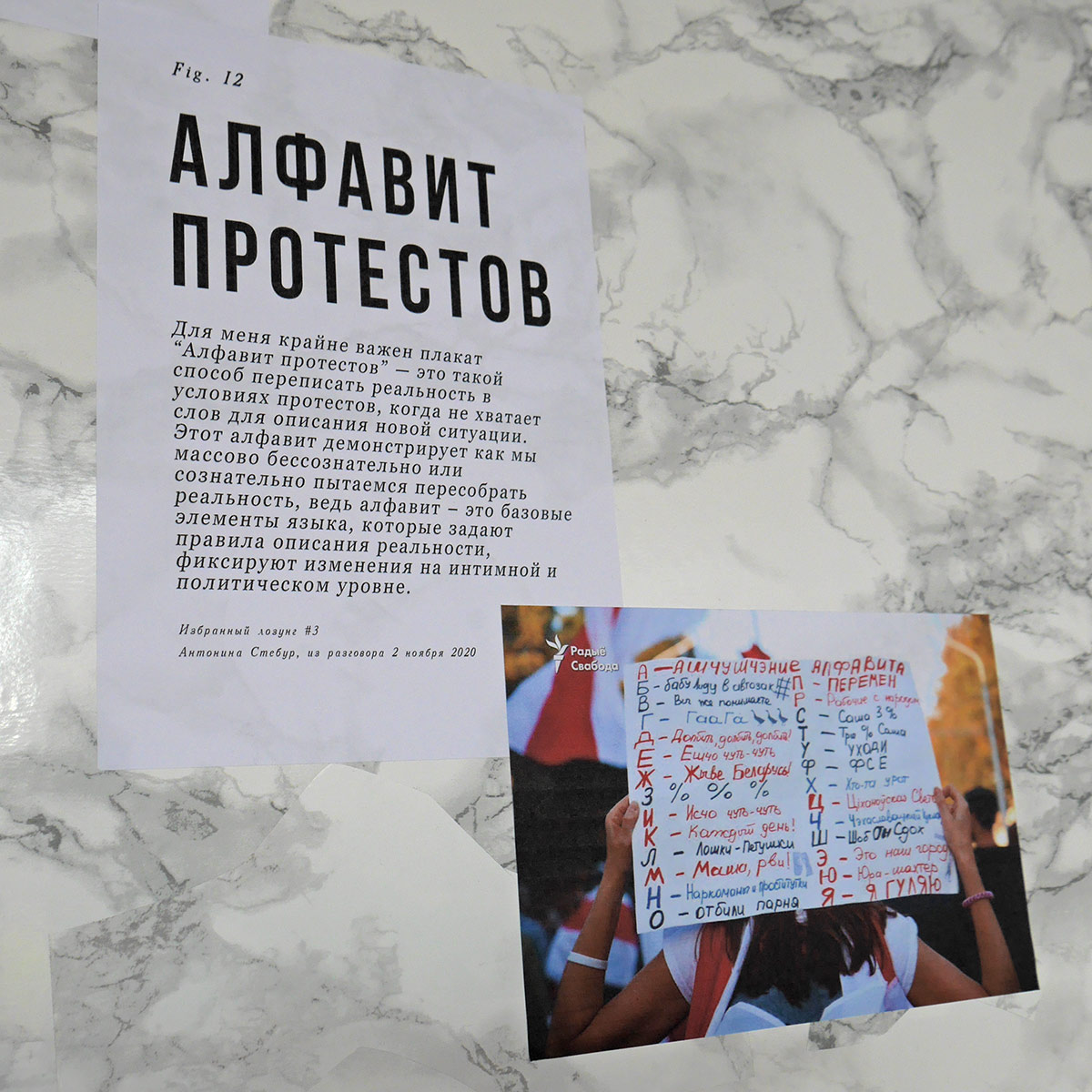
Selected slogan #3
The poster Alphabet of Protests is extremely important for me - it is a way to rewrite reality when protests are going on, when there are not enough words to describe a new situation. This alphabet demonstrates how we are massively, unconsciously or consciously trying to reassemble reality, because the alphabet is a basic element of a language that sets the rules to describe reality, fixates the changes at a personal and political level.
Antonina Stebur, from a conversation on the 2nd of November 2020
Photo credit: Radio Svaboda ©
The Alphabet of Protests
The poster Alphabet of Protests is extremely important for me - it is a way to rewrite reality when protests are going on, when there are not enough words to describe a new situation. This alphabet demonstrates how we are massively, unconsciously or consciously trying to reassemble reality, because the alphabet is a basic element of a language that sets the rules to describe reality, fixates the changes at a personal and political level.
Antonina Stebur, from a conversation on the 2nd of November 2020
Photo credit: Radio Svaboda ©
Избранный лозунг #3
Для меня крайне важен плакат “Алфавит протестов” — это такой способ переписать реальность в условиях протестов, когда не хватает слов для описания новой ситуации. Этот алфавит демонстрирует как мы массово бессознательно или сознательно пытаемся пересобрать реальность, ведь алфавит – это базовые элементы языка, которые задают правила описания реальности, фиксируют изменения на интимной и политическом уровне.
Антонина Стебур, из разговора 2 ноября 2020
Фото: Радыё Свабода ©
Алфавит протестов
Для меня крайне важен плакат “Алфавит протестов” — это такой способ переписать реальность в условиях протестов, когда не хватает слов для описания новой ситуации. Этот алфавит демонстрирует как мы массово бессознательно или сознательно пытаемся пересобрать реальность, ведь алфавит – это базовые элементы языка, которые задают правила описания реальности, фиксируют изменения на интимной и политическом уровне.
Антонина Стебур, из разговора 2 ноября 2020
Фото: Радыё Свабода ©
Fig. J2
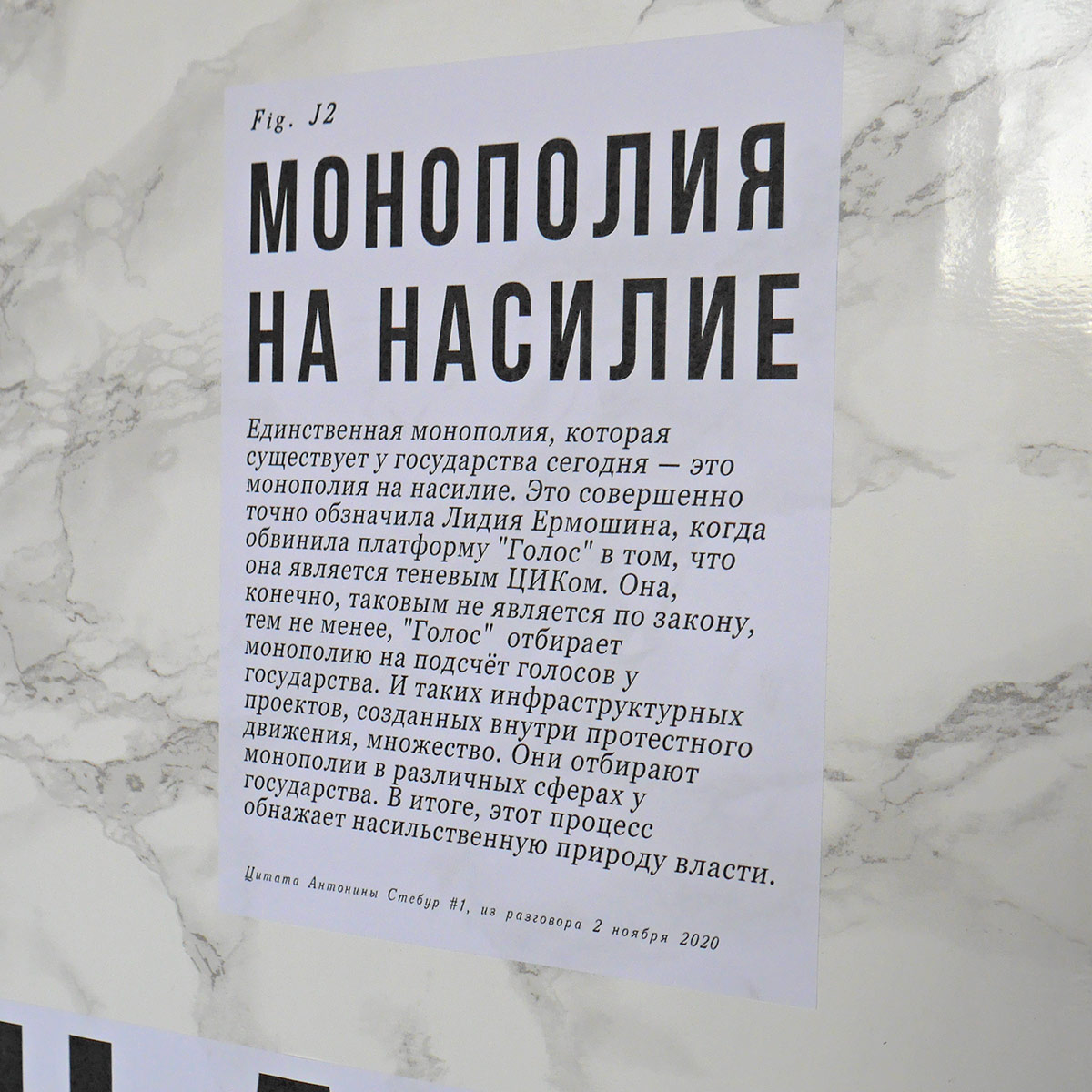
Quote by Antonina Stebur # 1
The only monopoly the state has today is a monopoly on violence. Lydia Ermoshyna clearly indicated this when she accused the platform “Voice” of being an illegitimate copy of the Central Election Committee. Of course, it is not so by law, nevertheless, "Voice" takes away from the state the monopoly on counting votes. And there are a lot of infrastructure projects like this one that were created during the protest movement. They take away monopolies from the state in various spheres. Ultimately, this process reveals the violent nature of the state.
From a conversation on the 2nd of November 2020
Monopoly on Violence
The only monopoly the state has today is a monopoly on violence. Lydia Ermoshyna clearly indicated this when she accused the platform “Voice” of being an illegitimate copy of the Central Election Committee. Of course, it is not so by law, nevertheless, "Voice" takes away from the state the monopoly on counting votes. And there are a lot of infrastructure projects like this one that were created during the protest movement. They take away monopolies from the state in various spheres. Ultimately, this process reveals the violent nature of the state.
From a conversation on the 2nd of November 2020
Цитата Антонины Стебур #1
Единственная монополия, которая существует у государства сегодня — это монополия на насилие. Это совершенно точно обзначила Лидия Ермошина, когда обвинила платформу "Голос" в том, что она является теневым ЦИКом. Она, конечно, таковым не является по закону, тем не менее, "Голос" отбирает монополию на подсчёт голосов у государства. И таких инфраструктурных проектов, созданных внутри протестного движения, множество. Они отбирают монополии в различных сферах у государства. В итоге, этот процесс обнажает насильственную природу власти.
Из разговора 2 ноября 2020
Монополия на насилие
Единственная монополия, которая существует у государства сегодня — это монополия на насилие. Это совершенно точно обзначила Лидия Ермошина, когда обвинила платформу "Голос" в том, что она является теневым ЦИКом. Она, конечно, таковым не является по закону, тем не менее, "Голос" отбирает монополию на подсчёт голосов у государства. И таких инфраструктурных проектов, созданных внутри протестного движения, множество. Они отбирают монополии в различных сферах у государства. В итоге, этот процесс обнажает насильственную природу власти.
Из разговора 2 ноября 2020
Fig. K2
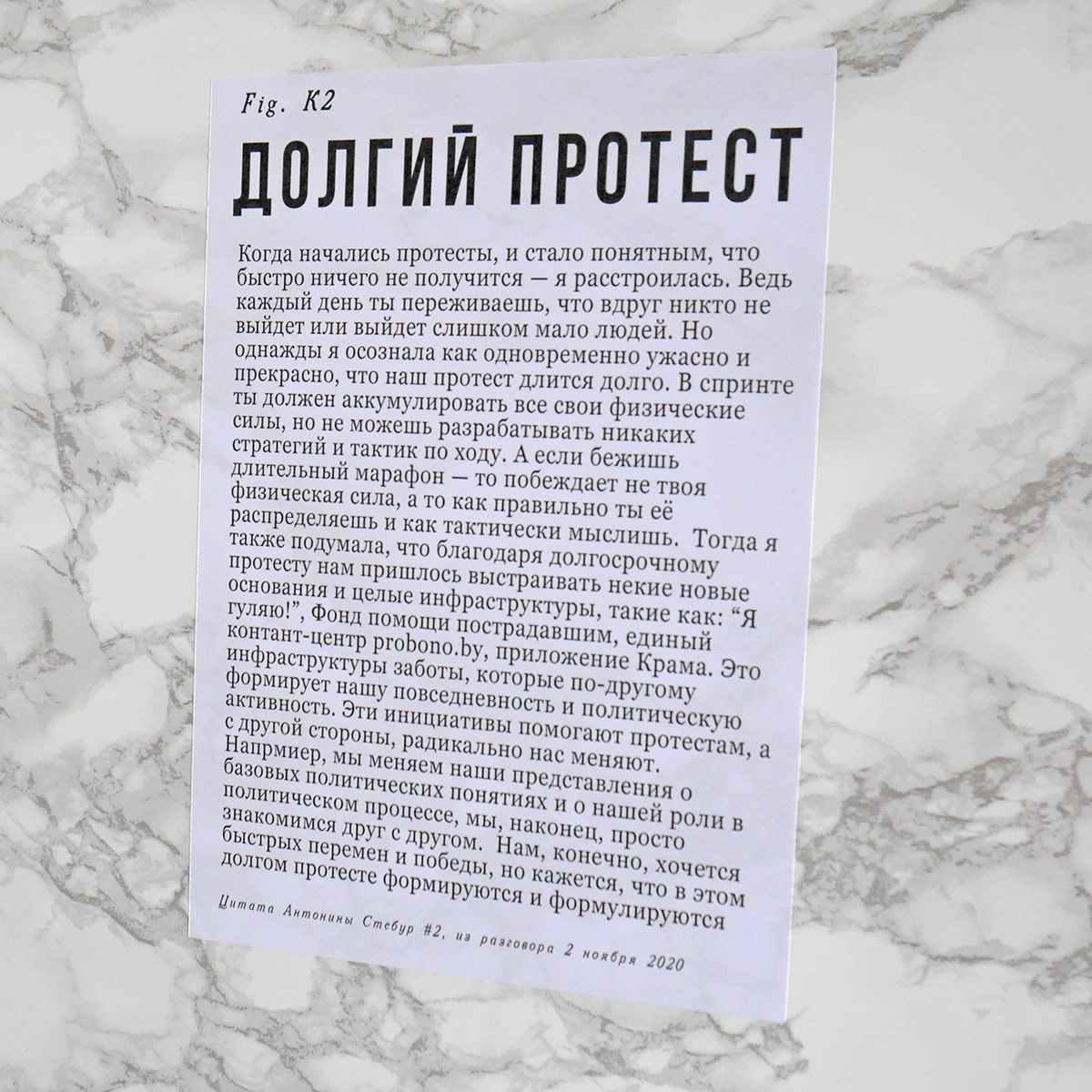
Quote by Antonina Stebur #2
When the protests started, and it became clear that nothing would happen quickly, I was upset. After all, every day you worry that suddenly no one will come out or too few people will. But one day I realized how terrible and wonderful it is at the same time that our protest lasts a long time. In a sprint you have to accumulate all your physical strength, but you can't develop any strategies and tactics as you go. And if you run a long marathon, it's not your physical strength that wins, but how you distribute it correctly and how you think tactically. At that time I also thought that thanks to the long-term protest we had to build some new foundations and whole infrastructures, such as: "I'm walking!", the Foundation for Assistance to Victims, a single contact center probono.by, Krama application. These are the infrastructures of care, which in a different way form our daily life and political activity. These initiatives help protest, but on the other hand, radically change us. For example, we change our ideas about basic political concepts and our role in the political process, we finally just get to know each other. Of course, we want quick changes and victories, but it seems that in this long protest very important moments are formed and articulated.
From the conversation on the 2nd of November 2020
Long Protest
When the protests started, and it became clear that nothing would happen quickly, I was upset. After all, every day you worry that suddenly no one will come out or too few people will. But one day I realized how terrible and wonderful it is at the same time that our protest lasts a long time. In a sprint you have to accumulate all your physical strength, but you can't develop any strategies and tactics as you go. And if you run a long marathon, it's not your physical strength that wins, but how you distribute it correctly and how you think tactically. At that time I also thought that thanks to the long-term protest we had to build some new foundations and whole infrastructures, such as: "I'm walking!", the Foundation for Assistance to Victims, a single contact center probono.by, Krama application. These are the infrastructures of care, which in a different way form our daily life and political activity. These initiatives help protest, but on the other hand, radically change us. For example, we change our ideas about basic political concepts and our role in the political process, we finally just get to know each other. Of course, we want quick changes and victories, but it seems that in this long protest very important moments are formed and articulated.
From the conversation on the 2nd of November 2020
Цитата Антонины Стебур #2
Долгий протест
Когда начались протесты, и стало понятным, что быстро ничего не получится — я расстроилась. Ведь каждый день ты переживаешь, что вдруг никто не выйдет или выйдет слишком мало людей. Но однажды я осознала как одновременно ужасно и прекрасно, что наш протест длится долго. В спринте ты должен аккумулировать все свои физические силы, но не можешь разрабатывать никаких стратегий и тактик по ходу. А если бежишь длительный марафон — то побеждает не твоя физическая сила, а то как правильно ты её распределяешь и как тактически мыслишь. Тогда я также подумала, что благодаря долгосрочному протесту нам пришлось выстраивать некие новые основания и целые инфраструктуры, такие как: “Я гуляю!”, Фонд помощи пострадавшим, единый контант-центр probono.by, приложение Крама. Это инфраструктуры заботы, которые по-другому формирует нашу повседневность и политическую активность. Эти инициативы помогают протестам, а с другой стороны, радикально нас меняют. Напрмиер, мы меняем наши представления о базовых политических понятиях и о нашей роли в политическом процессе, мы, наконец, просто знакомимся друг с другом. Нам, конечно, хочется быстрых перемен и победы, но кажется, что в этом долгом протесте формируются и формулируются очень важные моменты.
Из разговора 2 ноября 2020
Фото: Белсат
Долгий протест
Когда начались протесты, и стало понятным, что быстро ничего не получится — я расстроилась. Ведь каждый день ты переживаешь, что вдруг никто не выйдет или выйдет слишком мало людей. Но однажды я осознала как одновременно ужасно и прекрасно, что наш протест длится долго. В спринте ты должен аккумулировать все свои физические силы, но не можешь разрабатывать никаких стратегий и тактик по ходу. А если бежишь длительный марафон — то побеждает не твоя физическая сила, а то как правильно ты её распределяешь и как тактически мыслишь. Тогда я также подумала, что благодаря долгосрочному протесту нам пришлось выстраивать некие новые основания и целые инфраструктуры, такие как: “Я гуляю!”, Фонд помощи пострадавшим, единый контант-центр probono.by, приложение Крама. Это инфраструктуры заботы, которые по-другому формирует нашу повседневность и политическую активность. Эти инициативы помогают протестам, а с другой стороны, радикально нас меняют. Напрмиер, мы меняем наши представления о базовых политических понятиях и о нашей роли в политическом процессе, мы, наконец, просто знакомимся друг с другом. Нам, конечно, хочется быстрых перемен и победы, но кажется, что в этом долгом протесте формируются и формулируются очень важные моменты.
Из разговора 2 ноября 2020
Фото: Белсат
Fig. L2
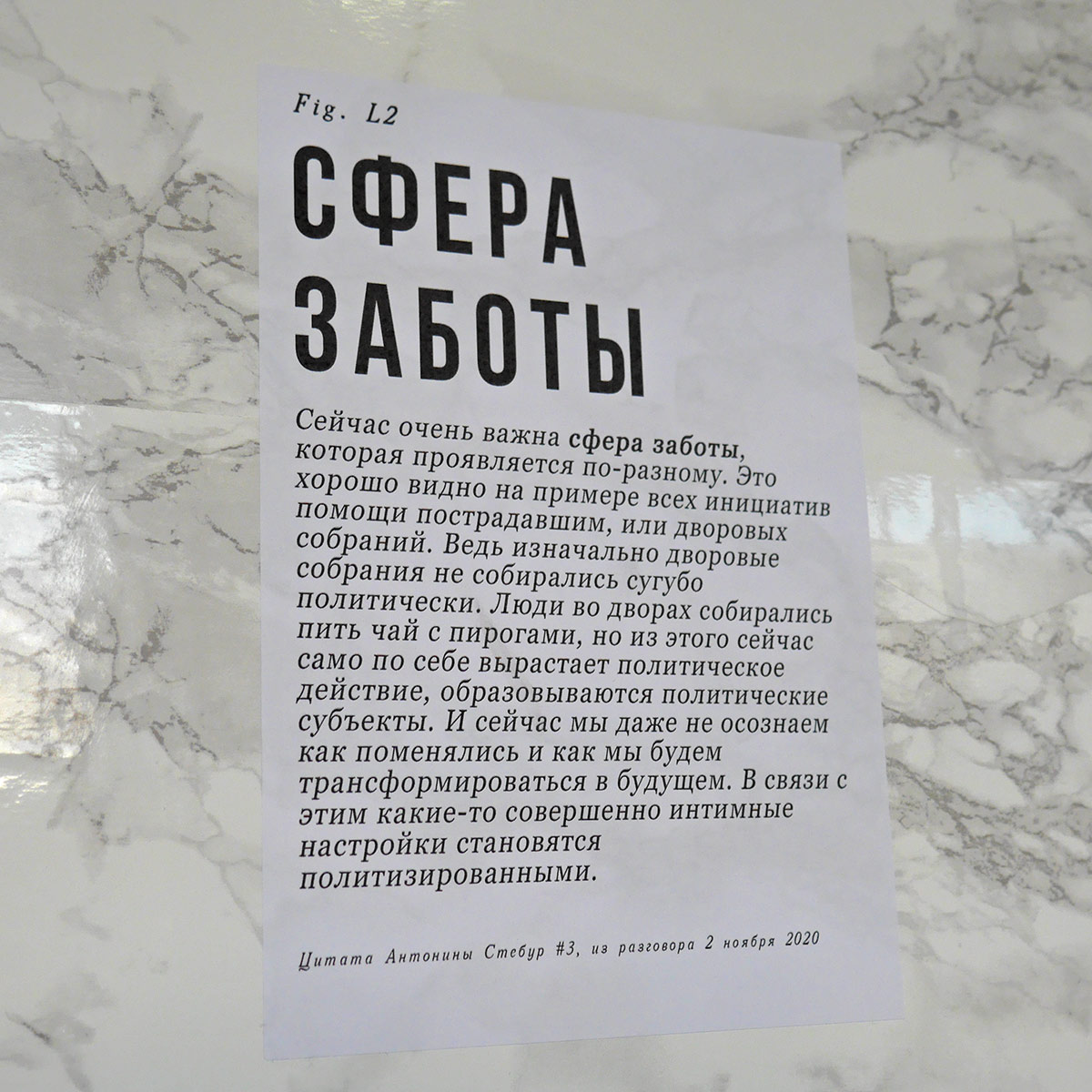
Quote by Antonina Stebur #3
Nowadays, the sphere of care is especially important, and it manifests itself in different ways. This is clearly illustrated by the example of all victim assistance initiatives, or yard meetings. After all, initially, yard meetings were not purely political. People gathered in the yards for a cup of tea and pies, but now political action is being developed out of this, political subjects are formed. We do not even realize now how we have changed and how we will transform in the future. In this regard, some completely intimate structures become politicized.
From the conversation on the 2nd of November 2020
Sphere of Care
Nowadays, the sphere of care is especially important, and it manifests itself in different ways. This is clearly illustrated by the example of all victim assistance initiatives, or yard meetings. After all, initially, yard meetings were not purely political. People gathered in the yards for a cup of tea and pies, but now political action is being developed out of this, political subjects are formed. We do not even realize now how we have changed and how we will transform in the future. In this regard, some completely intimate structures become politicized.
From the conversation on the 2nd of November 2020
Цитата Антонины Стебур #3
Сейчас очень важна сфера заботы, которая проявляется по-разному. Это хорошо видно на примере всех инициатив помощи пострадавшим, или дворовых собраний. Ведь изначально дворовые собрания не собирались сугубо политически. Люди во дворах собирались пить чай с пирогами, но из этого сейчас само по себе вырастает политическое действие, образовываются политические субъекты. И сейчас мы даже не осознаем как поменялись и как мы будем трансформироваться в будущем. В связи с этим какие-то совершенно интимные настройки становятся политизированными.
Из разговора 2 ноября 2020
Сфера заботы
Сейчас очень важна сфера заботы, которая проявляется по-разному. Это хорошо видно на примере всех инициатив помощи пострадавшим, или дворовых собраний. Ведь изначально дворовые собрания не собирались сугубо политически. Люди во дворах собирались пить чай с пирогами, но из этого сейчас само по себе вырастает политическое действие, образовываются политические субъекты. И сейчас мы даже не осознаем как поменялись и как мы будем трансформироваться в будущем. В связи с этим какие-то совершенно интимные настройки становятся политизированными.
Из разговора 2 ноября 2020
Fig. M2

Quote by Antonina Stebur #4
Belarus, in comparison with other European countries, has the largest number of power structures per capita. It would seem that this is a stalemate: there is no one who is able to help, there are no leaders, there is no way to oppose a proportionate force to these power structures. But it is this difficult situation that contributes to the unique character of the Belarusian protests: the participation of a large number of people, self-organization, solidarity, care. At the same time, it is important to understand that this structure, which is being developed now, will work on a long-term basis. And the absence of leaders here becomes a pro, not a con. We do not yet comprehend ourselves as political subjects, which is why we can choose the next form of government, which we got used to. And that scares me. After all, we do not understand how much we have changed already, we reflect little on how to use this protest potential and its structure to realize the future. For example, we have a very strong technical base for the implementation of new utopian forms of government, as horizontal as possible. We need to realize now that we do not need a president at all, we do not need a privileged government, that power itself can be understood outside the categories of exclusivity. We need more horizontal government systems, fairer and distributed, similar to the forms of network administration.
From the conversation on the 2nd of November 2020
Implementation of New Utopian Forms of Government
Belarus, in comparison with other European countries, has the largest number of power structures per capita. It would seem that this is a stalemate: there is no one who is able to help, there are no leaders, there is no way to oppose a proportionate force to these power structures. But it is this difficult situation that contributes to the unique character of the Belarusian protests: the participation of a large number of people, self-organization, solidarity, care. At the same time, it is important to understand that this structure, which is being developed now, will work on a long-term basis. And the absence of leaders here becomes a pro, not a con. We do not yet comprehend ourselves as political subjects, which is why we can choose the next form of government, which we got used to. And that scares me. After all, we do not understand how much we have changed already, we reflect little on how to use this protest potential and its structure to realize the future. For example, we have a very strong technical base for the implementation of new utopian forms of government, as horizontal as possible. We need to realize now that we do not need a president at all, we do not need a privileged government, that power itself can be understood outside the categories of exclusivity. We need more horizontal government systems, fairer and distributed, similar to the forms of network administration.
From the conversation on the 2nd of November 2020
Цитата Антонины Стебур #4
Реализация новых утопических форм правления
В Беларуси, по сравнению с другими европейскими странами, самое большое количество силовых структур на душу населения. Казалось бы, это – патовая ситуация: нет тех, кто способен помочь, нет лидеров, нет возможности противопоставить соразмерную силу этим силовым сруктурам. Но эта сложнаяситуация как раз и порождает уникальный характер белорусских протестов: участие большого количества людей, самоорганизация, солидарность, забота. При этом важно понимание того, что эта вырабатываемая сейчас структура будет работать на долгосрочной основе. И отсутствие лидеров здесь становится плюсом, а не недостатком. Мы пока не успеваем осмысливать себя как политических субъектов, из-за чего мы можем выбрать следующую форму правления “по накатанной”. И это меня пугает. Ведь мы не понимаем, как сильно мы уже поменялись, мы мало рефлексируем над тем, как возпользоваться этим протестным потенциалом и его структурой для реализации будущего. Например, у нас очень сильная техническая база для реализации новых утопических форм правления, максимально горизонтальных. Нам надо сейчас осознать, что президент нам вообще не нужен, нам не нужно привилегированное правительство , что сама власть может быть понята вне категориях эксклюзивности. Нам необходимы более горизонтальные системы управления, более страведливые, распределнные, по аналогии с формой одминистрирования сетей.
Из разговора 2 ноября 2020
Реализация новых утопических форм правления
В Беларуси, по сравнению с другими европейскими странами, самое большое количество силовых структур на душу населения. Казалось бы, это – патовая ситуация: нет тех, кто способен помочь, нет лидеров, нет возможности противопоставить соразмерную силу этим силовым сруктурам. Но эта сложнаяситуация как раз и порождает уникальный характер белорусских протестов: участие большого количества людей, самоорганизация, солидарность, забота. При этом важно понимание того, что эта вырабатываемая сейчас структура будет работать на долгосрочной основе. И отсутствие лидеров здесь становится плюсом, а не недостатком. Мы пока не успеваем осмысливать себя как политических субъектов, из-за чего мы можем выбрать следующую форму правления “по накатанной”. И это меня пугает. Ведь мы не понимаем, как сильно мы уже поменялись, мы мало рефлексируем над тем, как возпользоваться этим протестным потенциалом и его структурой для реализации будущего. Например, у нас очень сильная техническая база для реализации новых утопических форм правления, максимально горизонтальных. Нам надо сейчас осознать, что президент нам вообще не нужен, нам не нужно привилегированное правительство , что сама власть может быть понята вне категориях эксклюзивности. Нам необходимы более горизонтальные системы управления, более страведливые, распределнные, по аналогии с формой одминистрирования сетей.
Из разговора 2 ноября 2020
Fig. N2

Quote by Antonina Stebur #5
One of the turning points of the protest was an action, where women with flowers formed a chain at Komarovsky market, making a strong solidarity gesture. It became a political symbol and was later repeated and scaled in other cities and in different configurations. What patriarchal hierarchies perceive as weakness is now one of those important strategies for resisting the established hierarchies. The authorities do not understand the logic of the enemy, who is dispersed and not hierarchical, and uses weakness as a tactic.
From the conversation on the 2nd of November 2020
Weakness as Resistance Strategy
One of the turning points of the protest was an action, where women with flowers formed a chain at Komarovsky market, making a strong solidarity gesture. It became a political symbol and was later repeated and scaled in other cities and in different configurations. What patriarchal hierarchies perceive as weakness is now one of those important strategies for resisting the established hierarchies. The authorities do not understand the logic of the enemy, who is dispersed and not hierarchical, and uses weakness as a tactic.
From the conversation on the 2nd of November 2020
Цитата Антонины Стебур #5
Одним из переломов протеста была акция, в которой женщины стали в цепь у Комаровского рынка с цветами, совершив сильный жест солидарности. Он стал политическим символом и был потом повторен и масштабирован в разных городах и разных конфигурациях. То, что патриархальные иерархии воспринимают как слабость — сейчас является одной из тех важных стратегий сопротивления сложившимся иерархиям. Властям не понятна логика противника, который рассредоточен и не является иерархическим, а также использует слабость как тактику.
Из разговора 2 ноября 2020
Слабость как стратегия сопротивления
Одним из переломов протеста была акция, в которой женщины стали в цепь у Комаровского рынка с цветами, совершив сильный жест солидарности. Он стал политическим символом и был потом повторен и масштабирован в разных городах и разных конфигурациях. То, что патриархальные иерархии воспринимают как слабость — сейчас является одной из тех важных стратегий сопротивления сложившимся иерархиям. Властям не понятна логика противника, который рассредоточен и не является иерархическим, а также использует слабость как тактику.
Из разговора 2 ноября 2020
Fig. O2
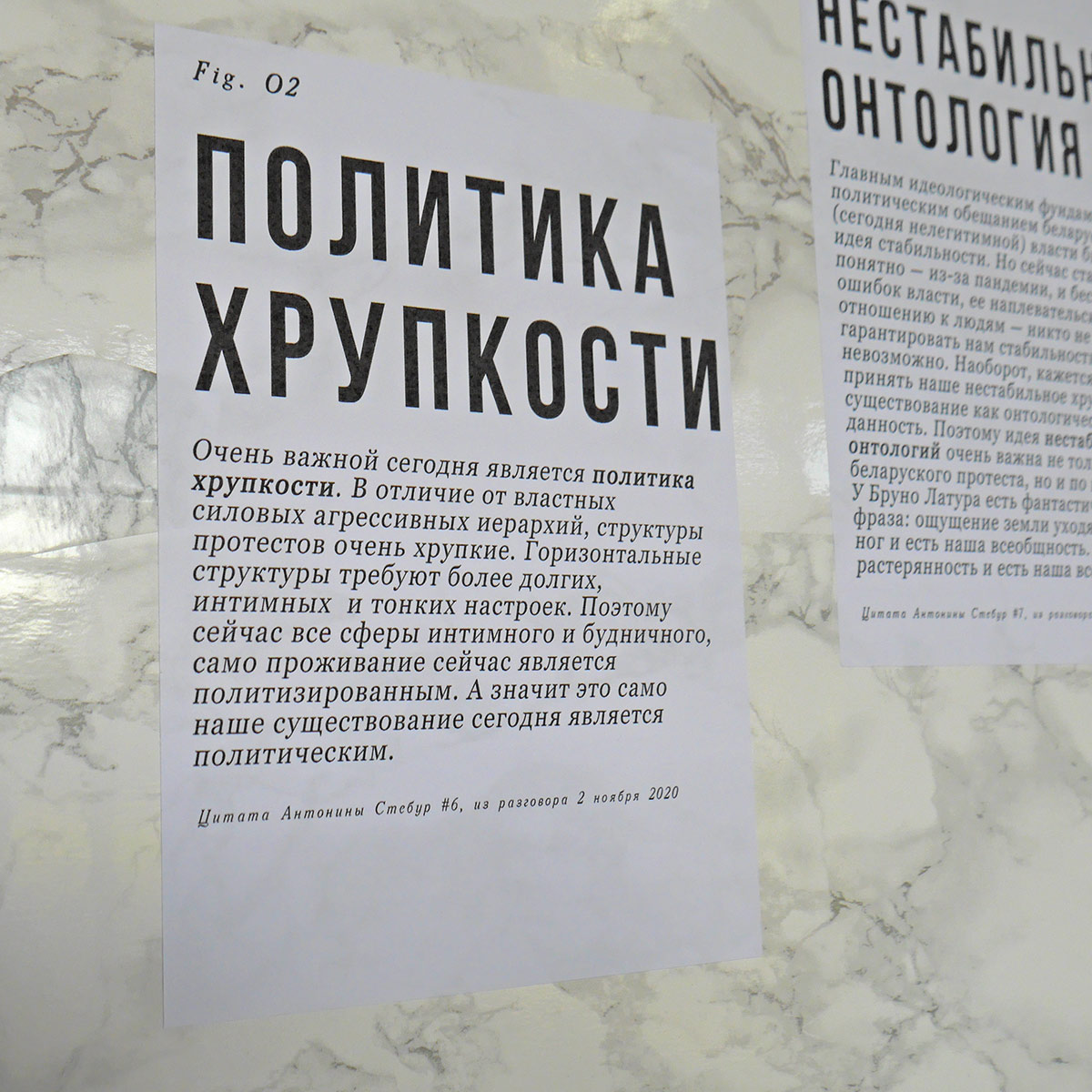
Quote by Antonina Stebur #6
Fragility politics is especially important today. In contrast to aggressive hierarchies of authorities, protest structures are very fragile. Horizontal structures require longer, intimate, and subtle adjustments. Therefore, all spheres of the intimate and everyday life now, and living itself is politicized. This means that our very existence today is political.
From the conversation on the 2nd of November 2020
Fragility Politics
Fragility politics is especially important today. In contrast to aggressive hierarchies of authorities, protest structures are very fragile. Horizontal structures require longer, intimate, and subtle adjustments. Therefore, all spheres of the intimate and everyday life now, and living itself is politicized. This means that our very existence today is political.
From the conversation on the 2nd of November 2020
Цитата Антонины Стебур #6
Очень важной сегодня является политика хрупкости. В отличие от властных силовых агрессивных иерархий, структуры протестов очень хрупкие. Горизонтальные структуры требуют более долгих, интимных и тонких настроек. Поэтому сейчас все сферы интимного и будничного, само проживание сейчас является политизированным. А значит это само наше существование сегодня является политическим.
Из разговора 2 ноября 2020
Политика хрупкости
Очень важной сегодня является политика хрупкости. В отличие от властных силовых агрессивных иерархий, структуры протестов очень хрупкие. Горизонтальные структуры требуют более долгих, интимных и тонких настроек. Поэтому сейчас все сферы интимного и будничного, само проживание сейчас является политизированным. А значит это само наше существование сегодня является политическим.
Из разговора 2 ноября 2020
Fig. P2
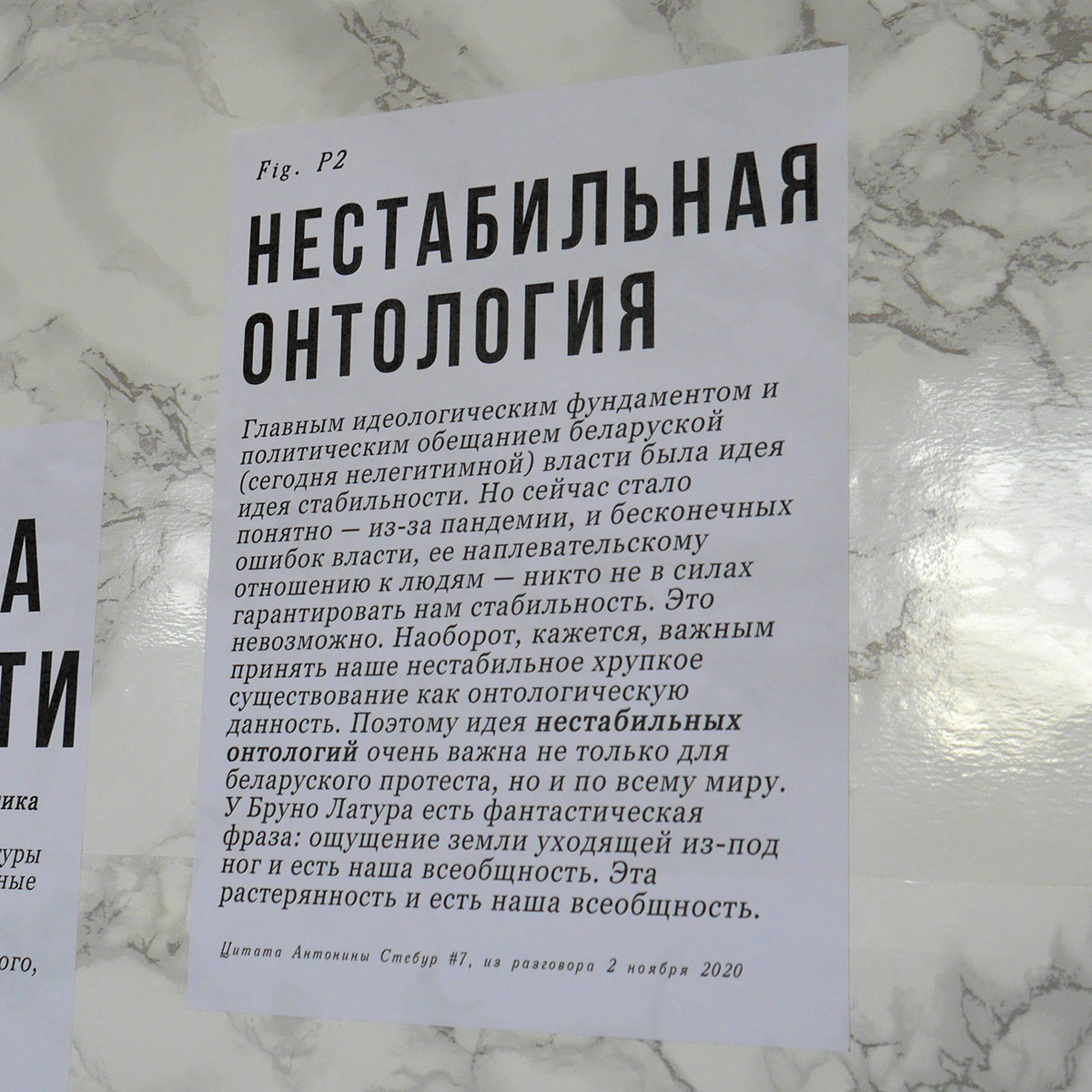
Quote by Antonina Stebur #7
The main ideological foundation and political promise of the Belarusian (today illegitimate) government was the idea of stability. But now it has become clear - due to the pandemic, the endless mistakes of the authorities and their disregard for the people - no one is able to guarantee us stability. It is impossible. On the contrary, it seems important to accept our unstable fragile existence as an ontological given. Therefore, the idea of unstable ontologies is very important not only for the Belarusian protest, but also around the world. Bruno Latour has a fantastic phrase: the feeling of the ground slipping away beneath our feet is our universality. It is this confusion that is our universality.
From the conversation on the 2nd of November 2020
Unstable Ontologies
The main ideological foundation and political promise of the Belarusian (today illegitimate) government was the idea of stability. But now it has become clear - due to the pandemic, the endless mistakes of the authorities and their disregard for the people - no one is able to guarantee us stability. It is impossible. On the contrary, it seems important to accept our unstable fragile existence as an ontological given. Therefore, the idea of unstable ontologies is very important not only for the Belarusian protest, but also around the world. Bruno Latour has a fantastic phrase: the feeling of the ground slipping away beneath our feet is our universality. It is this confusion that is our universality.
From the conversation on the 2nd of November 2020
Цитата Антонины Стебур #7
Нестабильная онтология
Главным идеологическим фундаментом и политическим обещанием беларуской (сегодня нелегитимной) власти была идея идея стабильности. Но сейчас стало понятно — из-за пандемии, и бесконечных ошибок власти, ее наплевательскому отношению к людям — никто не в силах гарантировать нам стабильность. Это невозможно. Наоборот, кажется, важным принять наше нестабильное хрупкое существование как онтологическую данность. Поэтому идея нестабильных онтологий очень важна не только для беларуского протеста, но и по всему миру. У Бруно Латура есть фантастическая фраза: ощущение земли уходящей из-под ног и есть наша всеобщность. Эта растерянность и есть наша всеобщность.
Из разговора 2 ноября 2020
Нестабильная онтология
Главным идеологическим фундаментом и политическим обещанием беларуской (сегодня нелегитимной) власти была идея идея стабильности. Но сейчас стало понятно — из-за пандемии, и бесконечных ошибок власти, ее наплевательскому отношению к людям — никто не в силах гарантировать нам стабильность. Это невозможно. Наоборот, кажется, важным принять наше нестабильное хрупкое существование как онтологическую данность. Поэтому идея нестабильных онтологий очень важна не только для беларуского протеста, но и по всему миру. У Бруно Латура есть фантастическая фраза: ощущение земли уходящей из-под ног и есть наша всеобщность. Эта растерянность и есть наша всеобщность.
Из разговора 2 ноября 2020
Fig. Q2
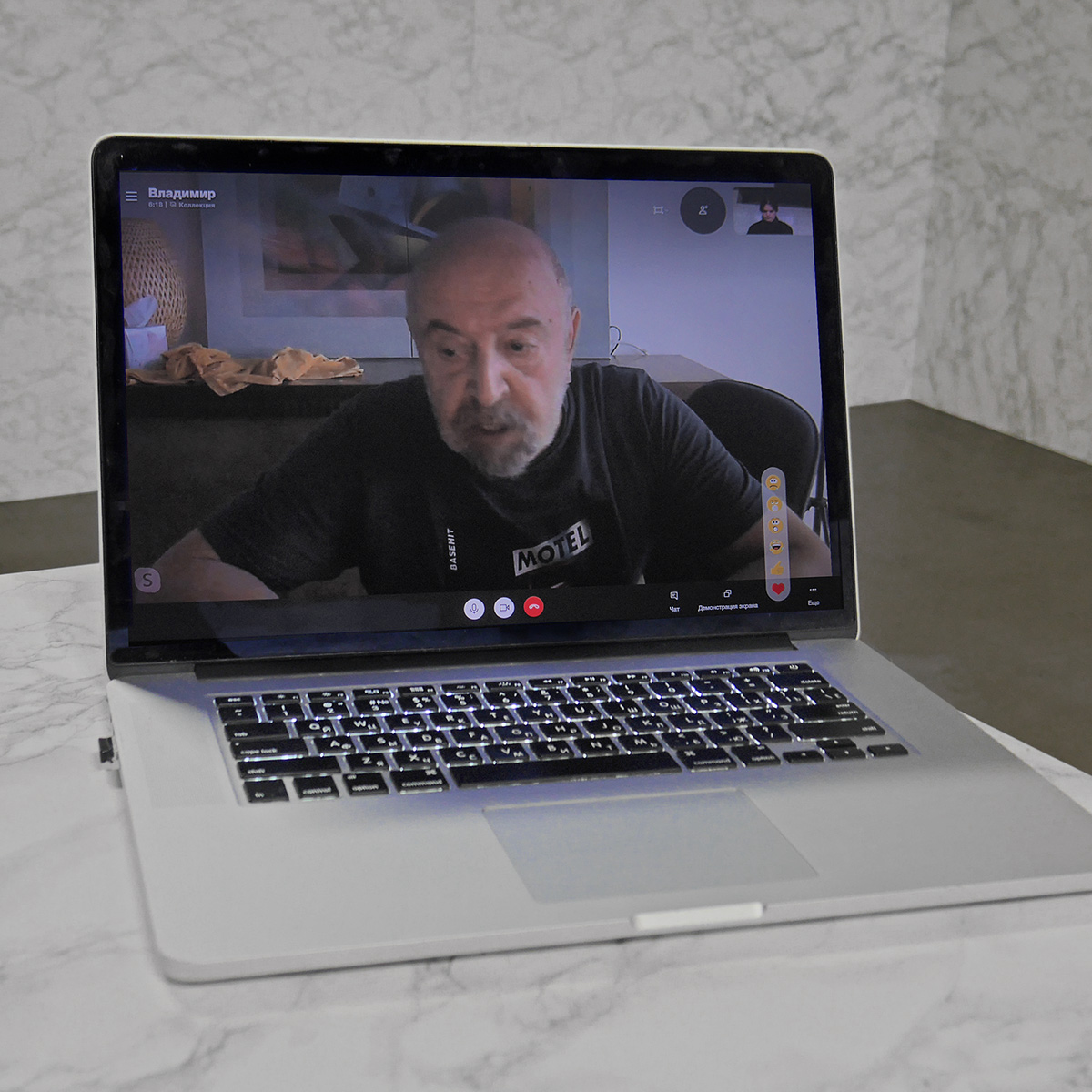
Contributor # 5
Vladimir Tsesler is an artist and designer. Since 1978, he has worked together with Sergei Voichenko in a duet. The tandem gained international fame primarily in the poster field (more than 30 awards at international competitions and biennials).
Today Vladimir Tsesler is considered as the leading designer in Belarus. He creates statements in various media: from poster to painting and industrial design. The acuteness of the postmodern irony correlated with context, culture and time is his signature technique. During the revolution, he regularly exhibits protest posters online.
Lives and works in Minsk.
Vladimir Tsesler
Vladimir Tsesler is an artist and designer. Since 1978, he has worked together with Sergei Voichenko in a duet. The tandem gained international fame primarily in the poster field (more than 30 awards at international competitions and biennials).
Today Vladimir Tsesler is considered as the leading designer in Belarus. He creates statements in various media: from poster to painting and industrial design. The acuteness of the postmodern irony correlated with context, culture and time is his signature technique. During the revolution, he regularly exhibits protest posters online.
Lives and works in Minsk.
Контрибьютор #5
Владимир Цеслер
Владимир Цеслер – художник, дизайнер. С 1978 года работал совместно в дуэте с Сергеем Войченко. Международную известность тандем приобрел прежде всего в области плаката (более 30 наград международных конкурсов и биеннале).
Сегодня Владимира Цеслера считают ведущим дизайнером в Беларуси. Создает высказываения в различных медиа: от плаката до живописи и промышленного дизайна. Острота постмодернистской иронии, соотнесённая с контекстом, культурой и временем, является его фирменным приемом. Во время революции регулярно выставляет в сети протестные плакаты.
Живет и работает в Минске.
Владимир Цеслер
Владимир Цеслер – художник, дизайнер. С 1978 года работал совместно в дуэте с Сергеем Войченко. Международную известность тандем приобрел прежде всего в области плаката (более 30 наград международных конкурсов и биеннале).
Сегодня Владимира Цеслера считают ведущим дизайнером в Беларуси. Создает высказываения в различных медиа: от плаката до живописи и промышленного дизайна. Острота постмодернистской иронии, соотнесённая с контекстом, культурой и временем, является его фирменным приемом. Во время революции регулярно выставляет в сети протестные плакаты.
Живет и работает в Минске.
Fig. R2
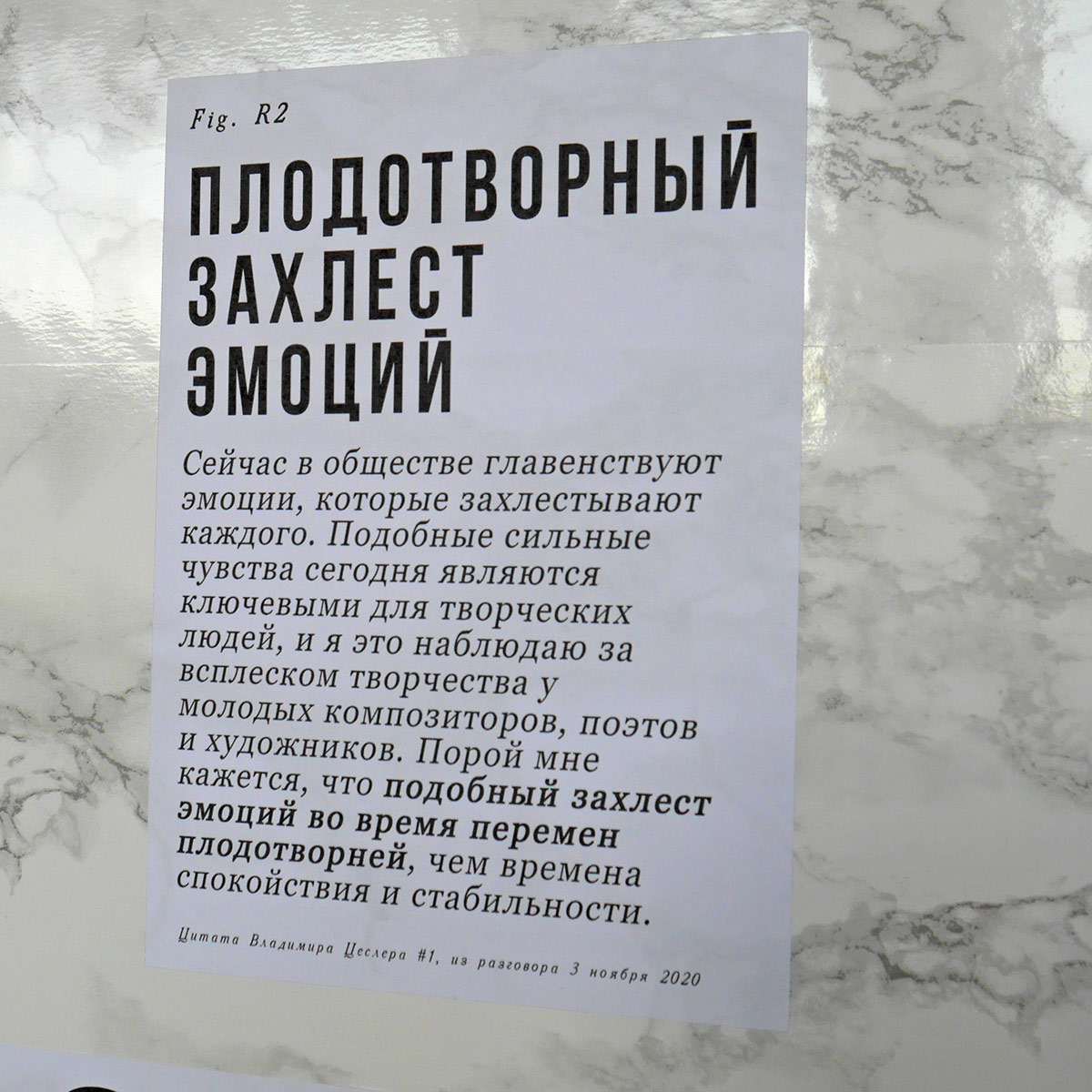
Quote by Vladimir Tsesler #1
The society is dominated by emotions overwhelming everyone now. Such strong feelings are the key for creative people today, and I see this surge of creativity among young composers, poets and artists. Sometimes it seems that such an overflow of emotions in times of change is more fruitful than during the times of calm and stability.
From the conversation on November 3, 2020
Fruitful Overflow of Emotions
The society is dominated by emotions overwhelming everyone now. Such strong feelings are the key for creative people today, and I see this surge of creativity among young composers, poets and artists. Sometimes it seems that such an overflow of emotions in times of change is more fruitful than during the times of calm and stability.
From the conversation on November 3, 2020
Цитата Владимира Цеслера #1
Сейчас в обществе главенствуют эмоции, которые захлестывают каждого. Подобные сильные чувства сегодня являются ключевыми для творческих людей, и я это наблюдаю за всплеском творчества у молодых композиторов, поэтов и художников. Порой мне кажется, что подобный захлест эмоций во время перемен плодотворней, чем времена спокойствия и стабильности.
Из разговора 3 ноября 2020
Плодотворный захлест эмоций
Сейчас в обществе главенствуют эмоции, которые захлестывают каждого. Подобные сильные чувства сегодня являются ключевыми для творческих людей, и я это наблюдаю за всплеском творчества у молодых композиторов, поэтов и художников. Порой мне кажется, что подобный захлест эмоций во время перемен плодотворней, чем времена спокойствия и стабильности.
Из разговора 3 ноября 2020
Fig. S2
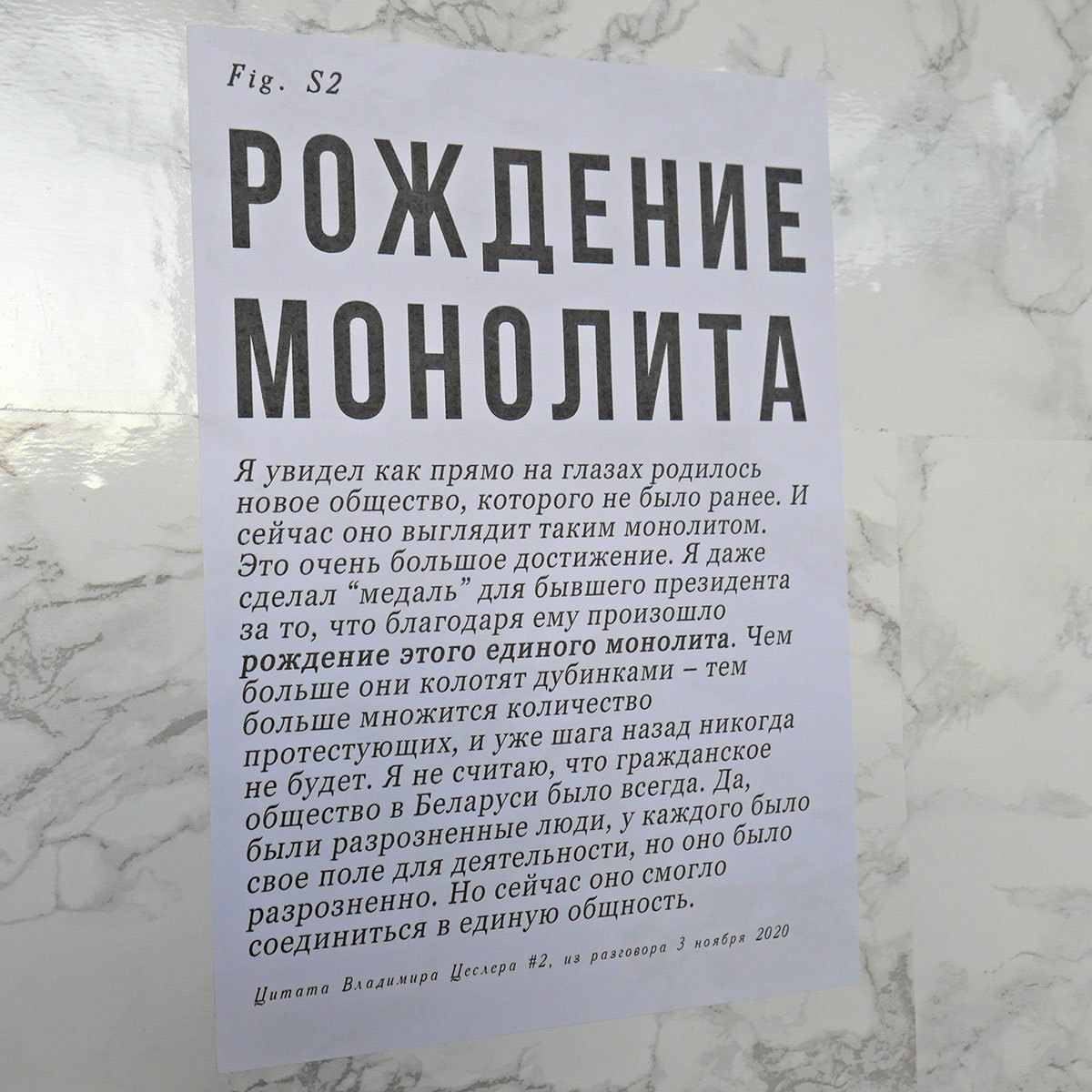
Quote by Vladimir Tsesler #2
I saw how a new society, which has not existed before, was born right in front of us. And now it looks like such a monolith. This is a great achievement. I even made a “medal” for the former president for making it happen. The more they beat people with batons, the more the number of protesters increases, and there will be no going back. I don't think there has always been a civil society in Belarus. Yes, there were scattered people, each had their own field of activity, but it was scattered. But now the society has united into a single community.
From the conversation on November 3, 2020
Birth of Monolith
I saw how a new society, which has not existed before, was born right in front of us. And now it looks like such a monolith. This is a great achievement. I even made a “medal” for the former president for making it happen. The more they beat people with batons, the more the number of protesters increases, and there will be no going back. I don't think there has always been a civil society in Belarus. Yes, there were scattered people, each had their own field of activity, but it was scattered. But now the society has united into a single community.
From the conversation on November 3, 2020
Цитата Владимира Цеслера #2
Я увидел как прямо на глазах родилось новое общество, которого не было ранее. И сейчас оно выглядит таким монолитом. Это очень большое достижение. Я даже сделал “медаль” для бывшего президента за то, что благодаря ему произошло рождение этого единого монолита. Чем больше они колотят дубинками – тем больше множится количество протестующих, и уже шага назад никогда не будет. Я не считаю, что гражданское общество в Беларуси было всегда. Да, были разрозненные люди, у каждого было свое поле для деятельности, но оно было разрозненно. Но сейчас оно смогло соединиться в единую общность.
Из разговора 3 ноября 2020
Рождение монолита
Я увидел как прямо на глазах родилось новое общество, которого не было ранее. И сейчас оно выглядит таким монолитом. Это очень большое достижение. Я даже сделал “медаль” для бывшего президента за то, что благодаря ему произошло рождение этого единого монолита. Чем больше они колотят дубинками – тем больше множится количество протестующих, и уже шага назад никогда не будет. Я не считаю, что гражданское общество в Беларуси было всегда. Да, были разрозненные люди, у каждого было свое поле для деятельности, но оно было разрозненно. Но сейчас оно смогло соединиться в единую общность.
Из разговора 3 ноября 2020
Fig. T2
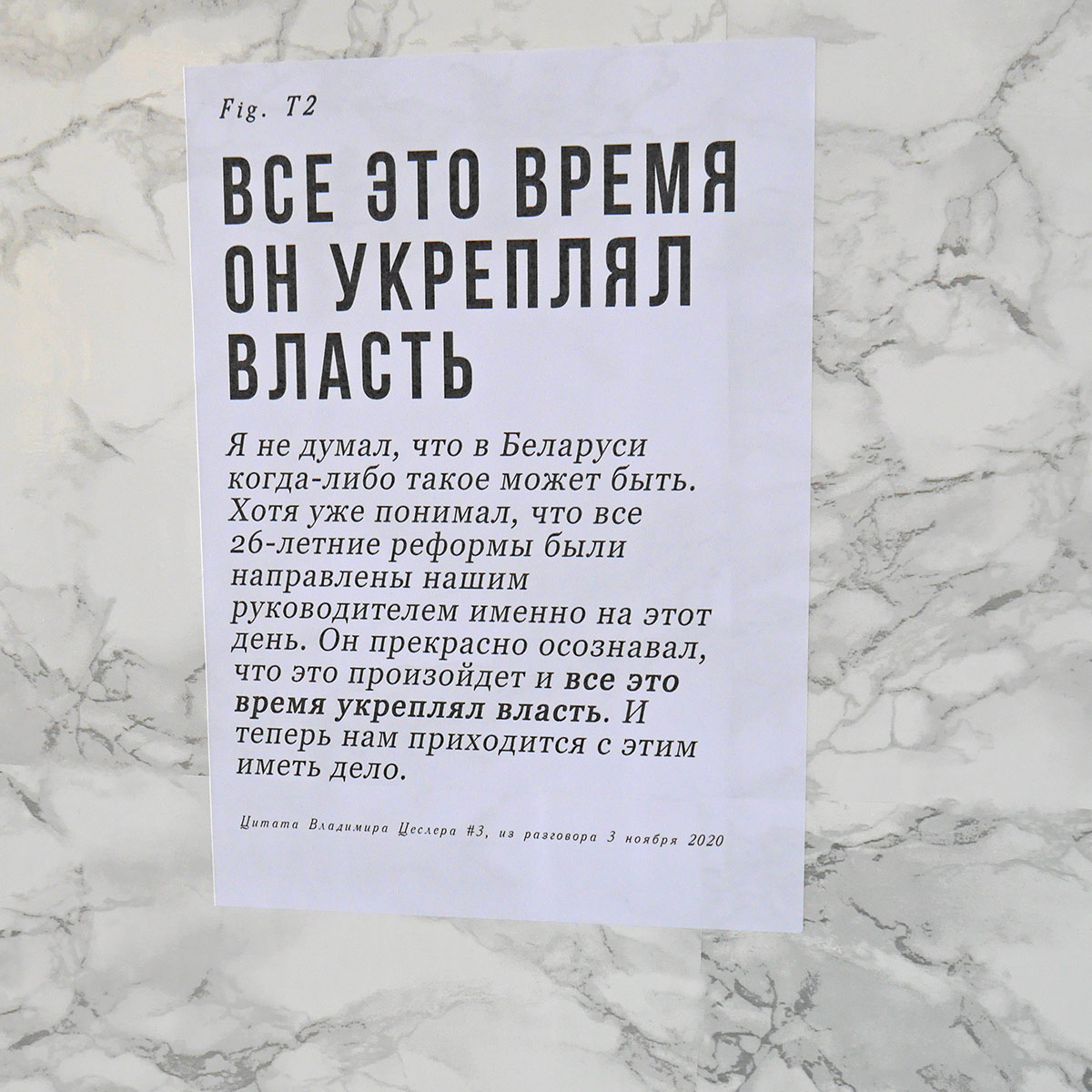
Quote by Vladimir Tsesler #3
I didn't think that such a thing could ever happen in Belarus. However, I already understood that all the reforms during those 26 years were directed by our leader on that very day. He was well aware that this would happen and all this time he has been consolidating his power. And now we have to deal with it.
From the conversation on November 3, 2020
He Has Been Consolidating His Power All this Time
I didn't think that such a thing could ever happen in Belarus. However, I already understood that all the reforms during those 26 years were directed by our leader on that very day. He was well aware that this would happen and all this time he has been consolidating his power. And now we have to deal with it.
From the conversation on November 3, 2020
Цитата Владимира Цеслера #3
Все это время он укреплял власть
Я не думал, что в Беларуси когда-либо такое может быть. Хотя уже понимал, что все 26-летние реформы были направлены нашим руководителем именно на этот день. Он прекрасно осознавал, что это произойдет и все это время укреплял власть. И теперь нам приходится с этим иметь дело.
Из разговора 3 ноября 2020
Все это время он укреплял власть
Я не думал, что в Беларуси когда-либо такое может быть. Хотя уже понимал, что все 26-летние реформы были направлены нашим руководителем именно на этот день. Он прекрасно осознавал, что это произойдет и все это время укреплял власть. И теперь нам приходится с этим иметь дело.
Из разговора 3 ноября 2020
Fig. U2
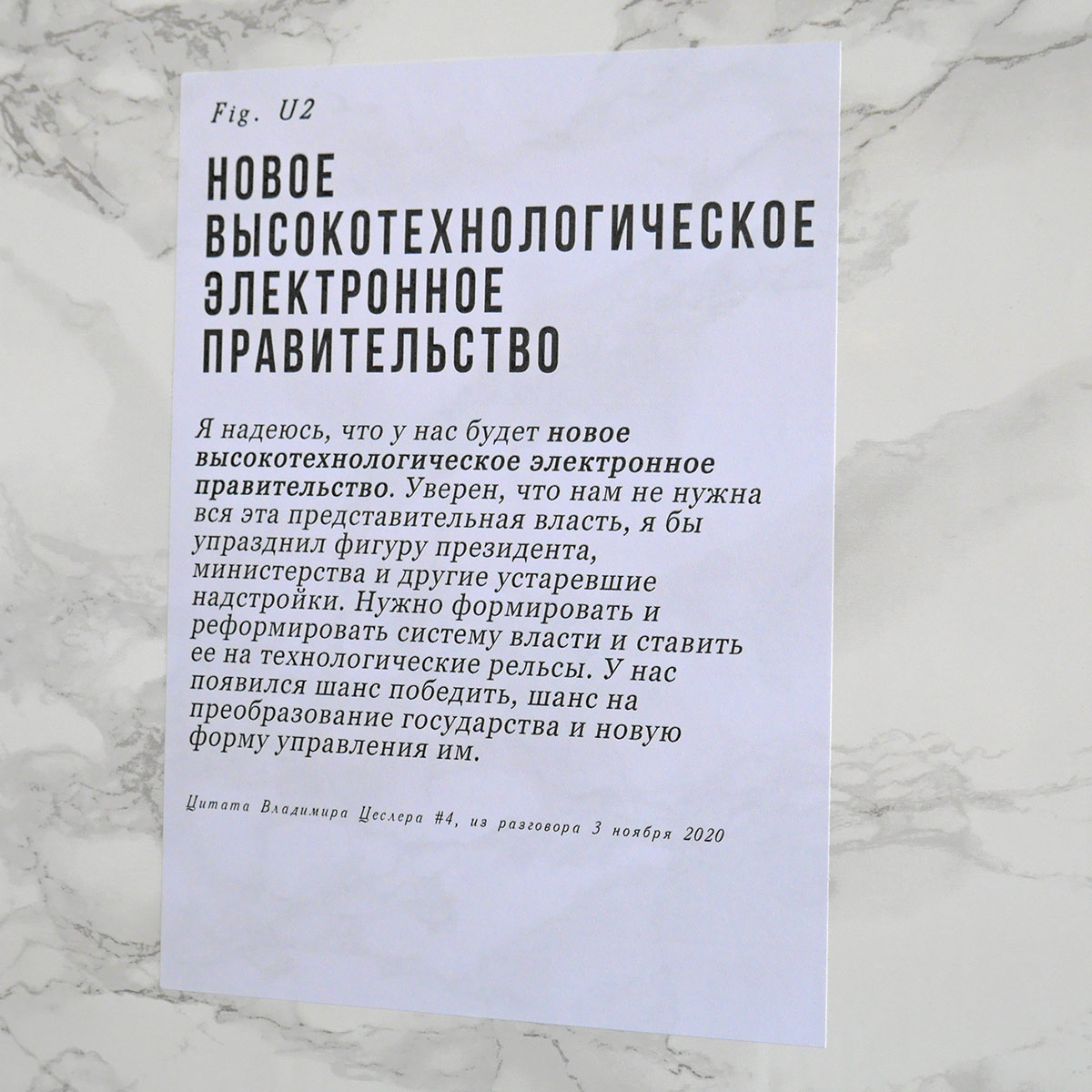
Quote by Vladimir Tsesler #4
I hope we will have a new high-tech e-government. I am sure that we do not need all this representative power, I would abolish the figure of the president, ministries, and other outdated superstructures. It is necessary to form and reform the system and put it on a technological track. We have a chance to win, a chance to transform the state and to form a new government.
From the conversation on November 3, 2020
New High-Tech E-Government
I hope we will have a new high-tech e-government. I am sure that we do not need all this representative power, I would abolish the figure of the president, ministries, and other outdated superstructures. It is necessary to form and reform the system and put it on a technological track. We have a chance to win, a chance to transform the state and to form a new government.
From the conversation on November 3, 2020
Цитата Владимира Цеслера #4
Новое высокотехнологическое электронное правительство
Я надеюсь, что у нас будет новое высокотехнологическое электронное правительство. Уверен, что нам не нужна вся эта представительная власть, я бы упразднил фигуру президента, министерства и другие устаревшие надстройки. Нужно формировать и реформировать систему власти и ставить ее на технологические рельсы. У нас появился шанс победить, шанс на преобразование государства и новую форму управления им.
Из разговора 3 ноября 2020
Новое высокотехнологическое электронное правительство
Я надеюсь, что у нас будет новое высокотехнологическое электронное правительство. Уверен, что нам не нужна вся эта представительная власть, я бы упразднил фигуру президента, министерства и другие устаревшие надстройки. Нужно формировать и реформировать систему власти и ставить ее на технологические рельсы. У нас появился шанс победить, шанс на преобразование государства и новую форму управления им.
Из разговора 3 ноября 2020
Fig. V2
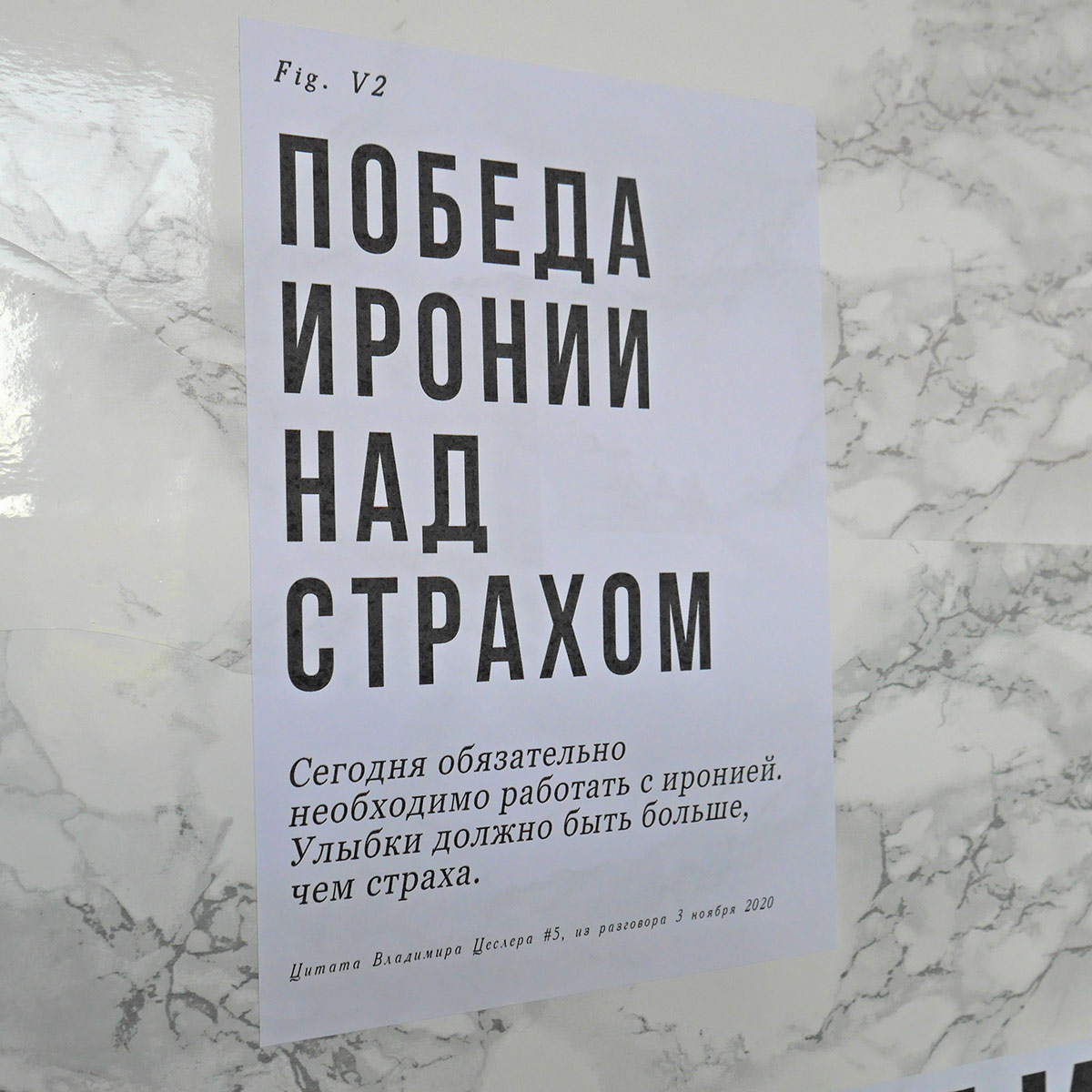
Quote by Vladimir Tsesler #5
Today we need to work with irony no matter what. There should be more smiles than fear.
From the conversation on November 3, 2020
Victory of Irony over Fear
Today we need to work with irony no matter what. There should be more smiles than fear.
From the conversation on November 3, 2020
Цитата Владимира Цеслера #5
Сегодня обязательно необходимо работать с иронией. Улыбки должно быть больше, чем страха.
Из разговора 3 ноября 2020
Победа иронии над страхом
Сегодня обязательно необходимо работать с иронией. Улыбки должно быть больше, чем страха.
Из разговора 3 ноября 2020
Fig. W2

Keyword #2
IT Country / Nexta / Telegram Channels / Internet Blockades / High-Tech State / Courtyard Chats / Scientific and Technological Progress / "Voice" Platform / Revolution via Social Networks / Technocracy / Digital Democracy / Ecology / E-Government
See:
Fig. O1: Digital Democracy
Fig. U4: Blockchain Protest
Fig. W4: IT Country
Fig. F5: Environmental Agenda
Fig. G5: Launching nuclear power plants is currently strictly prohibited
Fig. N5: Belarusians are capable of building a technocracy
Fig. Z6: Internet and communication blockade
Fig. E7: Coordination Council
Fig. N7: Protest Internet and Media
Fig. D8: Different Vocabulary
Technologies
IT Country / Nexta / Telegram Channels / Internet Blockades / High-Tech State / Courtyard Chats / Scientific and Technological Progress / "Voice" Platform / Revolution via Social Networks / Technocracy / Digital Democracy / Ecology / E-Government
See:
Fig. O1: Digital Democracy
Fig. U4: Blockchain Protest
Fig. W4: IT Country
Fig. F5: Environmental Agenda
Fig. G5: Launching nuclear power plants is currently strictly prohibited
Fig. N5: Belarusians are capable of building a technocracy
Fig. Z6: Internet and communication blockade
Fig. E7: Coordination Council
Fig. N7: Protest Internet and Media
Fig. D8: Different Vocabulary
Ключевое слово #2
IT-страна / Nexta / Telegram-каналы / Блокировки интернета / Высокотехнологическое государство / Дворовые чаты / Научно-технический прогресс / Платформа “Голос” / Революция через социальные сети / Технократия / Цифровая демократия / Экология / Электронное правительство
Смотри:
Fig. O1: Цифровая демократия
Fig. U4: Блокчейн протест
Fig. W4: IT-страна
Fig. F5: Экологическая повестка
Fig. G5: Сейчас запускать АЭС категорически запрещено
Fig. N5: Беларусы в состоянии построить технократию
Fig. Z6: Блокировка интернета и связи
Fig. E7: Координационный совет
Fig. N7: Протестный интернет и СМИ
Fig. D8: Иная лексика
Технологии
IT-страна / Nexta / Telegram-каналы / Блокировки интернета / Высокотехнологическое государство / Дворовые чаты / Научно-технический прогресс / Платформа “Голос” / Революция через социальные сети / Технократия / Цифровая демократия / Экология / Электронное правительство
Смотри:
Fig. O1: Цифровая демократия
Fig. U4: Блокчейн протест
Fig. W4: IT-страна
Fig. F5: Экологическая повестка
Fig. G5: Сейчас запускать АЭС категорически запрещено
Fig. N5: Беларусы в состоянии построить технократию
Fig. Z6: Блокировка интернета и связи
Fig. E7: Координационный совет
Fig. N7: Протестный интернет и СМИ
Fig. D8: Иная лексика
Fig. X2

Keyword #3
Boycott / Civil Disobedience / Demoralization of the Opponent / Strike / Marches / Nonviolent Resistance / Noncooperation / Psychology of Peace / Weakness as a Tool
See:
Fig. D1: This protest cannot be called 100% peaceful
Fig. F1: Bloodless Revolution
Fig. W1: Two sides of the peaceful protest coin
Fig. O2: Politics of Fragility
Fig. P2: Unstable Ontology
Fig. D5: Uplifting March
Fig. O5: Look Out the Window, Not at the TV!
Fig. R6: Nina Baginskaya: I'm Walking!
Fig. F7: First solidarity action due to the arrest of Viktor Babariko
Fig. L7: Strikes and ultimatums
Fig. P7: Strengthening Communities
Fig. X7: Real Politics
Fig. U8: Strikes at enterprises in Belarus. The main thing
Peaceful Protest
Boycott / Civil Disobedience / Demoralization of the Opponent / Strike / Marches / Nonviolent Resistance / Noncooperation / Psychology of Peace / Weakness as a Tool
See:
Fig. D1: This protest cannot be called 100% peaceful
Fig. F1: Bloodless Revolution
Fig. W1: Two sides of the peaceful protest coin
Fig. O2: Politics of Fragility
Fig. P2: Unstable Ontology
Fig. D5: Uplifting March
Fig. O5: Look Out the Window, Not at the TV!
Fig. R6: Nina Baginskaya: I'm Walking!
Fig. F7: First solidarity action due to the arrest of Viktor Babariko
Fig. L7: Strikes and ultimatums
Fig. P7: Strengthening Communities
Fig. X7: Real Politics
Fig. U8: Strikes at enterprises in Belarus. The main thing
Ключевое слово #3
Бойкот / Гражданское неповиновение / Деморализация противника / Забастовка / Марши / Ненасильственное сопротивление / Отказ от сотрудничества / Психология мира / Слабость как инструмент
Смотри:
Fig. D1: На 100% называть этот протест мирным нельзя
Fig. F1: Революция без крови
Fig. W1: Две стороны медали мирного протеста
Fig. O2: Политика хрупкости
Fig. P2: Нестабильная онтология
Fig. D5: Духоподъемный марш
Fig. O5: Смотри в окно, а не в телевизор!
Fig. R6: Нина Багинская: Я гуляю!
Fig. F7: Первая акция солидарности из-за ареста Виктора Бабарико
Fig. L7: Забастовки и ультиматум
Fig. P7: Укрепление сообществ
Fig. X7: Самая настоящая политика
Fig.U8: Забастовки на предприятиях в Беларуси. Главное
Мирный протест
Бойкот / Гражданское неповиновение / Деморализация противника / Забастовка / Марши / Ненасильственное сопротивление / Отказ от сотрудничества / Психология мира / Слабость как инструмент
Смотри:
Fig. D1: На 100% называть этот протест мирным нельзя
Fig. F1: Революция без крови
Fig. W1: Две стороны медали мирного протеста
Fig. O2: Политика хрупкости
Fig. P2: Нестабильная онтология
Fig. D5: Духоподъемный марш
Fig. O5: Смотри в окно, а не в телевизор!
Fig. R6: Нина Багинская: Я гуляю!
Fig. F7: Первая акция солидарности из-за ареста Виктора Бабарико
Fig. L7: Забастовки и ультиматум
Fig. P7: Укрепление сообществ
Fig. X7: Самая настоящая политика
Fig.U8: Забастовки на предприятиях в Беларуси. Главное
Fig. Y2
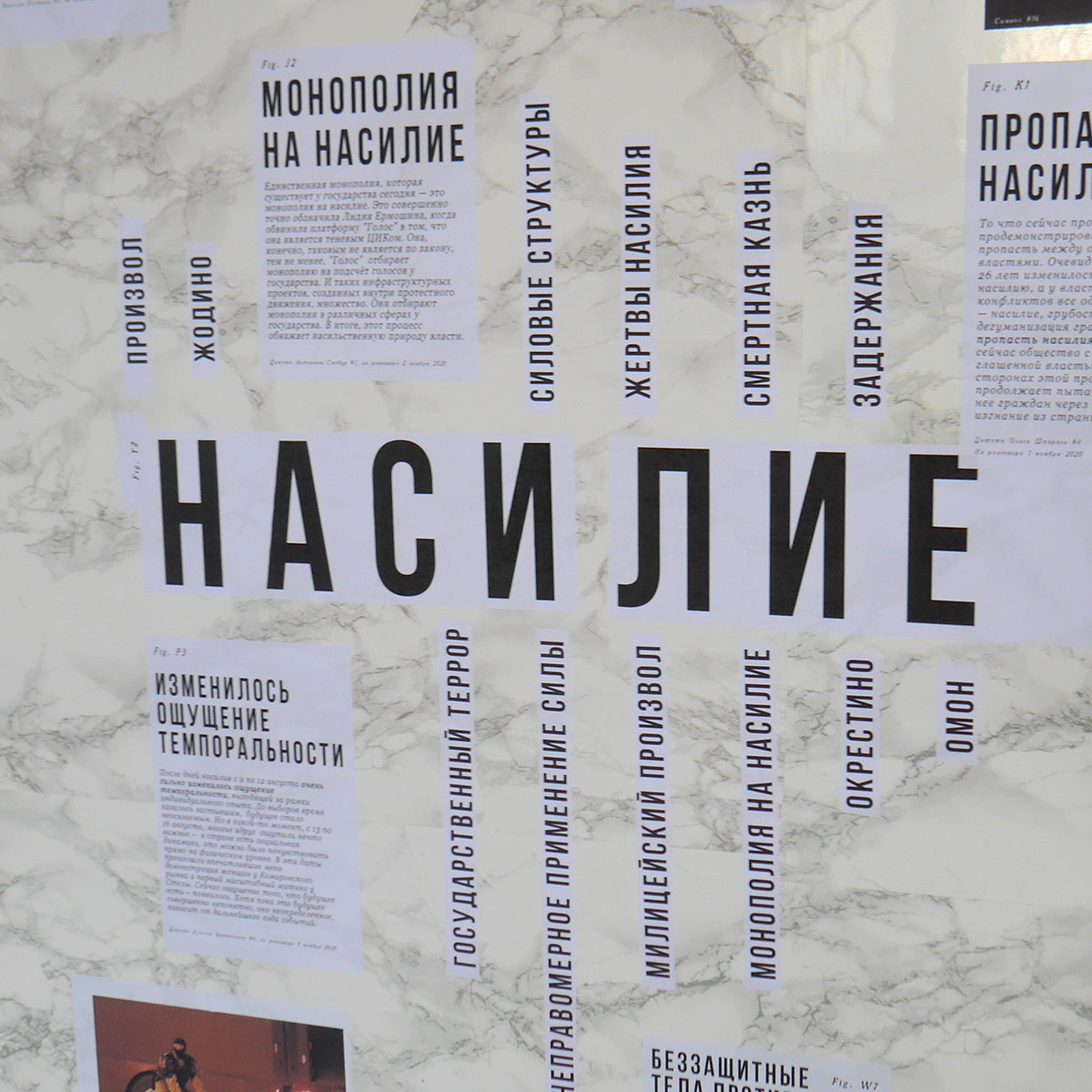
Keyword #4
State Terror / Victims of Violence / Zhodino / Arrests / Police Brutality / Monopoly on Violence / Unlawful Use of Force / Okrestino / OMON (Special Purpose Mobility Unit) / Arbitrary Rule / Power Structures / Death Penalty
See:
Fig. K1: Abyss of Violence
Fig. Y1: People don't forgive such things
Fig. B2: Sacred Victims of Violence
Fig. J2: Monopoly on Violence
Fig. P3: Temporality Sensation Changed
Fig. R3: The Most Important
Fig. S4: Violence as a Decisive Factor
Fig. D6: Murder of Roman Bondarenko
Fig. G7: Escalation of Violence August 9–12
Fig. I7: Victims of Violence
Fig. W7: Defenseless Bodies Against State Violence
Fig. A8: The state system of violence has been forming for decades
Violence
State Terror / Victims of Violence / Zhodino / Arrests / Police Brutality / Monopoly on Violence / Unlawful Use of Force / Okrestino / OMON (Special Purpose Mobility Unit) / Arbitrary Rule / Power Structures / Death Penalty
See:
Fig. K1: Abyss of Violence
Fig. Y1: People don't forgive such things
Fig. B2: Sacred Victims of Violence
Fig. J2: Monopoly on Violence
Fig. P3: Temporality Sensation Changed
Fig. R3: The Most Important
Fig. S4: Violence as a Decisive Factor
Fig. D6: Murder of Roman Bondarenko
Fig. G7: Escalation of Violence August 9–12
Fig. I7: Victims of Violence
Fig. W7: Defenseless Bodies Against State Violence
Fig. A8: The state system of violence has been forming for decades
Ключевое слово #4
Государственный террор / Жертвы насилия / Жодино / Задержания / Милицейский произвол / Монополия на насилие / Неправомерное применение силы / Окрестино / ОМОН / Произвол / Силовые структуры / Смертная казнь
Смотри:
Fig. K1: Пропасть насилия
Fig. Y1: Люди такое не прощают
Fig. B2: Сакральные жертвы насилия
Fig. J2: Монополия на насилие
Fig. P3: Изменилось ощущение темпоральности
Fig. R3: Самое важное
Fig. S4: Насилие как решающий фактор
Fig. D6: Убийство Романа Бондаренко
Fig. G7: Эскалация насилия 9 — 12 августа
Fig. I7: Жертвы насилия
Fig. W7: Беззащитные тела против государственного насилия
Fig. A8: Государственная система насилия складывалась десятилетиями
Насилие
Государственный террор / Жертвы насилия / Жодино / Задержания / Милицейский произвол / Монополия на насилие / Неправомерное применение силы / Окрестино / ОМОН / Произвол / Силовые структуры / Смертная казнь
Смотри:
Fig. K1: Пропасть насилия
Fig. Y1: Люди такое не прощают
Fig. B2: Сакральные жертвы насилия
Fig. J2: Монополия на насилие
Fig. P3: Изменилось ощущение темпоральности
Fig. R3: Самое важное
Fig. S4: Насилие как решающий фактор
Fig. D6: Убийство Романа Бондаренко
Fig. G7: Эскалация насилия 9 — 12 августа
Fig. I7: Жертвы насилия
Fig. W7: Беззащитные тела против государственного насилия
Fig. A8: Государственная система насилия складывалась десятилетиями
Fig. Z2
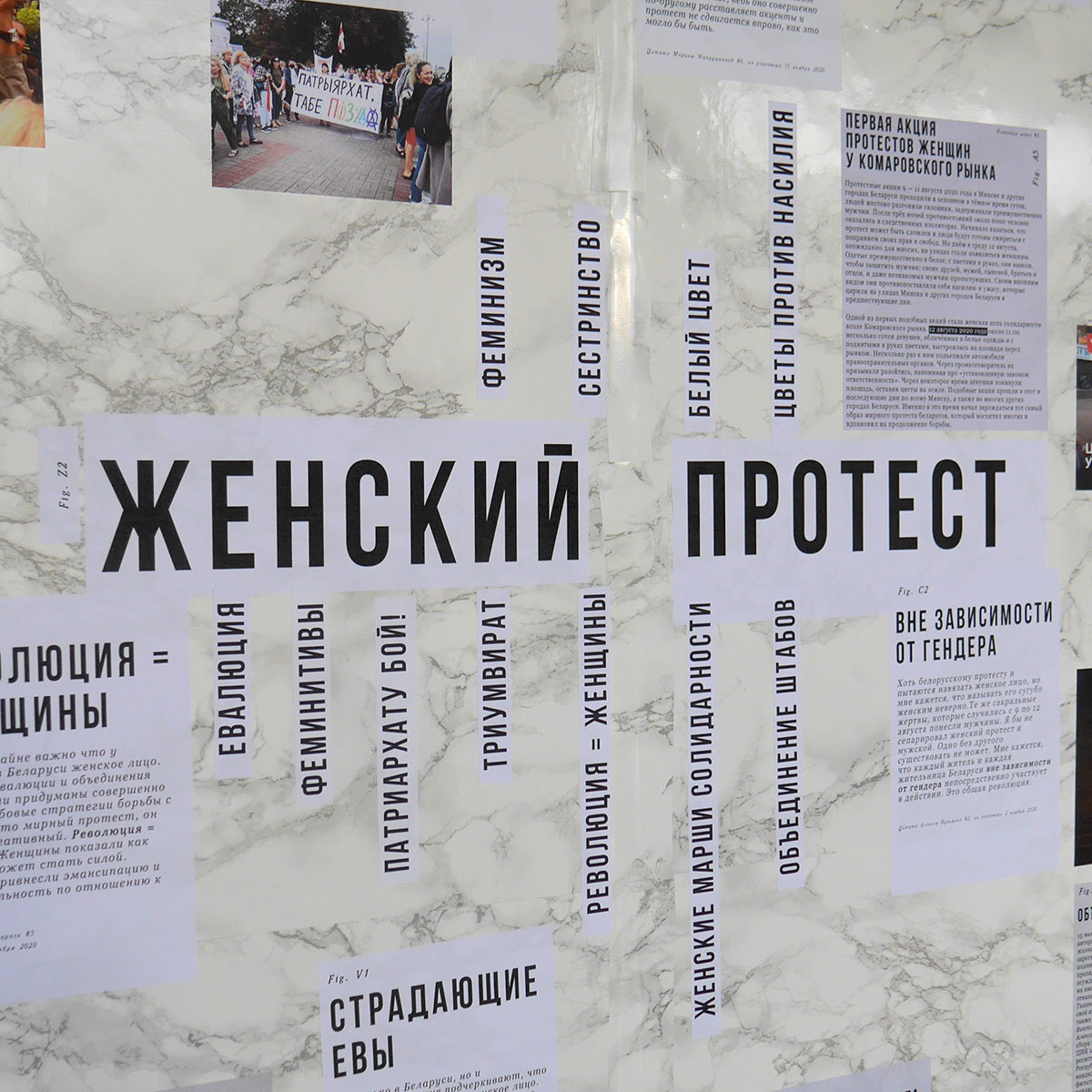
Keyword #5
Women's Protest
White Color / Evalution / Women's Solidarity Marches / Headquarters Integration / Patriarchy Beware! / Revolution = Women / Sisterhood / Triumvirate / Feminine Forms / Feminism / Flowers Against Violence
See:
Fig. L1: Revolution = Women
Fig. N1: Hits Means Arrest!
Fig. V1: Suffering Evas
Fig. C2: Regardless of Gender
Fig. J3: Arrest of "Eva"
Fig. K3: Integration of three headquarters
Fig. M4: #EVAlution
Fig. A5: First women's protest action at Komarovskiy Market
Fig. J6: Ambivalent feeling
Fig. N6: "Patriarchy, f*** you"
Fig. R6: Nina Baginskaya: I'm Walking!
Fig. B7: Women's protest actions
Fig. B8: Women have always been active in Belarus
Fig. J8: Society doesn't understand what patriarchy is
Fig. N8: Hegemonic masculinity
Fig. P8: Feminist Revolution?
Women's Protest
White Color / Evalution / Women's Solidarity Marches / Headquarters Integration / Patriarchy Beware! / Revolution = Women / Sisterhood / Triumvirate / Feminine Forms / Feminism / Flowers Against Violence
See:
Fig. L1: Revolution = Women
Fig. N1: Hits Means Arrest!
Fig. V1: Suffering Evas
Fig. C2: Regardless of Gender
Fig. J3: Arrest of "Eva"
Fig. K3: Integration of three headquarters
Fig. M4: #EVAlution
Fig. A5: First women's protest action at Komarovskiy Market
Fig. J6: Ambivalent feeling
Fig. N6: "Patriarchy, f*** you"
Fig. R6: Nina Baginskaya: I'm Walking!
Fig. B7: Women's protest actions
Fig. B8: Women have always been active in Belarus
Fig. J8: Society doesn't understand what patriarchy is
Fig. N8: Hegemonic masculinity
Fig. P8: Feminist Revolution?
Ключевое слово #5
Белый цвет / Евалюция / Женские марши солидарности / Объединение штабов / Патриархату бой! / Революция = женщины / Сестринство / Триумвират / Феминитивы / Феминизм / Цветы против насилия
Смотри:
Fig. L1: Революция = женщины
Fig. N1: Бьёт значит сядет!
Fig. V1: Страдающие Евы
Fig. C2: Вне зависимости от гендера
Fig. J3: Арест “Евы”
Fig. K3: Объединение трех штабов
Fig. M4: #ЕВАлюция
Fig. A5: Первая акция протестов женщин у Комаровcкого рынка
Fig. J6: Амбивалентное ощущение
Fig. N6: “Патриархат, тебе п****”
Fig. R6: Нина Багинская: Я гуляю!
Fig. B7: Женские акции протеста
Fig. B8: Женщины всегда были активными в Беларуси
Fig. J8: Грамадства не разумее, што такое патрыярхат
Fig. N8: Гегемонная маскуліннасць
Fig. P8: Феміністкая рэвалюцыя?
Женский протест
Белый цвет / Евалюция / Женские марши солидарности / Объединение штабов / Патриархату бой! / Революция = женщины / Сестринство / Триумвират / Феминитивы / Феминизм / Цветы против насилия
Смотри:
Fig. L1: Революция = женщины
Fig. N1: Бьёт значит сядет!
Fig. V1: Страдающие Евы
Fig. C2: Вне зависимости от гендера
Fig. J3: Арест “Евы”
Fig. K3: Объединение трех штабов
Fig. M4: #ЕВАлюция
Fig. A5: Первая акция протестов женщин у Комаровcкого рынка
Fig. J6: Амбивалентное ощущение
Fig. N6: “Патриархат, тебе п****”
Fig. R6: Нина Багинская: Я гуляю!
Fig. B7: Женские акции протеста
Fig. B8: Женщины всегда были активными в Беларуси
Fig. J8: Грамадства не разумее, што такое патрыярхат
Fig. N8: Гегемонная маскуліннасць
Fig. P8: Феміністкая рэвалюцыя?


